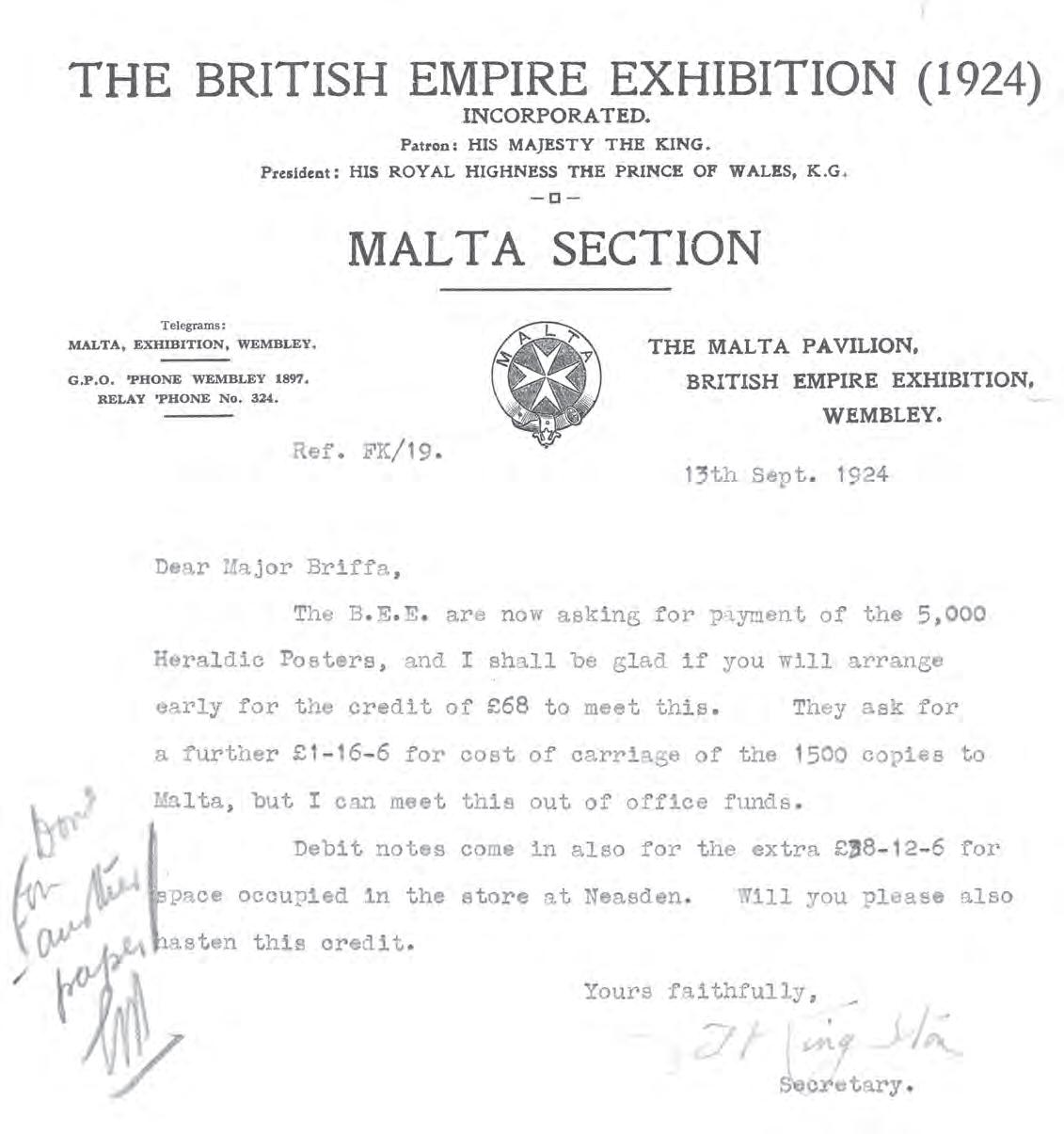ANNUAL REPORT 2023
NATIONAL ARCHIVES OF MALTA



NATIONAL ARCHIVES OF MALTA


Central Archive
Hospital Street, Rabat RBT 1043
Tel: (+356) 2602 3800
Opening Hours:
Mon, Tue, Wed, Fri: 08:00 – 14:00
Thu: 10:00 – 14:00, 15:00 – 19:30
Sat: 08:15 – 12:45
Gozo Archive
Vajrinġa Street, Victoria VCT 1313
Tel: (+356) 2155 8833
Opening Hours:
Mon ‑ Fri: 07:30 – 13:30
Wed: 14:00 – 18:00
Sat: 07:30 – 13:00
Courts and Tribunals Archive
Villegaignon Street, Mdina MDN 1193
Tel: (+356) 2145 9919
Opening Hours:
Mon: 08:00 – 14:00, 15:00 – 19:30
Tue, Wed, Fri: 08:00 – 14:00
Thu: 10:00 – 14:00
Notarial Registers Archive
St Paul Street, Valletta VLT 1313
Tel (+356) 2122 6152
Opening Hours:
Mon – Fri: 08:00 – 15:00
The Malta Study Centre Hill Museum and Manuscript Library www.hmml.org
The Archives Portal Europe www.archivesportaleurope.eu


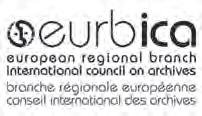
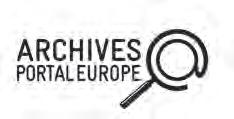
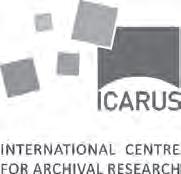
The National Archives of Malta nationalarchivesmalta nationalarchivesmalta arkivjinazzjonalimalta
A publication of The National Archives of Malta © The National Archives of Malta
Contributors: The staff of the National Archives, volunteers and members of the Friends of the National Archives
ISSN: 1997 6348
Design: Salesian Press ‑ Sliema Printing: Government Printing Press customercare.archives@gov.mt www.nationalarchives.gov.mt
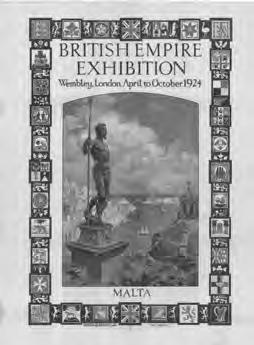
Cover. One hundred years ago, Malta participated in the British Empire Exhibition, known as the Wembley exhibition. Inaugurated in April 1924, it was intended as a showcase the British Empire’s might. A poster showing Neptune overlooking Ta’ Liesse and Grand Harbour was designed Edward Caruana Dingli for this event.
On Saturday 28 May 1994 the Rabat repository was inaugurated during a memorable event under the patronage of the President of Malta, H.E. Dr Ugo Mifsud Bonnici. It was a ceremony during which the music played by a small ensemble directed by the late Mro Joseph Vella marked the end of the centuries long medical service and ushered the start of the archival one within the building of Santo Spirito. This building became the head office of the National Archives following the opening of first repository in Mdina on 28 October 1988 and the inauguration of the Gozo archive on 24 November 1989. These landmark steps endowed the sector with the necessary infrastructure to pave the way for the enactment of the first National Archives Act in 1990.
Thirty years later I look back with nostalgia and great satisfaction.

When I entered the building 34 years ago, it was completely empty, not just without records but also empty of any equipment or furniture. During these three decades we have made the best of the building and developed a fully functional national archive, often praised by the thousands of researchers, visitors and virtual clients who make use of our services. I take this opportunity to thank my predecessor Joseph Caruana who had a vision for the sector, worked tirelessly and instilled in me a sense of duty and commitment. I also thank all those who worked with me in transforming this building into an active hub of archival activism.
“our repositories are full”
Last year had another innovative development. On 23 November we inaugurated the Notarial Registers Archive at St Paul’s Street in Valletta, now under the responsibility of the National Archives. The repository houses the register copies drawn up by Notaries spanning back to the fifteenth century and is managed on our behalf by the Notarial Archives Foundation in line with an agreement that we signed earlier in July.
This latest development means that the National Archives is now made up of seven repositories distributed throughout Malta and Gozo. Most of these are historical buildings that have intrinsic beauty and value which makes them extremely challenging to be fully converted to archives. This is the reason that during these last 15 years we were proactive to convince the powers that be that Malta needs a purpose built national archive that can cater for the extensive holdings it has and the ever growing flow of accessions from both the
public and the private sector.
Last year I explained our disappointment following the ‘Ta’ Qali’ site take over. Unfortunately, the situation is not yet resolved while another year has passed. I repeat that “the new national archives premises is crucial for our country’s soul, memory and identity.” Today I further emphasize the urgency. Why is it so difficult to acknowledge that an adequate infrastructure for the national archives is as crucial as are other sectors such as justice, education and the creative arts?
Our repositories are full and we are facing two options: either close our doors to further accessions creating a black hole for a period of our country’s history or hire space from the private sector. So far, we are choosing the second avenue, with all its burdens. Besides the impact on government expenditure, this means that these archival records cannot be fully cared for with efficiency and immediateness when it comes to archival description and delivery to our clients.
In Gozo we are demanding that the school space that will soon be vacated be allocated to Malta Libraries and the National Archives to resolve the problem for both entities at Triq il Vajrinġa. Over the last 20 years we have heard this promise several times and from different administrations. This promise was further strengthened through a Memorandum of Understanding signed on 16 March 2022. That day, the Ministers for Culture and Gozo and the respective Permanent Secretaries committed themselves to this way forward. Gozitans deserve to have National Library and National Archives sections that preserve the identity of the Gozitan people. I do hope that such commitments are honoured.
The same holds to Malta. A new national archive for Malta is not a luxury that we can do without. It is a basic need without which we cannot preserve our history and identity. We are indebted to the past generations and we owe it to the future ones. My assessment is that if this country does not develop a purpose built repository during the next decade, the progress we made during the last thirty years will vanish. We cannot keep on celebrating our wins with the acquisitions of new records without facing the stark reality that the National Archives will collapse if this dire situation is not tackled with urgency.
“A new national archive for Malta is not a luxury that we can do without. It is a basic need without which we cannot preserve our history and identity. We are indebted to the past generations and we owe it to the future ones.”
I do hope that while commemorating our 30 years operating from Santo Spirito, we receive a sign of hope that an alternative site has been identified for the new building so that we can continue with the plans we had developed.
Dr Charles J. Farrugia National Archivist and CEO

Driven by the National Archives’ mission, the Corporate Services Management Unit is a key enabler in the delivery of the entity’s strategic goals. As in previous years, by focusing on the delivery of quality services, innovation and capabilities development, in line with the challenges that the service requires, the Unit ensures that the needs of the entity’s stakeholders are met. This is coupled with the sensitive work on the general upkeep and improvement of historic facilities we operate from.
The main duties and responsibilities of this Unit are:
• The administration and human resources development
Recruitment of new employees and staff development are the responsibility of the Corporate Management Unit as is all HR related administration such as leave, staff records and roster planning. The Unit deals with the drafting, monitoring and execution of policies related to HR and administration and is also entrusted with the collating of reports and statistical data and the coordination of Parliamentary Questions’ replies. The administration of the Conservation Laboratory, the Maintenance and Cleaning units and the Reception Services fall directly under this Unit.
• Procurement
Another function of this Unit is procurement. Tender procedures for large purchases are undertaken by this Unit including all necessary market research and pre tender preparatory work. Other relatively small purchases require quotations for the goods or services to be obtained and the Unit has the task of ascertaining that the best quality is being obtained at the cheapest possible price.
• Works and Maintenance of Buildings
The Unit is responsible for the structural and assets’ monitoring and maintenance, pest control and further logistics of the premises comprising the National Archives. These are the Head Office at Santo Spirito in Rabat, the Banca Giuratale in Mdina, the Ospizio in Floriana, another store in Ħal Far, the central archives in Victoria, Gozo and a depository in Għarb Gozo.
Recruitment and movements
The year 2023 brought changes in the management structure of the National Archives with the addition of a much needed manager responsible for the overhaul of the IT infrastructure and all its operating sites. The National Archives of Malta issued an external vacancy call for a Manager IT and this post was successfully filled by the end of the year. The other external calls issued were those for the vacancies of a Conservator, an Executive Officer IT, and a Junior Conservator. These were all successfully filled except for that of Executive Officer IT. An internal call replacing a promoted Inspector of Records call was issued and successfully

filled. Due to an increase in workload demands three part time Assistant Archivists were elevated to full time employees.
The Gozo Section was augmented by an officer transferred on loan from the Ministry for the National Heritage, the Arts and Local Government to work on the ongoing digitisation project whilst another new officer was transferred on loan from the Local Councils department replacing an Archives Assistant who was released on grounds of public policy to work with a Voluntary Organisation.
Eight employees were transferred from the Notary to Government Department onto the National Archives of Malta and assigned on loan with the Notarial Archives Foundation to run the refurbished Notarial Registers Archive in Valletta. This transfer, namely that of two Palaeographers, three Conservators, one Archives Assistant and two Clerks, became effective as from July 2023.
An additional RSSL employee joined the entity to assist an Archivist and carry out general duties.
During 2023, the entity bid farewell to two employees, namely Junior Conservator Aurora Belli and IT assistant Jamie Zerafa.
Four new volunteers have joined the entity during 2023, bringing the number of volunteers working in various areas of the National Archives of Malta to forty five. An additional pharmacist volunteer joined the current pharmacist volunteer in maintaining the 18th century old hospital pharmacy, where an inventory exercise is being carried out concurrently with a review of the artefacts to be exhibited. Several guided tours for organised groups of visitors were conducted by both.
Besides attendance at various international meetings and conferences, National Archives of Malta staff attended a number of general and specialised training sessions on various aspects of the Public Service including procurement and financial training. Staff from the Conservation laboratory attended various courses dealing with time estimate management, 3D printing and cultural property protection activities through intelligent methods.
Inhouse knowledge training sessions were regularly held. These were devised to help spread the knowledge gained by a single employee amongst colleagues. This was done through various theoretical and practical training sessions held online and at the Archives’ premises. The Unit also supported one staff member undertaking a university course.
After months of negotiations, this Unit concluded a new Collective Agreement regulating relations between the management and the UHM – Voice of the Workers, the union representing the employees. This new agreement aims at providing industrial harmony and the best working conditions for the employees whilst securing the interests of the entity. The signing took place on 5th April 2023 between Dr Charles Farrugia as CEO of the National Archives and Mr Mario Sacco, Director of UHM.
Signing of the new collective agreement, 5 April 2023.
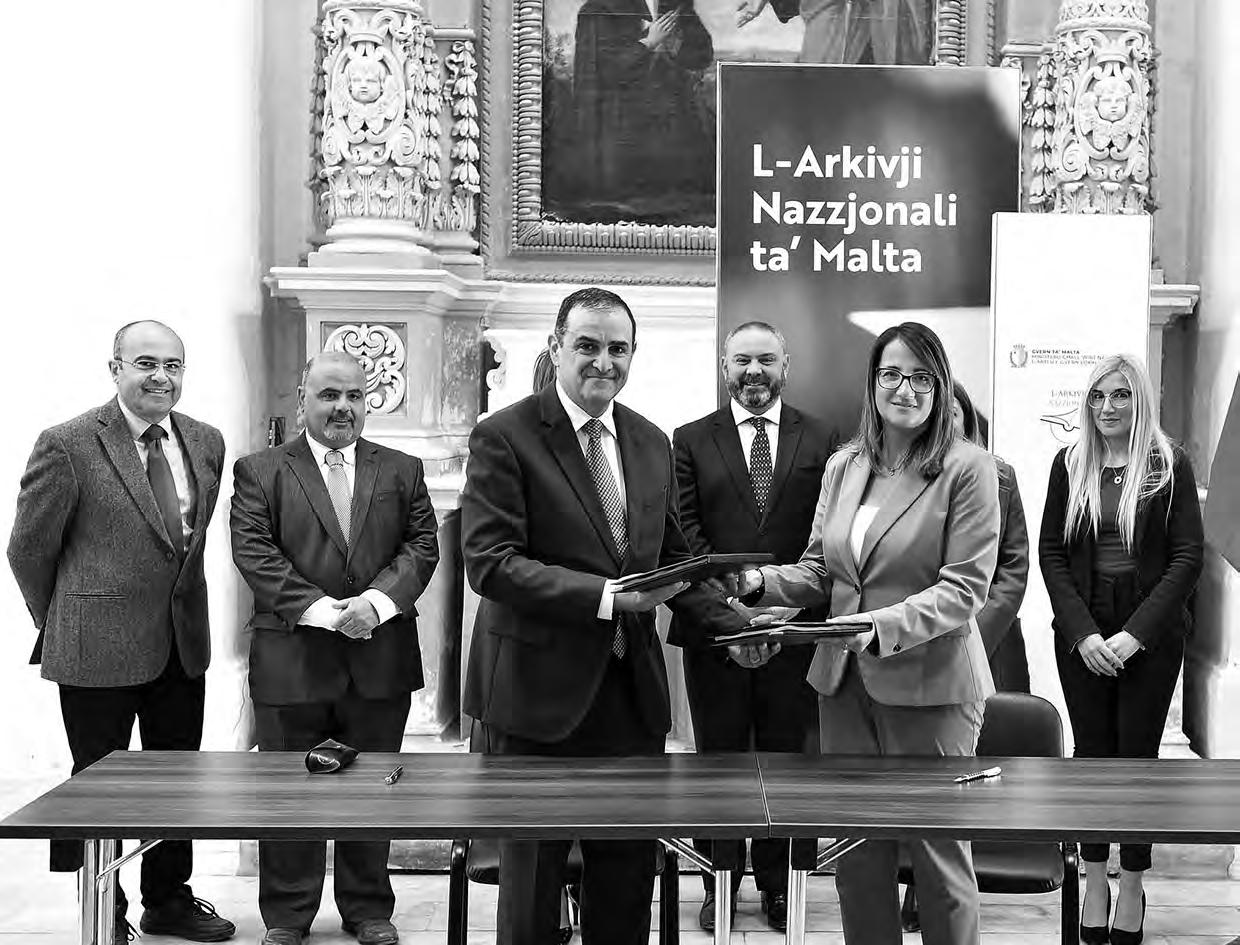
Weather proofing of the roof of the panoramic veranda of Santo Spirito was carried out by the Maintenance Unit which also carried out extensive work on the redecorating and repainting of the roofed veranda. Two unused staircases were transformed into two new stores for the Administration unit by the setting up of heavy duty shelving constructed by the Maintenance Unit whilst the same unit was also responsible for the refurbishment for the new Manager IT office. A new lighting system was also installed in the Reading Room.
The long overdue refurbishment needed in the staff mess was ably carried out by the Maintenance Unit and a new electrical installation was carried out. Heavy duty kitchen furniture and new apertures were procured and installed. The place was also provided with new storage facilities. New electrical supply installation was procured and installed for the Ospizio in Floriana. The chapel which serves as a conference hall was turned into an exhibition space to host the Giuseppe Galea Accession Exhibition in connection with the Open day held on 26th November 2023. At the Gozo Section, the maintenance unit took the task of repointing and repainting the façade housing the premises which was in dire need of refurbishment. Other minor refurbishment works were carried out at the Gozo Għarb Depository.
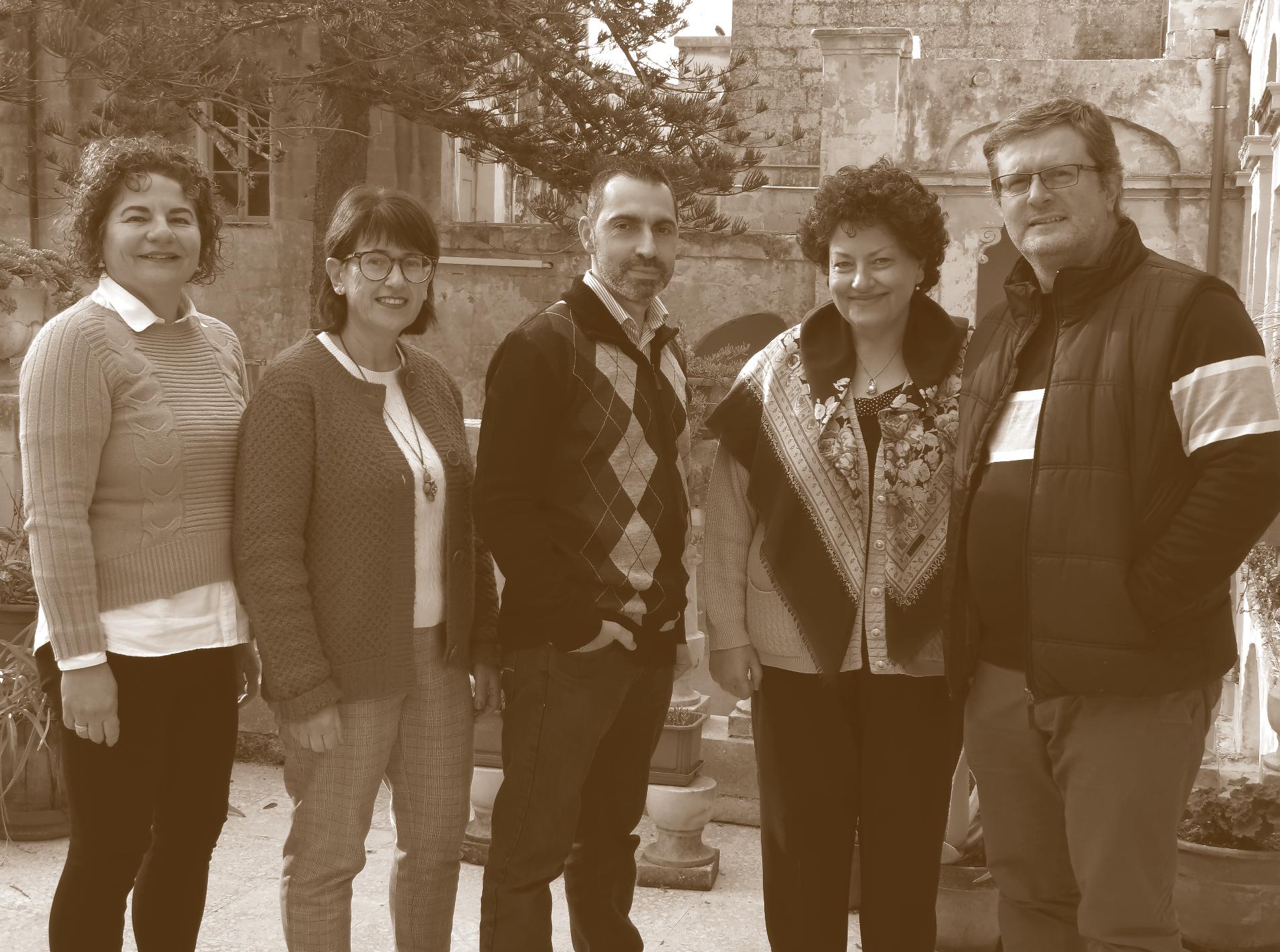
Structural works for this year also included the changing of one wooden beam holding the ceiling of a corridor at the second floor level and the walling of a concrete alcove suffering from structural damages due to beam erosion at ground floor level. Both these jobs had to be carried out with urgency as they posed danger to both employees and members of the public.
Pest control was again this year given further attention with the installation of additional pigeon roosting deterrents, anti termite treatment and the setting up of an additional number of bait stations. The yearly inspections and servicing of fire prevention and firefighting equipment was also carried out. To keep stone sculptured decorations free of dirt and emissions, nets to prevent doves and other pests from roosting in it’s baroque internal yard were installed at the Tribunal Section of the National Archives of Malta housed at the former Banca Giuratale in Mdina.


In 2023, the National Archives of Malta continued its unwavering reliance on Information Technology (IT) systems and infrastructure, recognizing their pivotal role in archiving, cataloguing records and supporting essential back-office applications. This commitment was underlined by a meticulous IT Audit, a comprehensive evaluation of our IT landscape. The assessment highlighted critical areas that demanded immediate attention and shed light on aspects requiring long-term strategic development.
As part of our commitment to fostering a technologically advanced environment, we embarked on a series of hardware upgrades. Legacy PCs and laptops were systematically replaced with high end counterparts, providing users with the tools they need to execute IT related tasks more efficiently. Monitors, too, underwent an upgrade, transitioning from smaller screens to larger ones, facilitating the handling of images and multimedia content.

The deployment of two high end workstations at NAVI and MEMORJA marked a significant step forward.
These workstations, equipped with powerful software tools that empower our teams to undertake photo, video and audio editing tasks with enhanced efficiency.
Recognising the evolving landscape of digital media, we procured various licenses, including Adobe Premiere, Adobe Photoshop and Adobe Auditon. These acquisitions significantly augment our capacity for media file editing and rendering, aligning our capabilities with industry standards.
A substantial effort was invested in upgrading our network infrastructure. We replaced various runs of UTP cabling throughout the entire building, providing new fixed points and several Wireless Access Points throughout our Rabat premises and Banca Giuratale Mdina. The extension of our Wifi network, featuring both MITA Govnet connectivity and a separate, independent network for direct AtoM server access as well as operational and private guest connectivity, is poised to enhance high speed connectivity across our entire building for all user, operational and guest requirements.
A meticulous reorganisation of our network cabinet and the implementation of new and upgraded network switches were integral to the improvement process.
Phase one of the network cabinet reorganisation involved the elimination of various network hubs, consolidation of UTP cables into the new switches and the replacement and rerouting of all patch cables. Additionally, the removal of leaking batteries from the PABX cabinet and the implementation of new cable management systems contributed to a more streamlined and efficient network infrastructure.
Phase two will witness the deployment of a larger network cabinet, incorporating active equipment for both telephony and data, along with the introduction of power bars connected to an Uninterruptible Power Supply Systems and new cable management.
Our commitment to accessibility was reflected in the extensive modifications made to the MEMORJA website. These changes were carefully designed to provide an improved and inclusive online experience for all users.
In the realm of system upgrades, a new architectural diagram was compiled for the AtoM servers. The weaknesses identified and assessed prompted various upgrades, ranging from firmware updates to reconfigurations and various license updates. The replacement and configuration of the old network switch connected to the AtoM servers marked a pivotal moment in fortifying our server infrastructure.
Servers located in Room 26 underwent substantial upgrades, including the addition of extra hard drives to amplify our storage capacity. The implementation of a new Microsoft Windows File Server License enabled secure bulk uploads and storage of various digital objects stored on external drives.
Concurrently, a strategic move was made towards modernising our storage solutions. The procurement of Microsoft Azure Storage from MITA allows all users to upload their bulky digital collections directly onto secure cloud storage. This marks a departure from reliance on local and external drives, providing a more robust and secure storage environment.
Our collaboration with Artefactual, developers of the Access to Memory (AtoM) system, was solidified through a new Service Level Agreement (SLA). This critical archival application necessitated the installation of a new Virtual Machine, migration of data to the latest AtoM version, introduction of new modules and functionality, bespoke modules and scripts and comprehensive user training. Artefactual’s support extends to the underlying Linux operating system, ensuring a comprehensive and robust support structure for this mission critical system.
To lead our newly formed IT Unit, we welcomed an experienced IT manager with a rich background at a senior level in an Information Management Unit within a major Ministry in the Public Service. This strategic appointment positions us well for future IT endeavours.
Discussions with MITA have been initiated to co locate server equipment at the National Archives of Malta Head Office to MITA Data Centres. This collaborative effort aims to provide a more secure hosting environment for our critical servers, ensuring they are hosted in a monitored and secure facility.
The Gozo Archive received a significant IT upgrade, including the delivery of new laptops. These laptops were equipped with VPNs, ensuring secure connectivity and access to MITA/ Microsoft Azure cloud storage for the secure storage of digital objects.
The National Archives of Malta’s IT Section looks back at 2023 as a year of substantial progress and modernisation. Our commitment to preserving historical records and embracing modern technology is evident in the various initiatives undertaken. As we move into the future, we remain dedicated to continuous improvement, ensuring the robustness and effectiveness of our IT infrastructure for the benefit of current and future generations.

Accessions at National Archives’ offsite repository.
The Records Management Unit (RMU) assists public entities, departments and ministries in fulfilling their records’ management obligations. Meetings and visits are organised to identify historical records and to plan their eventual transfer to the National Archives. The Unit also assists the entity/department/ministry with proper records management practices. Ultimately, an official retention policy, endorsed by the National Archives under the provisions of the National Archives Act, is developed.
As already indicated, assisting public offices in the management of records is one of the main functions of the Records Management Unit. During the year under review, a number of introductory meetings were held at the National Archives’ main office during which the legal obligations setout by the provisions of the National Archives Act were explained to the responsible officers. This was done so that our clients are informed better about the scope of collaboration with the National Archives. Following each meeting, the participants were also given a tour around all the main functions of the National Archives. In 2023 meetings were held with officers from the National Book Council, the National Audit Office, the Ministry for Active Ageing, various police stations, the Environment and Resources Authority, the Housing Authority and others.
Fifty two entities, both public and private, were supported by the Records Management Unit during 2023. These entities are listed below.
Public Offices supported by the Records Management Unit during 2023
Aġenzija Sapport
Commerce Department Copyright, Crafts and SOLVIT Unit
Environment & Resources Authority (ERA)
Festivals Malta
Foundation for Medical Services
Gozo Law Courts
Gozo Regional Development Authority
House of Representatives
Housing Authority
Identità
Institute for Public Service (IPS)
Jobsplus
Law Courts Government Notary Secret Wills
Local Tribunals
Malta Gaming Authority
Malta Police Force
Malta Statistics Authority and National Statistics Office
Malta Tax and Customs Administration (MFE)
Public Offices supported by the Records Management Unit during 2023
MEYR Human Resources for Non State Schools
MEYR Special Learning Difficulties Service (SpLD)
MFET Directorate for Consular Services and Maltese Living Abroad
MFET Directorate General Political
MFH Directorate for Environmental Health
MFH Directorate Pharmaceutical Affairs
MFH Karen Grech Hospital
MFH Mount Carmel Hospital
MFH People Management Division
Ministry for Active Ageing (MFAA)
Ministry for Education, Sport, Youth, Research & Innovation (MEYR)
Ministry for Foreign and European Affairs and Trade (MFET)
Ministry for Health (MFH)
Ministry for Justice (MFJ)
Ministry for Public Works and Planning (MPWP)
Ministry for Social Policy & Children’s Rights (MSPC)
MSPC Office of the Permanent Secretary
MSPC Office of the Permanent Secretary Adoptions Appeals Board
MSPC Office of the Permanent Secretary Fostering Board
MSPC Service Pension Records
National Book Council
Office of the Electoral Commission
Office of the Parliamentary Ombudsman
Office of the President of the Republic
Office of the Prime Minister (OPM)
Planning Authority
Public Service Commission
Superintendence of Cultural Heritage
The Energy & Water Agency (MEEE)
Transport Malta
The National Archives issues a letter of appraisal with regards to cases of dormant collections of records that are no longer required by the creating entity or in cases of emergency, stipulating whether the records must be preserved or not. During 2023, the National Archives issued these letters which helped entities to decongest their repositories. Reference
APL2023 01
APL2023 02
APL2023 03
APL2023 04
Superintendence of Cultural Heritage
Ministry for Health (MFH) People Management Division
MEYR Directorate for Educational Services
Superintendence of Cultural Heritage
Appraisal of Planning Consultation Records (1996 2014)
Appraisal of Employees’ Engagement Cards
Appraisal of School Transport Monthly School Reports
Appraisal of Planning Consultation Records (2010 2022)
When historical records are identified, the creating office is instructed on the way forward with the final aim of transferring these records to the National Archives. This includes sorting, finding the original order, cleaning (when necessary), placing into archival quality boxes and listing. In those cases where the records show traces of pest contamination, these are to be treated professionally under the supervision of the National Archives’ Conservators, before the transfer.
Retention policies for public records is a legal requirement under the provisions of the National Archives Act of 2005. In addition, the General Data Protection Regulation (GDPR) requires these instruments, and a momentum for retention policies by public institutions has been created since it came into force. As indicated in the following table, fifteen policies have been finalised during 2023, while a number of others are in the pipeline in view to be finalised during 2024.
Reference No. Entity Status
REP2023 01 MFET Directorate General Political Finalised
REP2023 02 MEYR Special Learning Difficulties Service (SpLD) Finalised
REP2023 03 MPWP Ministry for Public Works and Planning Finalised
REP2023 04 Office of the Parliamentary Ombudsman Finalised
REP2023 05 MFH People Management Division Finalised
REP2023 06 MFH Karin Grech Hospital Finalised
REP2023 07
REP2023 08
MSPC Office of the Permanent Secretary Adoptions Appeals Board Finalised
MSPC Office of the Permanent Secretary Fostering Board Finalised
REP2023 09 MFET Directorate for Consular Services and Maltese Living Abroad Finalised
REP2023 10 Commerce Department Copyright, Crafts and SOLVIT Unit Finalised
REP2023 11 MEYR Human Resources for Non State Schools Replaced by REP2023 15
REP2023 12 National Book Council Finalised
REP2023 13 MFH Directorate Pharmaceutical Affairs Finalised
REP2023 14 MSPC Service Pension Records Finalised
REP2023 15 MEYR Human Resources for Non State Schools Finalised

2023 was another successful year for records deposited or transferred to the National Archives’ repositories. One of the main reasons for this success was the implementation of retention policies through which historical records are being identified and transferred to the National Archives for permanent preservation. This was the case for the Malta Police Force, the Commerce Department and various Government Ministries. Apart from fulfilling its legal obligation in accessioning historical public records, the National Archives continued accessioning records through private deposits and records created under the umbrella of the MEMORJA project.
During the year under review, the Records Management Unit took the initiative of streamlining the accessioning process within the various sections/archives that fall under the umbrella of the National Archives. This process resulted into the migration of the accession register from an Access Database to the Access to Memory (AtoM) software and the incorporation of the all the accessions by the Gozo Archive and the Notarial Registers Archive into the National Archives of Malta main register. A Private Deposit Form was also established so that details
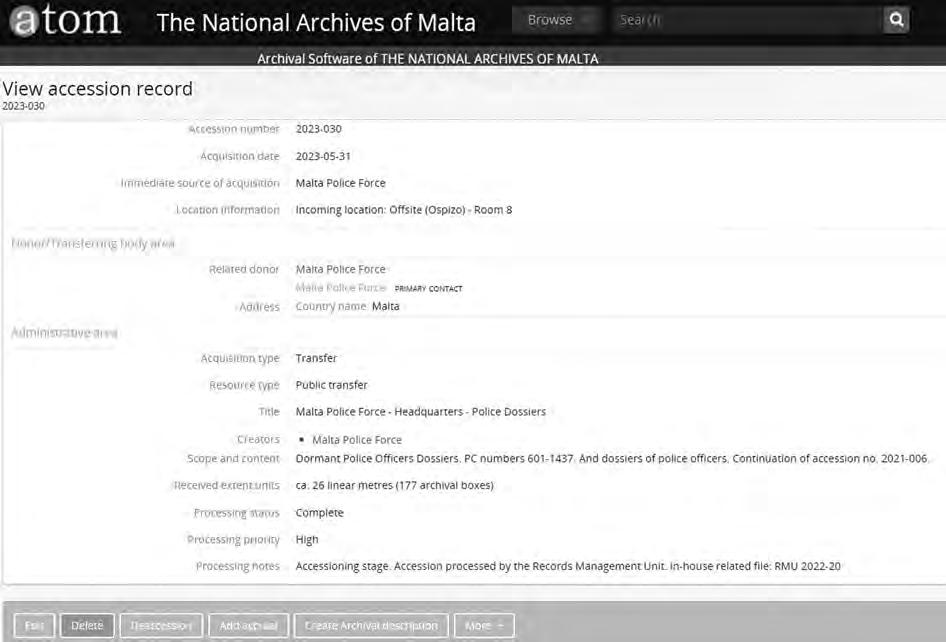
of accessions from private depositors are registered in a uniform way, including issues of intellectual property rights and access conditions.
Following is the list of accessions received by the National Archives during 2023.
Accession Ref Source & Description Extent
2023 001 Jobsplus: Appraised Human Resources Records. ca. 0.3 linear metres
2023 002
2023 003
2023 004
2023 005
2023 006
2023 007
2023 008
2023 009
2023 010
2023 011
2023 012
2023 013
Private Deposit by Bernardine Scicluna: Correspondence and local/foreign newspapers related to Malta Independence (1964). 1 folder
Private Deposit by Denis Darmanin: Personal Documentation. 1 folder
Private Deposit by the General Workers Union: Digital copy photographs taken during events such as the 1958 riots, and others during the early years of the GWU (1940s 1950s). 2.71 GB
Private Deposit by John Micallef: An unpublished reference guide to the Micallef Family. 1 booklet
Private Deposit by Max Farrugia: Funeral and memory cards. ca. 0.7 linear metres
Private Deposit by Max Farrugia: Material regarding the Maltese political scene and research on Mons. Dandria. 0.7 linear metres
Private Deposit by Capt. C.A. Strickland K.M. o.b.o. the KOMR Association: Handwritten Battalion Orders of the Royal Malta regiment of Militia, Dinner Menus of KOMR and Maltese Serving and ex Serving Officers (1889 1902). 1 linear metre
Private Deposit by the Von Brockdorff Family: The Lt.Col.Edward von Brockdorff Collection. 0.7 linear metres
Private Deposit by Tony Pace: Music scores and audio tracks composed and interpreted by Tony Pace. 535 MB and 1 booklet
Private Deposit by Michelle Bunyan: Digital copy of travelling document of Elia Sammut (1940). 1 MB
Private deposit by Francesca Zammit: 200 photos by Francesca Zammit showing amongst others family gatherings and portraits (1940s 1970s). 19.1 GB
Private deposit by Jeanne Roffe Vassallo: Digitised photographs of colonial Malta including WW 2 bomb sites and wreckage in various localities and other photos relayed to the Vassallo family (1870s 1970s). 3.96 GB
2023 014
2023 015
Private deposit by Simon Cusens: Raw TV footage of a one hour production titled ‘Convoy’ including tape transcripts and other Operation Pedestal/WW2 Malta media footage (1940 1942).
Material related to ‘Convoy’ (Channel 4, 1994):
1 arch lever file + 51 Betacam SP TV tapes + 42 VHS tapes + 2 mini DV tapes + 1 1.0mb PC diskette + 2 x Betacam SP (metal) large cassette tape + 1 master broadcast (MBR) cassette.
Material related to other pedestal/WWII Malta media: 2 mini DV tapes + 1 DVD + 1 SVHS tape + 1 VHS tape + 2 DVDs + 11 CDs
2023 016
Notary Joseph Tabone (NOTARIAL REGISTERS ARCHIVE NRA): Registers of Notarial Deeds and Indices dating back to the 19th and 20th Centuries from various notaries (1891 1986).
Lands Section Ministry for Gozo (GOZO ARCHIVE): Lands Section Plans & Maps of Government tenements, buildings and projects 1922 1990).
850 registers/ 172 boxes of bound notarial deeds and indices. Ca. 58 linear metres
241 plans & maps
2023 017
2023 018
Private Deposit by Lucy Hart (GOZO ARCHIVE): A number of photographic slides of Gozo and Malta taken by the late Mr Anthony Hart formerly Chief Architect in the Edinburgh City Architect Department, Scotland (1950s 1980s). ca. 359 slides
Private Deposit by Isabelle Camilleri: Records of the Boat & Ski Club collected by Joseph Bezzina (father of the depositor). Deposit includes photographs, exhibition charts, minute books and accounts (1960s).
ca. 0.2 linear metres (1 box)
2023 019 Ministry for Health (MFH): Appraised Human Resources Records. ca. 3 linear metres
2023 020
2023 021
2023 022
2023 023
Public Service Commission (PSC): Appraised PSC Records. ca. 3 linear metres (21 boxes)
Private Deposit by Barry Miller: A collection of digital surrogated of photos shot by Ernest William Thomas Miller during his posting in Malta (1951 1959). 763 MB
Private Deposit by Louis Borg Manchè: Photographic slides used for tourist brochures. ca. 200 items
Commerce Department: Industrial Property Directorate Expired Trademarks. ca. 70 linear metres
Accession Ref Source & Description
2023 024
2023 025
2023 026
2023 027
2023 028
2023 029
2023 030
2023 031
Private Deposit by Paul Edgar Micallef: The William and Carmelo Micallef Collection consisting of photographs, photographic albums and various records created by/ belonging to Architects William F. Micallef and Carmelo Micallef. ca. 2 linear metres
Notary Spiteri Maempel (NOTARIAL REGISTERS ARCHIVE NRA): Notarial deeds and indices of Notary Giocchino Frendo dating back to the 19th Century 1858 1883).
Private Deposit by Lawrence Ancilleri: Transcript of two interviews with Dr Ġuzè Cassar and George Agius and two publications (1935 1994).
14 linear metres (41 boxes)
2 publications, a hand written transcript, a typed transcript
Ministry for Public Works & Planning: Part of 1920s Public Works records collection (1923 1930). 6 files
Planning Authority: Alignment Record originally created by the Public Works Department (1936 1946). ca. 6 linear metres
Private Deposit Times of Malta: Second batch of photographic archive.
11 file drawer cabinets
Malta Police Force: Dormant Police Officers dossiers. PC numbers 601 1437 and dossiers of police officers. Continuation of accession number 2021 006 (1900s). ca. 26 linear metres
Private Deposit by Mariella Mamo: Photos of Sergeant Edward Briffa and cake for Coronation (ER II) banquet and letters of appreciation for services rendered on three separate occasions (1951 1954).
2023 032
2023 033
2023 034
2023 035
2023 036
Private Deposit by Matthew Vella: Marie Vella Collection consisting of two photo albums showing various localities and images in Malta, Italy and Turkey (Late 19th early 20th Century)
3.88 MB
2 albums containing 176 digitised sepia photos. Saved as .jpg and .tiff. Total: 11.5 GB
Malta Police Force: Recovery of Public Records originating from the Malta Police Force (1950s). ca. 50 loose sheets
Malta Police Force: Police Station Records St. Julian’s (1978 1996). ca. 20 linear metres
Żejtun Primary School B (MEYR): School Registers (1839 1969). ca. 1.5 linear metres
Office of the President of the Republic (OPR): OPR Registry files (1920 1990). ca. 6 linear metres
2023 037
2023 038
Private Deposit by George Azzopardi (GOZO ARCHIVE): Postcards, photographs and documents related to Gozo (1920 1990).
Malta Police Force Victoria Police Station (GOZO ARCHIVE): Map of Gozo hand coloured to show different police districts (1922).
15 postcards (PA/01/01), 22 photographs (PA/06/01), 2 documents ZM/01/816 817
1 plan 755mm x 1440mm
2023 039
2023 040
2023 041
Private Deposit by Mro. Dione Buhagiar: A collection of 39 musical scores of various Maltese and foreign composers. Mro. Buhagiar conducted most of these scores. Collection contains no original manuscripts (18th 20th Century) .
2023 042
2023 043
2023 044
2023 045
2023 046
2023 047
2023 048
39 music scores 3 metres of shelving
Migrants Commission: Emigration records including passport applications, departures lists etc. (ca. 1960s 1980s). ca. 15 linear metres
Ministry for Health (MFH): Parliament Questions (PQs) including question, answer and related information (1977 1981). ca. 3 linear metres
Private Deposit by Elizabeth Olivieri: The Victor Saliba Collection comprising family photographs and personal papers. Official documents including passports, certificates and priesthood related documents. Records related to the emigration of the Saliba (Saleeby) family to the USA (ca. 1920s 2000s).
Private Deposit by Richard Stedall (MEMORJA): The Mike Fenton Black & White Photograph Collection included in the Malta Bus Archive. A collection of original photographs and also a number of images copied (with permission) from other photographers (ca. 1970s 1990s).
Private Deposit by Dave Godley (MEMORJA): The Dave Godley Memorial Collection presented via The Westcountry Historic Omnibus & Transport Trust (WHOTT) and included in the Malta Bus Archive. Collection consists of photographs and postcards of buses, coaches and trucks (1985 1999).
Private Deposit by Malcolm Chase (MEMORJA): Malcolm Case Malta bus ticket collection included in the Malta Bus Archive. Collection consists of a mixture of used and unused paper bus tickets (ca. 1960s 2000s).
1 linear metre
4.2 GB
10 GB
8.1 GB
Private Deposit by George Azzopardi (GOZO ARCHIVE): Postcard and photos from Gozo (1950s 1960s). 3 items
Deposit by Vince Pulis: Malta Shipyards Records collected by Vince Pulis during his employment with the Malta Shipyards.
Private Deposit by Ann Marie Fenech (MEMORJA): Interview with Ms Fenech as part of the COVID 19 Pandemic Project. Ms Fenech speaks of her experience as a youth worker with the Secretariat for Catholic Education during the COVID 19 pandemic (2022).
2 linear metres
551.09 MB
Accession Ref Source & Description
2023 049
2023 050
Private Deposit by Maryann Gauci: The Victor J. Gauci Papers consisting of 10 folders and a copybook (manuscript with photos regarding Sliema). Folders cover areas related to Mr Gauci’s work as a public officer and diplomat for over 40 years working at the United Nations in New York and Geneva and as Malta’s Ambassador to China and High Commissioner in Australia. Mr Gauci concluded his career as Secretary at the Ministry for Foreign Affairs.
Private Deposit by Joseph Dingli (MEMORJA): Film reels showing footage of Mqabba and Essen and Mulheim in Germany (where Joseph Dingli was employed with NAAFI). Deposit includes 3 part interview with Mr Dingli (1940 2002).
11 Items
2023 051
Private Deposit by Mario Coleiro: Salvaged records from abandoned warehouse in St. Mark Street, Valletta. Includes private correspondence, receipts and other ephemera.
19 x 8mm films reels (between 20ft and 150ft) and audio recording
1 folder
2023 052
2023 053
2023 054
2023 055
2023 056
2023 057
2023 058
2023 059
2023 060
Private Deposit by the Galea Family: The Giuseppe Galea Collection consisting of 11 boxes of correspondence, photos, bio notes and material linked to Antonio Sciortino; artifacts, casts and original designs related to government buildings, political party, national activities and churches in Gozo.
Private Deposit by Carmel, Joseph, Paul and Victor Bonello: A report compiled by Salvatore Bonello (Dockmaster) following a visit to the Sembawang, Mitsubishi, Keppel and Keppel Tuas Shipyard (1980).
Private Deposit by Raymond Bonello: Various family photos (1890s 1970s).
11 boxes, 2 sets of artefacts and 109 designs. Digital 1,800 designs
1 folder
9 loose photos; 1 album (73 photos): 188 digitised items
Ministry of Gozo MGOZ (GOZO ARCHIVE): Personal files of MGOZ employees on attainment of 75 years of age (1970) 11 files
Notary to Government (NOTARIAL REGISTERS ARCHIVE NRA): Notary Register no. R175: Brandano Caxaro Vol. No.1. Includes Pietro Caxaro’s Kantilena (1533 1535).
1 volume
National Commission for the Promotion of Equality (NCPE) Appraised Human Resources Records. 1 file
Ministry for Education, Sport, Youth, Research and Innovation (MEYR): Appraised Human Resources Records.
Zebbug (Gozo) Primary School (GOZO ARCHIVE): Two attendance records and various correspondence (1970)
1 linear metre (8 boxes)
2 registers and 2 box files
Private Deposit by John Cremona (GOZO ARCHIVE): Colour photographic slides of Gozo (1970s 1980s) 117 slides.
Accession
2023 061
2023 062
Private Deposit by Jacqueline Formosa: The Jacqueline Formosa Collection includes a 1926 passport of Lawrence Grixti; a photographic album dated 26/11/1961 with the wedding photos of Alfred and Mary (parents of the depositor); a photographic album with various family photos.
1 passport and 2 photo albums
Private Deposit by Richard Cumbo: The Richard Cumbo Collection Photographs of the Maltese Community in Canada. 5 photographs
2023 063
2023 064
Private Deposit by Stephanie Maggi Pulis (MEMORJA): Interview with Ms Maggi Pulis as part of the COVID 19 Pandemic Project. Ms Maggi Pulis speaks of her experience as a teacher and Head of Department of Physics with the Secretariat for Catholic Education during the COVID 19 pandemic (2022).
Private Deposit by Vince Ellul: The Joseph Ellul Collection is a digital copy of the negatives including landscape, countryside, buildings, portraits of individuals and family members (1929 1970s).
881.06 MB
2023 065
2023 066
Ta’ Giordan Lighthouse (GOZO ARCHIVE): Plans, drawings, daily records and general correspondence originating from Ta’ Ġordan Lighthouse (1925 2018).
Private Deposit by Fr Charles Cini and Peter Apap Bologna (GOZO ARCHIVE): Correspondence, photographs, brochures and other information related to local and foreign artists with a Malta/Gozo connection.
105 GB
22 plans and drawings, 2 box files of daily reports, 1 box file of general correspondence
21 box files
2023 067
2023 068
Private Deposit by Joseph P Zammit: The Joseph P Zammit Collection of black and white photographs showing emigrants leaving Malta Airport on 19th March 1968 (1968).
Department of Industrial & Employee Relations Gozo (GOZO ARCHIVE): Registers pertaining to the Department of Labour and Emigration in Gozo (1950 1990).
14 photographs
2023 069
2023 070
64 volumes
Private Deposit by Loulou Mifsud Bonnici (MEMORJA): This deposit has 534 digital images showing daily scenes from depositor’s teenage years and adolescence, WWII era pictures and other family photos. 8.5 GB
Private Deposit by Doreen Curmi and Louise Zammit La Rosa: The Marich Family Collection containing records related to the V. Marich and Co. business which was located at 44, Strada Teatro, Valletta.
ca. 58 items
2023 071
2023 072
Private Deposit by George Azzopardi: One 1915 photograph of HMS London in the Grand Harbour; Two postcards Maglio Garden in Floriana and Entrance to Grand Harbour. 3 items
Private Deposit by Herbert Lenicker (MEMORJA): An interview with Profs. Lenicker covering his experiences during WWII, his experiences at the Santo Spirito Hospital and at the Lazzaretto and the 1977 Doctors’ strike (1920s 1970s)
2023 073
2023 074
2023 075
2023 076
2023 077
2023 078
2023 079
2023 080
2023 081
18 GB
Ministry for Health (MFH): An accession consisting of two categories of records; recruitment main files and tender files. ca. 4 liner metres (29 boxes)
Private Deposit by Angela Charles (MEMORJA): Interview with Ms Charles as part of the COVID 19 Pandemic Project. Ms Charles speaks of her experience as Head of the Curriculum Entitlement Department within the Secretariat for Catholic Education during the COVID 19 pandemic (2022). 885.25
Private Deposit by Jason Bonnici (MEMORJA): Interview with Dr Bonnici as part of the COVID 19 Pandemic Project. Dr Bonnici speaks of his experience as a family doctor during the COVID 19 pandemic (2022).
Private Deposit by Jeannine Connell (MEMORJA): Interview with Ms Connell as part of the COVID 19 Pandemic Project. Ms Connell speaks of her experience as someone who works in a woman’s clothing shop during the COVID 19 pandemic (2021).
Private Deposit by Lara Anne Borg (MEMORJA): Interview with Ms Borg as part of the COVID 19 Pandemic Project. Ms Borg speaks of her experience during the COVID 19 pandemic (2022).
Private Deposit by Marius Caruana (MEMORJA): Interview with Dr Caruana as part of the COVID 19 Pandemic Project. Dr Caruana speaks of his experience as a family doctor and his work with migrants during the COVID 19 pandemic (2023).
Private Deposit by Raymond Azzopardi (MEMORJA): Interview with Mr Azzopardi as part of the COVID 19 Pandemic Project. Dr Azzopardi speaks of his experience as an owner of a souvenir ship (Rabat) during the COVID 19 pandemic (2022).
National Book Council: Appraised records from the National Book Council including Council General Files, Book Prize, Konkors ta’ Letteratura Għaż Żgħażagħ, Malta International Book Fair and Malta Book Festival (1980 2016) ca. 2 linear metres
Private Deposit by Henry Cachia: Photo taken during filming of ‘Pulp’ in Malta in 1972. Includes actors and extras and distant view of Torri l Ahmar
34 MB
2023 082
2023 083
2023 084
Private Deposit by Louis Grech: The material consists of copies of a manuscript by Prof. Walter Ganado. Records are photocopies. 4 files
Private Deposit by Charles Meilaq: Broadcasted Audio Visual material including Pope’s visit to Malta, Ordinazzjoni Episkopali, religious activities in Valletta, Gensna.
2023 085
2023 086
2023 087
2023 088
2023 089
2023 090
2023 091
2023 092
32 tapes
Office of the Prime Minister (OPM Nationality): File No. 198/69 European Convention on the reduction of cases of multiple nationality and military obligations in cases of multiple nationality. 1 file
Private Deposit by Lawrence Ancilleri (MEMORJA): A number of interviews carried out by Lawrence Ancilleri with Sammy Meilaq covering the period 1940s 1980s. The interviews cover his childhood and adolescence, his work within socialist associations and his career at the Malta Drydocks.
Malta Tax and Customs Administration (MFE): 14 appraised personal files appraised under the provisions of the ‘Data Protection Public Administration Human Resources Corporate Procedures’ issued by the People & Standards Division (OPM) 1962 2012.
Private Deposit by Vince Pulis (MEMORJA): 6 cassettes with recordings of ‘Malta fiż Żmien il Gwerra’ presented by Charles Abela Mizzi including a detailed series of interviews with individuals who lived through events of WWII or researched them thoroughly 1940 1945.
Notary to Government (NOTARIAL REGISTERS ARCHIVE
NRA): Notary Register no. R1: Notary Antonio Abela Registers 1607 1629.
Notary to Government (NOTARIAL REGISTERS ARCHIVE
NRA): Notary Register no. R2: Notary Andrea Abela Registers 1727 1728.
Notary to Government (NOTARIAL REGISTERS ARCHIVE
NRA): Notary Register no. R3: Notary Giovanni Nicolo Abela Registers 1804 1825.
Private Deposit by Anne Cuschieri (MEMORJA): Three diaries donated by Anne Cuschieri as part of the COVID 19 Pandemic Project. The diaries provide insight into the author’s personal experiences and includes local and international news during the COVID 91 outbreak (2020 2023).
Private Deposit by Fabian Mangion (MEMORJA): One diary (digitised) donated by Fabian Mangion as part of the COVID 19 Pandemic Project. The diary covers the pandemic period and focuses on its effect on the locality of Senglea (2020 2022).
921MB
0.5 linear metres
382 MB
14 volumes
34 volumes
15 volumes
3 diaries
294 KB
Accession Ref Source & Description
2023 093
2023 094
2023 095
2023 096
Private Deposit by Veronica Galea: Cecil Satariano film Giuseppi. Three reel copies of the original film. 3 film reels
Private Deposit by George Azzopardi: Various records including food ration book, tourist class passenger ticket stub, a memorandum dated 25 June 1812. 3 items
Private Deposit by Anatole Baldacchino (MEMORJA): Interview conducted with Anatole Baldacchino covering his experiences as a Thalidomide survivor (2023). 6.87 MB
Acquisition National Archives of Malta : One volume Guljana covering baptisms in Cospicua (Bormla) between 1829 and 1901. 1 volume
2023 097
2023 098
Private Deposit by Joseph Mifsud: Emmanuel Mifsud Collection of 40 digital files containing traditional folk music (għana) by the doner’s late father Emmanuel Mifsud (December 1921 April 1983). Files include other singers and programmes originally broadcast on the Rediffusion. 1.57 GB
Private Deposit by John Charles de Montfort Cronin Digital surrogate of a Super8 Cine Camera footage of Malta, dated 1965 and 1966. 1.7 GB
Date Participants Entities represented Presenations
16 March 2023 11
Commerce Department, Ministry for Foreign and European Affairs (MFET), Environment and Resources Authority (ERA), Ministry for Social Policy and Children’s Rights (MSPC), Office of the Prime Minister (OPM), Planning Authority, Ministry for Public Works and Planning (MPWP), the Ministry for Education, Sport, Youth, Research and Innovation (MEYR), Superintendence Of Cultural Heritage (SCH).
Presentation 1
Speaker: Mr Matthew Pisani, Director (Industrial Property Reg.) at the Commerce Department.
Topic: Preservation of Industrial Property Wealth.
Presentation 2
Speaker: Mr Raymond Cremona, Senior Officer (Administration) at the Planning Authority.
Topic: Records Management at the Planning Authority.

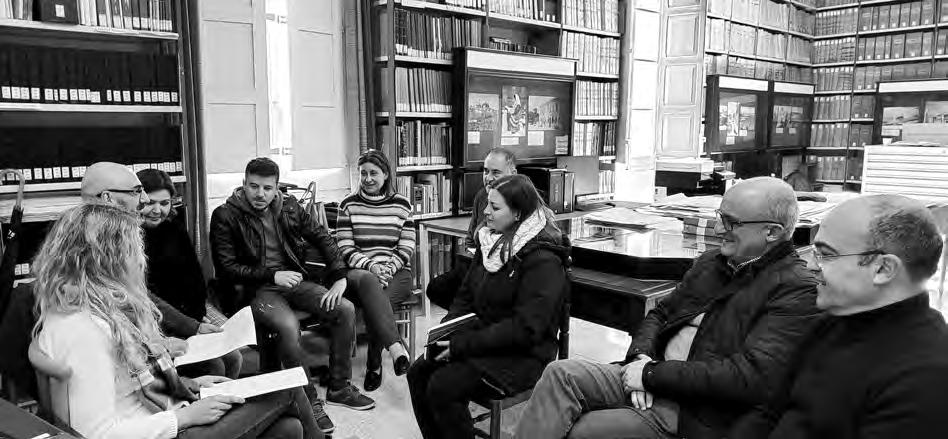
Meeting at the Gozo Archive on the streamlining of accessioning process.
Ministry Intraministerial meetings held
Ministry for Social Policy and Children’s Rights
of Retention Policies
• Department of Social Security
• Office of the Permanent Secretary
• Office of the Permanent Secretary_ Fostering Board
• Office of the Permanent Secretary_ Board of Appeals
awaiting approval
• Office of the Permanent Secretary_ Psychology Board
• Accounting and Procurement
• Directorate General (Political)
• Directorate for Consular Services and Maltese Living Abroad
Engagement Cards • Parliamentary Questions (Files 2023 041)
• Parliamentary Questions (Files 2023 041)
• Updated List of Personal Files and Filling of Posts from Other Depts (2023 019)
• Recruitment Main Files (2023 073)
• Tender Files 1997 1989 (2023 073)
Intraministerial meetings held
Ministry for Education, Sport, Youth, Research, & Innovation
for Public Works and Planning
3 finalised
• Special Learning Difficulties Service
• National Book Council
• Education Resources (Non State Schools, Personal Files & General Files)
Daily Transport Reports
• Żejtun Primary B (Admission & Attendance Registers; Logbooks)
• Ministry Registry (Personal Files)
• Ministry Registry (Personal Files_Non State Schools)
• Paola Primary (Admission Registers, Attendance Registers)
• Ministry Registry (Index Registers)
• Repairs in Stalls in Valletta Market (128 130)
• Report on Allowing Firework Factories
• Revision on Encroachment Fee, Ta’ Braxia Cemetery (WD/1125/1928)
Office of the Prime Minister Ministry for Energy, Enterprise and Sustainable Development
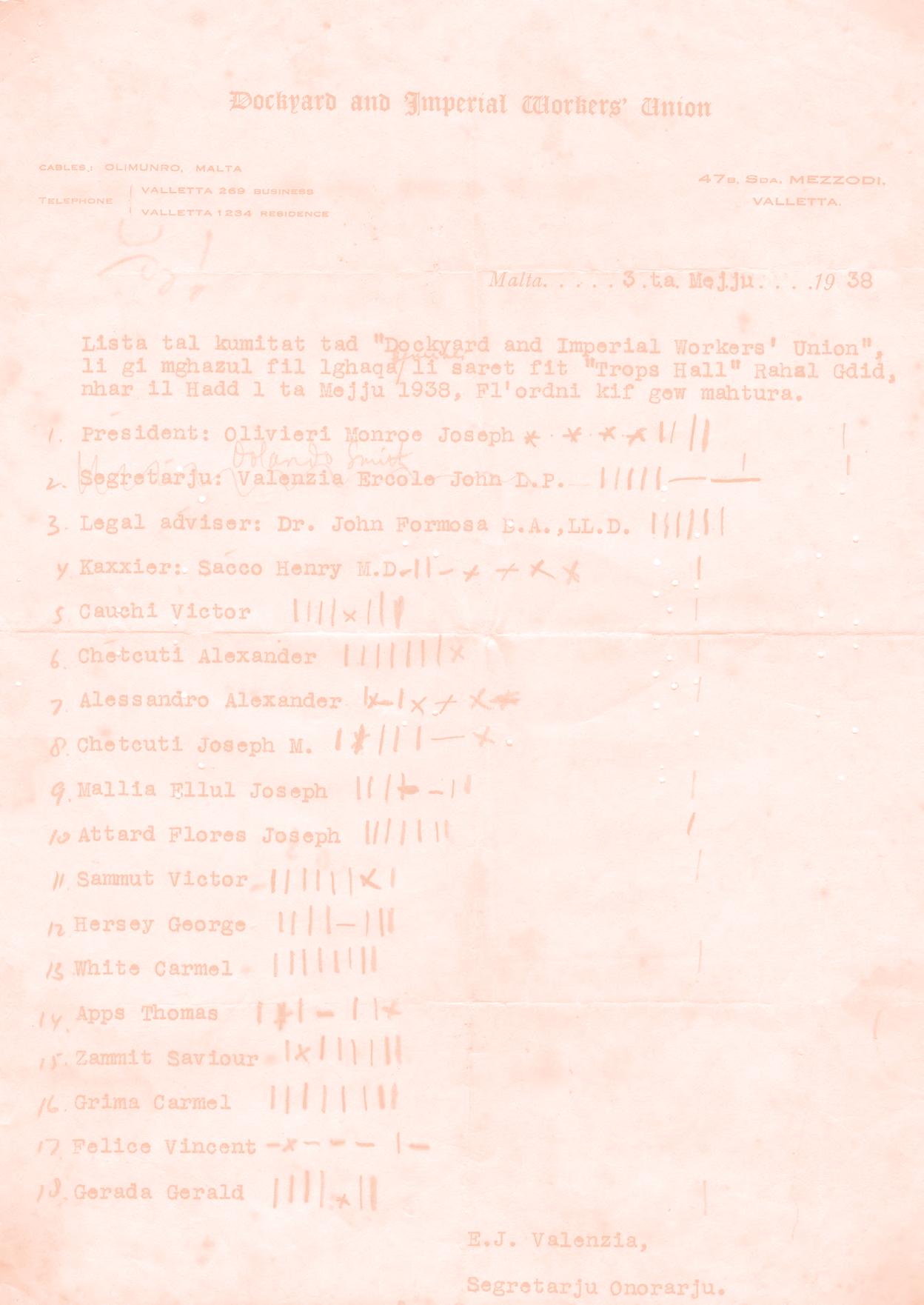
On 15 February 2023 Professor Henry Frendo donated a significant number of historical documents and other records related to his research into the history of Malta to the National Archives. These records include notes, interviews, research papers, photos and audio recordings mainly related to the history of Malta during the last 200 hundred years.
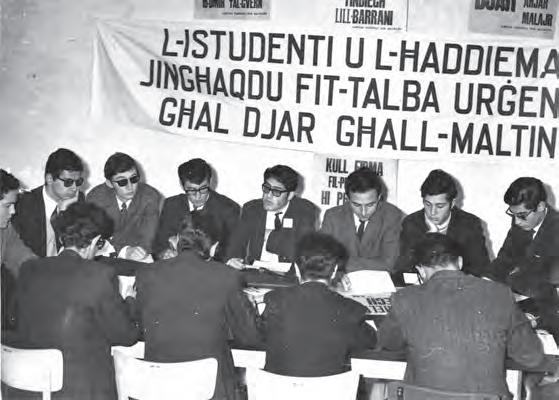
Prof Frendo is a professor of Modern History at the University of Malta. His main areas of research include imperialism, nationalism, decolonization, postcolonialism, journalism, migration and ethnicity in Central and Eastern Europe, the Mediterranean as well as the Middle East and North Africa.
Between 1968 and 1969 Frendo, as a university student, chaired ‘Djar għall Maltin’ (Houses for the Maltese), a student led campaign for low cost housing and land planning in the wake of Independence (1964). He was editor (1971 72) of Il Ħajja, a daily Maltese newspaper. During this period he researched and published about Manwel Dimech (1860 1921), a controversial Maltese social reformer, then largely forgotten.
He graduated with a Masters in History from the University of Malta in 1973. That same year Frendo became resident at University College at the University of Oxford, receiving his Doctor of Philosophy in Modern History in 1976. In his doctoral thesis, he wrote on the formation of political parties in Malta under British rule.

In 1978 Frendo accepted a position with the United Nations High Commissioner for Refugees (UNHCR) at their Headquarters in Geneva, after leaving the country following disagreements with the administration.
Returning to Malta in 1988, he was appointed Associate Professor of Modern History. In 1992 he became a full ranked Professor in Modern History at the University of Malta. In 1996 Frendo was elected a Life Member of Clare Hall at the University of Cambridge.
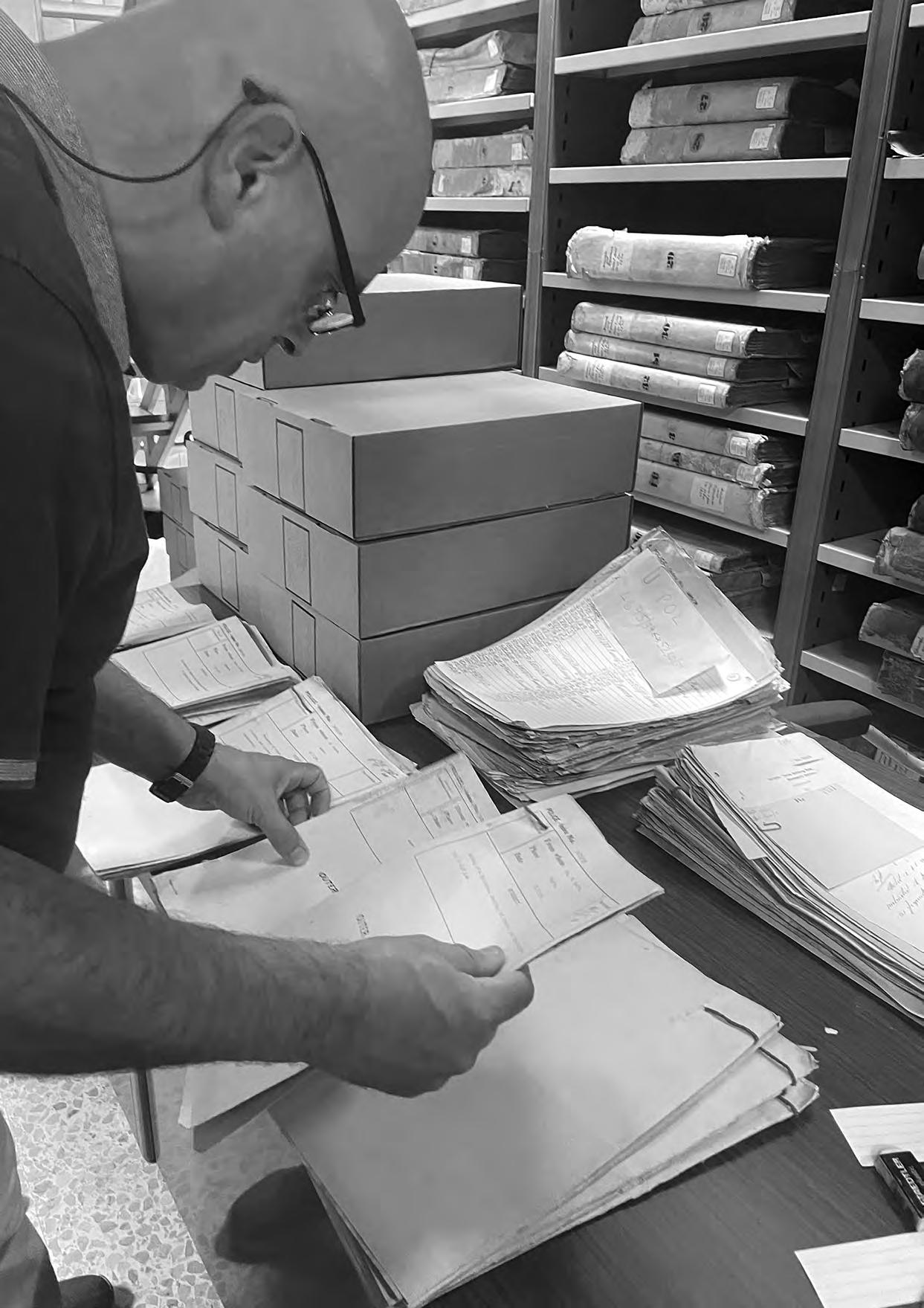
Sorting of records after their arrival at the National Archives.
The Archival Processing Unit ensures that following their transfer to the National Archives of Malta, records of national significance and enduring historical value are described, preserved and made accessible to all those who seek them.
In the middle of 2023, a new Archivist, Zvetlana Pace Cassar, was appointed at the Central Archive to fill a vacancy in the Unit created at the end of 2022. Thus, the work of this Unit recommenced with the aim of granting improved access to more of National Archives of Malta ’s archival holdings, not only in our reading rooms but also online.
Collections processed
Fonds/Subfonds
MPF 01 Cleaning, sorting, and re boxing
boxes EDU 02 Labelling of Boxes
CSG 02 Placing volumes in boxes
boxes
LEM Visa Removal of metal objects and cleaning 317 files
MIC Passport Office Removal of metal objects and cleaning 5100 files
We started processing the Malta Police Force files which were transferred from the Police Headquarters to the National Archives in 2014 (Accession 2014 024). There are about 20 linear metres of files which are to be cleaned, have metal inserts removed and to be sorted chronologically. The cleaned files are being put in archival quality boxes and labelled. So far about 4.5 linear metres of files have been cleaned, sorted and re boxed. Once this process is finalised, cataloguing will start which will eventually enable access for our researchers.
Fonds/Subfonds Entries Progress
CAD Querele
CSG 01 (1900)
CSG 01 (1913)
CSG 01 (1914)
CSG 01 (1915)
CSG 01 (1917)
On going
350 On going
On going
100 On going
030 On going
558 On going

Fonds/Subfonds
CSG 01 (1920) 1, 750 On going
CSG 01 (1946) 7, 587 On going
CMD 01 01 (Patents) 1, 112 Finalised
CMD 01 02 (Designs) 1, 002 Finalised
CMD 02 01 (Department of Trade) 11, 535 Finalised
LEM – Emigration dept. (1956 1966) 317 On going
MIG – Passport Office (1951 1852)
BN (1900 1906/1950 1952)
MIL Coll 3 and Coll 8
MFA 01 (1949 1950)
OPM 02
Law Courts Miscellaneous
ESC Emanuele Sciortino Collection
PDE_0037 Times of Malta Photographic Archive
PDE_0038 Perit André Zammit Collection
PDE_0045_002
100 On going
On going
450 On going
060 On going
Finalised
Paused
On going
200 On going
On going
Querele
These records were complaints made to the Court of Judiciary Police. While cataloguing these documents we were also trying to understand the context under which the law courts were functioning with the reforms brought by the first Governor, Sir Thomas Maitland, when Malta became a Crown Colony. These records are in Italian and palaeography skills to read and translate are an asset. So far 30 documents have been catalogued (including a summarised translation).
Marsha Iaci, a University of Malta student reading for a Master of Arts in Archives and Records Management, is assisting us on a voluntary basis to catalogue these records. The palaeography component within her course has given her the necessary skills to read these documents.
Although these records are already available for research, access has been restricted since no form of finding aid or catalogue was available. We are aiming to make these records more accessible by publishing the catalogue Marsha has been working on during 2024.
The CSG is one of our largest collections and so far over 100, 000 files have been catalogued starting from 1913 onwards. During 2023 we kick started the cataloguing of files from the year 1900. To do this, we are being assisted by Twanny Mifsud, another of our dedicated volunteers. So far 9 boxes have been catalogued which amounts to approximately 1,350 files. In addition, other volunteers (namely Raisa Zammit, Martin Hampton, Pauline Cassar, and Maria Elizabeth Azzopardi) and members of staff have been working on the CSG covering the dates 1913 1946. During 2023, 22,968 files (from the years 1913 1946) have been catalogued. As a result, the files in this collection are increasingly becoming more visible for our clients.
This year, the catalogue for this fonds was revamped to match the new cataloguing template established for National Archives of Malta following the International Standard for Archival Description General (ISAD (G)).
In recent years, the Records Management Unit was working with the Commerce Department to transfer records to National Archives of Malta . In 2020 and 2021 the lapsed Patents, the expired Designs and the Department of Trade files were transferred to National Archives of Malta sorted in archival quality boxes, labelled, and with a list of all the files. This enabled us to swiftly assemble a catalogue and make the records available for research. This catalogue will be updated every year to add new files which have surpassed 30 years since the date of creation and can thus be opened to the public.
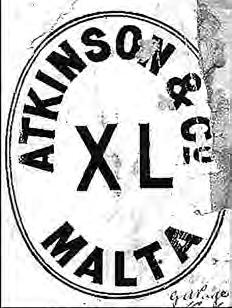
The Commerce Department consists of the Support Services Unit and three Directorates: the Industrial Property Registrations Directorate, the Trade Related Services and Projects Directorate and the Small Business and Crafts Directorate. For each unit or directorate, a subfond was created to include every record which falls under it. In addition, another subfond was created, entitled ‘Legacy First registered Trademark in Malta
Records’ which pertains to records which the Commerce Department inherited from other Government departments which were dissolved. One category of files which was transferred from the Commerce Department to National Archives of Malta were the files which used to belong to the Department of Trade, hence a sub subfond was created for these records.
Vanessa Buhagiar, a palaeographer and historian, was working on the catalogue of the Law Courts Miscellaneous Fonds. In 2023, 4 boxes were catalogued (249 items) which raised the total number of items catalogued in this fonds to 2,299. The progress on this collection has paused as Vanessa moved to the Notarial Registers Archive (NRA) which started operating again in the second half of 2023 following the rehabilitation project of the NRA building in St Paul and St Christopher Streets in Valletta.

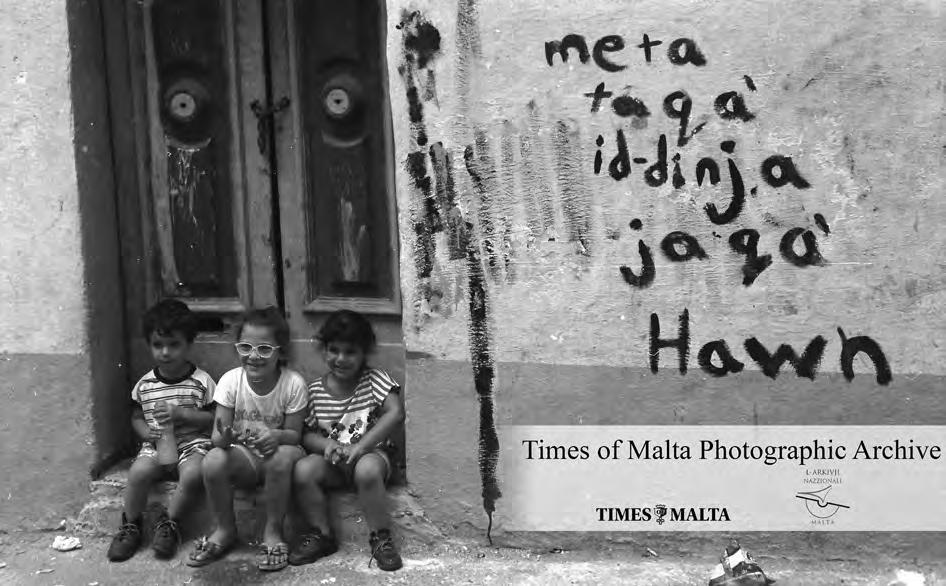
George Azzopardi has made several private deposits at the National Archives of Malta. His deposits vary in subject and medium, but we decided to dedicate one Private Deposit Number for all his deposits which will then have an individual sub subfond number. This year, the Archival Processing Unit has processed, catalogued and digitised 2 of his private deposits and 3 other private deposits were processed by the Audiovisual Unit. These are available for research by the public.
The Times of Malta Photographic Archive was accessioned by the National Archives of Malta in 2022. We immediately started to archivally process this photographic archive by cleaning and re boxing. Once digitisation, which is being carried out by the Audiovisual Unit, is completed, the photographs are undergoing a selection process whereby Mark Farrugia, the volunteer cataloguing the digital surrogates of the negatives, is choosing which photographs to catalogue since for each event there are multiple duplicates. They are then being catalogued on National Archives of Malta ’s online cataloguing software (including the digital object) and made available to the public. So far 3,200 photographs and newspaper cuttings have been catalogued and some of them have been published in our online catalogue.


In 2023, HMML’s Malta Study Center partnered with the National Archives of Malta to digitise the historical records of the two largest maritime tribunals established under the Order of Saint John of Jerusalem, the Tribunal Armamentorum (TAR) and the Consolato del Mare (CDM). The digitisation of these two fonds forms part of the Malta Maritime History Project, which began with the digitisation of the archival records, manuscripts, prints and drawings at the Malta Maritime Museum in 2020.
Digitisation of the Tribunal Armamentorum was completed in June 2023. 72 volumes from the fonds were digitised and made available with preliminary metadata on HMML’s online resource, vHMML.org. To publicize the project, Mr. Liam Gauci, Dr. Charles Farrugia, and Dr. Daniel Gullo hosted a public online event in June to discuss the importance of the collection for the study of Mediterranean maritime history and the legal implications of Maltese corsair activity on the history of Malta.
In preparation for digitizing the Consolato del Mare fonds, HMML’s Malta Study Center partnered with the National Archives of Malta, the Friends of the National Archives of Malta, and Department of Library Information and Archive Sciences at the University of Malta to sponsor the internship of Ms Claire Bugeja. Ms Bugeja created the
preliminary field metadata for the fonds as part of her master’s degree program at the University of Malta from 2021 to 2023. With the successful completion of her internship, the Malta Study Center began the digitisation of the Consolato del Mare in July 2023. 36 volumes of the Acta Originalia were digitised in the first six months of the project.
The digitisation studio at the Courts and Tribunals Archive (left) and records from the Tribunal Armamentorum (right). Images courtesy of HMML’s Malta Study Centre. Photography by Stephen Busuttil.


Digitised paper records:
PDE_0045_002 George Azzopardi Private Deposit 3
PDE_0045_005 George Azzopardi Private Deposit 6
Total 1,509
This year we did not embark on large digitisation projects of paper documents as the focus was shifted onto strengthening our digital infrastructure. The Archives Processing Unit worked closely with the IT Unit to find the best solutions, methods, software and hardware the National Archives of Malta staff needs to carry out its operations when it comes to digital or digitised records.
Digital data at the Archives is increasing exponentially, not only from the digitisation we carry out ourselves, but also from born digital records (of which the Archives is receiving about 1TB yearly) coming from the Public Service/Public Sector, and the public (as Private Deposits). This is raising the need for digital curation, more digital storage space and long term preservation solutions. Moreover, having a sturdy digital infrastructure will further enable us to share with researchers the digitsed material on our online catalogue together with the metadata and description.
In the meantime, collaboration with the HMML, Malta Study Centre has continued in 2023 and thousands of images of our archival holdings at the Law Courts and Tribunals Archive have been produced. In addition, our Maps Section has continued with the digitisation of our maps and drawings collection (see more below).
Catalogues
This year the Archives Processing Unit has taken initiatives to standardise and align the National Archives of Malta’s cataloging templates with international guidelines (such as the ISAD(G) by the International Council on Archives) and manuals. These new templates will also enable interoperability with other international archival systems and online catalogues, including our own. In fact, the National Archives of Malta plans to upload its standardised Excel catalogues onto its online cataloguing software (AtoM) to be able to facilitate online research for its customers.
Furthermore, the Archives Processing Unit has been working with the Notarial Registers Archive staff and the Notarial Archives Foundation to establish a cataloguing template for the collection that meets the needs of both the nature of the archival material and international standards.
Private Deposits are an increasing number of accessions registered at the National Archives of Malta after being deposited by members of the public. These vary from large personal/ family/corporate collections of photographs, correspondence, research and other records produced on a day to day activity to small amounts of miscellaneous ephemera. This year alone, 44 Private Deposits were accessioned by the Records Management Unit.
A few years ago, a new fonds was established at National Archives of Malta where it was agreed that all private deposits accessioned, are to be catalogued under this fonds: Private Deposits (PDE). Each private deposit is treated as a subfonds and when it is to be archivally processed it needs to be given a subfonds number. To keep track of the private deposits which have been given a subfonds number and are being processed, an excel sheet was created which records the PDE subfonds number, the title of the collection (could be given internally or stipulated in a contract), the accession number, the extent and medium, a description of the contents and remarks on the archival process.

PDE No. Subdfonds Collection Name Accession Number/s Extent and medium Scope and Content Archival Processing
PDE_0037 Times of Malta Photographic Collection
PDE_0038 Perit André Zammit
PDE_0044 Eddie Fenech Adami Collection
2022-034
PDE_0045 George Azzopardi Private Deposits
2021-034 CA. 800 notebooks
2019-017; 2020-068; 2021-025
2021008G; 2021009G; 2022-054; 2023-071; 2023-094
Box dedicated to all George Azzopardi accessions.
Photographs taken by Times of Malta and newspaper cuttings.
Notebooks covering the whole careers of several architects and civil engineers.
This collection includes copies of records during which the depositor (Eddie Fenech Adami) held the position of Prime Minister (1987-1996 and 1998-2004), and the one as President of the Republic (20042009).
2021 -009G (PDE_0045_001) = 10 photos (glass plate + negatives)
2022-054 (PDE_0045_002) = 1 paper document
2021-008G (PDE_0045_003) = 34 photos (containing aerial photography)
2023-071 (PDE_0045_004) = 2 postcards, 1 photographic print
2023-094 (PDE_0045_005) = 1 Food Ration Book, 1 Tourist Class Passenger Ticket Stub, 1 Memorandum
Cataloguing in progress on AtoM.
Cataloguing in progress on AtoM.
2019-017 is being catalogued on AtoM.
PDE_0045_001 was catalogued and digitised.
PDE_0045_002 was catalogued and digitised.
PDE_0045_003 was catalogued and digitised.
PDE_0045_005 was catalogued and digitised.
PDE_0045_004 was digitised. Catalogues and digital objects to be uploaded on AtoM.
Authority Records
During 2023, for the first time, the Archives Processing Unit has started creating National Archives of Malta ’s Authority Records. An Authority Record is the authorised form of name combined with other information elements that identify and describe a corporate body, person, or family and may also link to other related authority records. First off, a standard template following the International Standard Archival Authority Record for Corporate Bodies, Persons, and Families (ISAAR (CPF)) was created. The creation of Authority Records followed. Since most of the archival holdings at the Central Archive pertain to the British period, it seemed like a sensible place to start. In the meantime, we are actively gathering biographical information on creators of records accessioned by National Archives of Malta to ease Authority Records creation process.
All Authority Records are going to be uploaded on the National Archives of Malta’s online catalogue and eventually linked to records they are related to (as in mentioned and/or created).
National Archives of Malta Website
Towards the end of 2022, the National Archives of Malta was approached by the Information Management Unit (IMU) of the Ministry for the National Heritage, the Arts and Local Government (MHAL) for the creation of a new National Archives of Malta governmental website. Throughout 2023, a lot of work was done on the website, but more tasks are required before it could be finalised.
Digitisation Guidelines
Guidelines on the preparation, foliation and digitisation of archival records at the National Archives were established to serve as a guide during large digitisation projects which the National Archives of Malta has in store for the coming years.
Online Catalogue
The National Archives of Malta has been using the archival description software based on International Council on Archives (ICA) standards, ICA AtoM (Access to Memory), but the Archive’s catalogues and databases are still heavily based on Excel. Throughout this year, the Archives Processing Unit and the IT Unit have been working closely, which resulted in a signed contract with Artefactual Systems Inc. Artefactual are the software developers who will help the National Archives of Malta maintain the system and provide a better experience for researchers. In 2024, we will kick start this project with hopes of solidifying and populating National Archives of Malta’s online catalogue and training archival grade staff in utilising the software to its full potential.
In a bid to enrich her professional development, Zvetlana Pace Cassar attended a study unit at the University of Malta titled ‘Introduction to Archival Description’ offered by the Department of Library Information & Archive Sciences between February to June 2023.
E-RIHS.mt
E RIHS.mt is the Maltese node of the European Research Infrastructure for Heritage Science, E RIHS. The main aim of E RIHS.mt is to protect cultural heritage by seeking to facilitate the standardised connection of local heritage and heritage science communities to state of the art facilities and technologies across Europe through the four E RIHS access platforms: FIXLAB, MOLAB, ARCHLAB and DIGILAB. The National Archives of Malta has joined as a partner to the Maltese node. Zvetlana Pace Cassar is the representative on the Steering Committee for the National Node which was assembled this year.
During 2023, Map Room activity consisted mainly of the high resolution digitisation of large format plans and images from various collections and fonds such as the last batch of the Giuseppe Galea Collection that is made up of 2,205 images (drawings, plans and photos).
All images scanned in the Map Room have been uploaded onto the Microsoft Azure Storage (MITA). A total of 8.49 terabytes are now safely and securely backed up in a more secure storage system.
The projects that were digitised during this year include:
a) the last batch of the Giuseppe Galea Collection: 94 drawings and 45 photographs.
b) PBS Collection: 114 drawings.
c) Wignacourt Museum: 54 drawings and 4 Photographs.
d) Fortunato Mizzi Collection (FFEM): 400 Photographs.
e) Dom Mintoff Album: 122 Photographs.
Work on the database of digitised records, mainly from records created by the Ordnance Department, continued and is now included within the PDM Fond; these add up to 1,806 images.
Another 186 High resolution digitised images were undertaken for National Archives projects, including scans from various fonds such as LGO/PWD/OPM/Building Notices; minor repairs were also done to some plans.
Construction works at St Luke’s Hospital in Gwardamangia. Mintoff Collection.


This year brought about major changes in the Conservation Laboratory as some staff members left and new people came on board.
During the twelve-month period, the Conservation Laboratory updated internal forms, such as the notification form, the documentation templates for flat works and bindings and the short loan condition assessment. All inbound notifications for the year were listed in one Excel sheet for simple access and organisation. The written and photographic documentation of all conservation and preservation projects was prioritised to ensure a detailed record of information.
In these past few years, there was a drastic increase in the demand for the conservators services on short-term projects. The assistance of the conservators was requested for offsite inspections, short loans, external projects and at the Gozo Section. The Conservation Laboratory also supported four students throughout the year.
Conservation and Preventive Conservation: Work consisted mainly of conservation and preservation work on short term projects, few long term projects and conservation on new private deposits and donations. Detailed record of all projects was documented to gain a better insight on all the practical work carried out in the Conservation Laboratory. From a total of 151 notifications received, the conservators worked on one hundred and three projects, of which five are still ongoing. The duration of each project varies from minor conservation treatment to extensive treatments that would include creating complex custom made archival boxes.
Preventive conservation is predominant in an archival institution, as can be noted in the data highlighted in the chart. Most projects (47) involved preventive measures only. Conservators implement measures to prevent further deterioration to the archival material and work includes customising archival sleeves, folders or boxes and re housing. A total of 42 projects required both conservation and preservation while 14 projects required interventive conservation only.
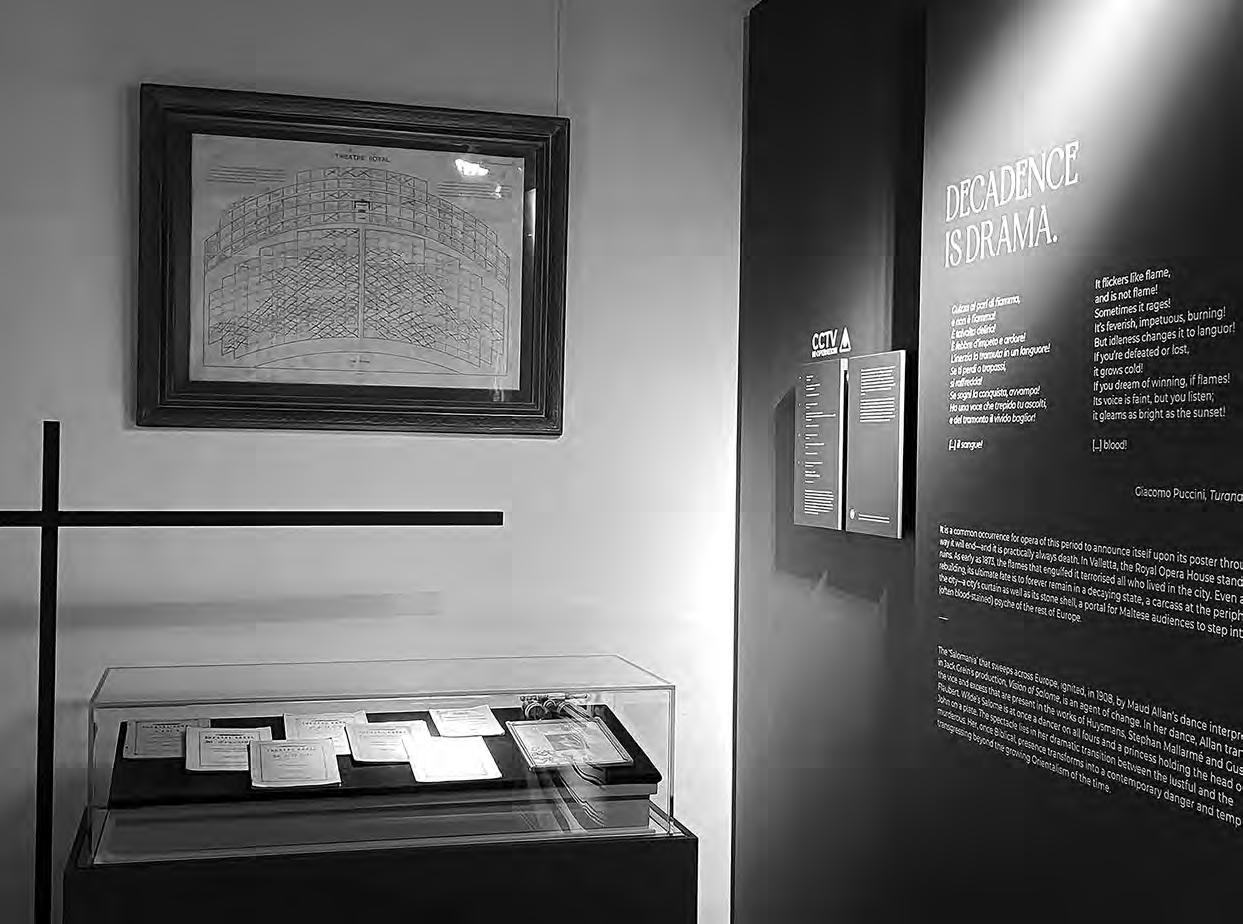
Amongst these works worth noting are;
• large map of Gozo (1922) showing Police districts deposited in the Gozo Section,
• handwritten handbook by Dr Salvatore Bardon for obstetricians/gynaecologists,
• conservation on plans for digitisation,
• archival housing for ether mask and syringes in brown box donated by Herbert Lenicker,
• rehousing for new accessions.
Conservation Reference Number (C.R.N): The conservators are notified of any conservation and preservation work through a system of notification forms that are then assigned a number (1/23, 2/23,..) which renews per year (1/24, 2/24,..). This year a total of 151 notification forms were sent by staff, which is an exponential increase from the 98 notifications received in the previous year.
To streamline the Laboratories’s record keeping one record form was adopted. This form now includes a damage report and the job sheet for the measures taken. Every project has its own folder with all the relevant information.
External Projects: This year the Conservation Laboratory supported three external projects, two of which are ongoing. These included preservation work on a digitisation project carried out by HMML, preservation and conservation work on secret wills found at the Courts of Justice and conservation work on volumes with inactive mould from the Identity Malta Public Registry.
All the projects required visits, reports, correspondence and meetings, and two of the projects required a formal notification process to acquire approval from the Superintendence of Cultural Heritage.
Inspections and Condition Reports: These included reports on the storage holdings at Mount Carmel Hospital, files of the War Damage Commission, preservation advice to the Malta Girl Guides in Floriana and a detailed report for Accession 2017 03 (Office of the President of the Republic).
Outreach: The Conservation Laboratory is an integral part of the outreach programme of the National Archives. Group visits have now returned to pre pandemic levels with the Laboratory catering for school visits, visits from University departments, staff visits and visits from other institutions and entities.
The conservation team was active replying to ‘customer care’ queries on social media and the local media. The team also contributed to National Archives of Malta stand at the Book Fair and to the Open Day held at the National Archives of Malta.
The conservation team hosted a workshop during a career day organised by the Library Information & Archive Sciences Department at the University of Malta.

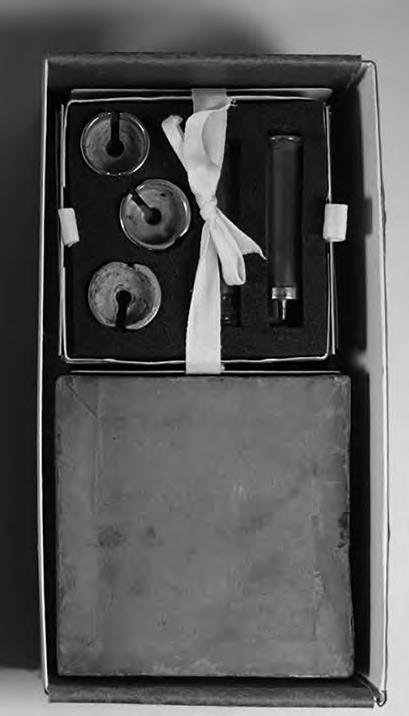

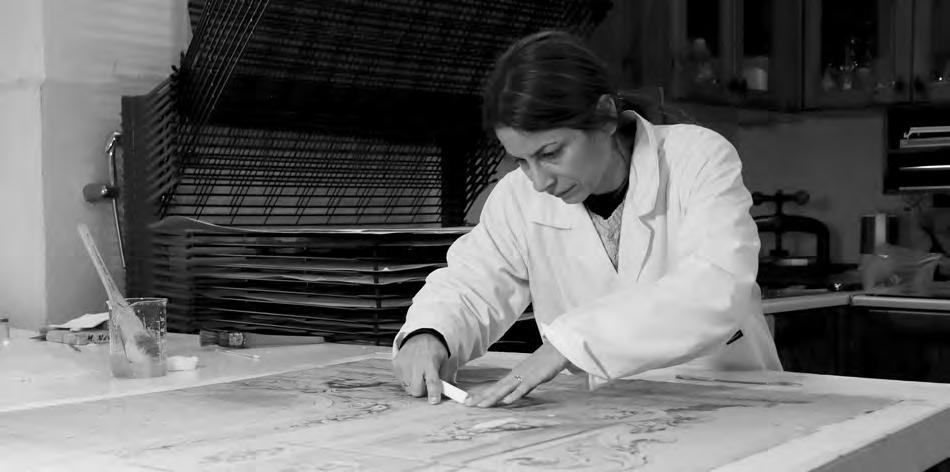
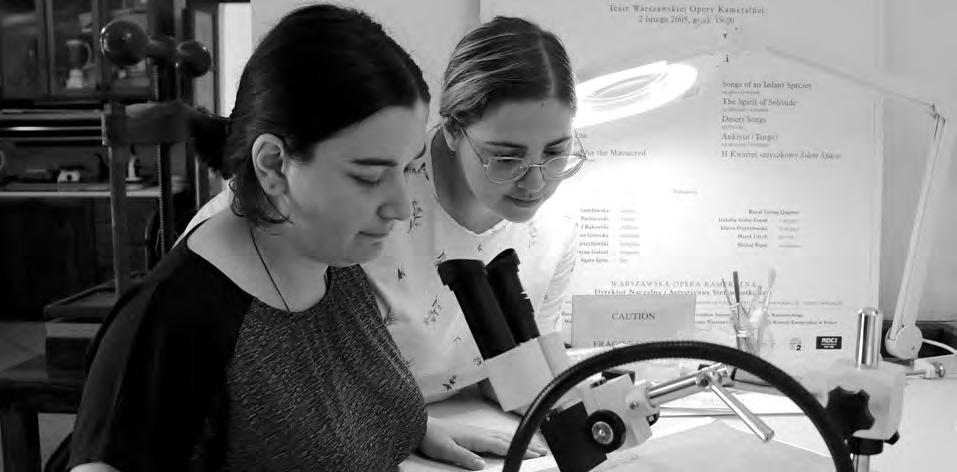
Emergency Planning: The team monitored the yearly maintenance of the fire extinguishers, along with updating the numbering, locations, detailed floor plans and creating labels for the fire extinguishers to be placed against the walls.
The conservation team worked hand in hand with various units of the National Archives of Malta , giving its support and advice to the NAVI section, Gozo section and the Notarial Registers Archive. It also advised volunteers on the handling of documents. The team was also involved when a document was requested, for a short loan, from the National Archives. The document, a seating chart for the Teatro Reale, including the revenue of an event dated to Sunday 20th May 1917, required a condition assessment report, minor conservation treatment, mounting, e mail correspondence and a visit to the exhibition site to ensure good handling, environmental control and light.
The Conservation Lab also hosted students for several placements. These included students from the Erasmus traineeship programme, the Jobsplus traineeship programme, MCAST students studying Cultural Heritage Skills (Level 4) and University students studying Conservation, Preservation and Holdings Management studies (Level 6).
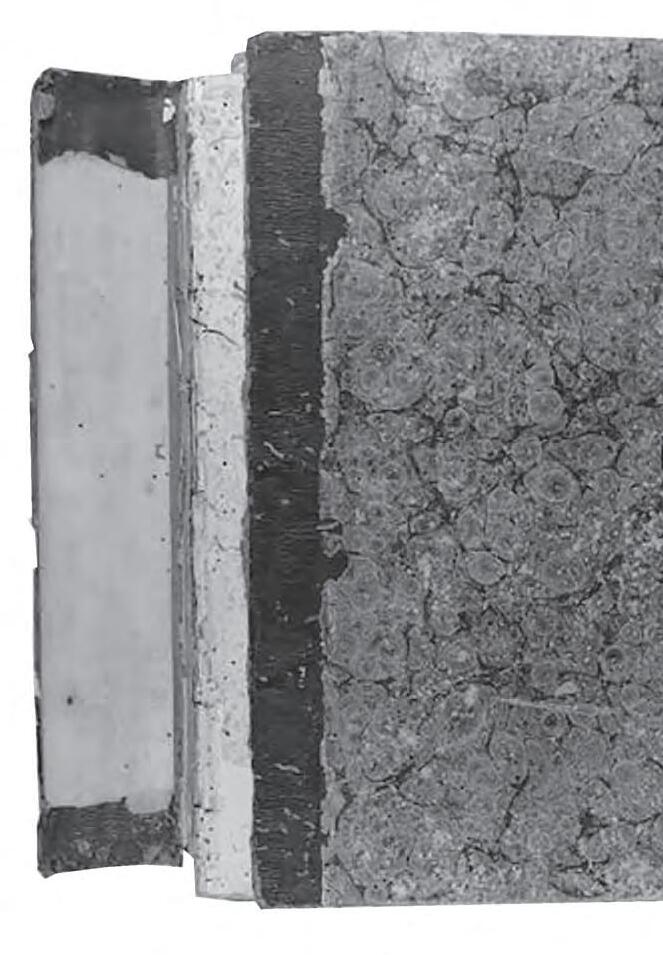


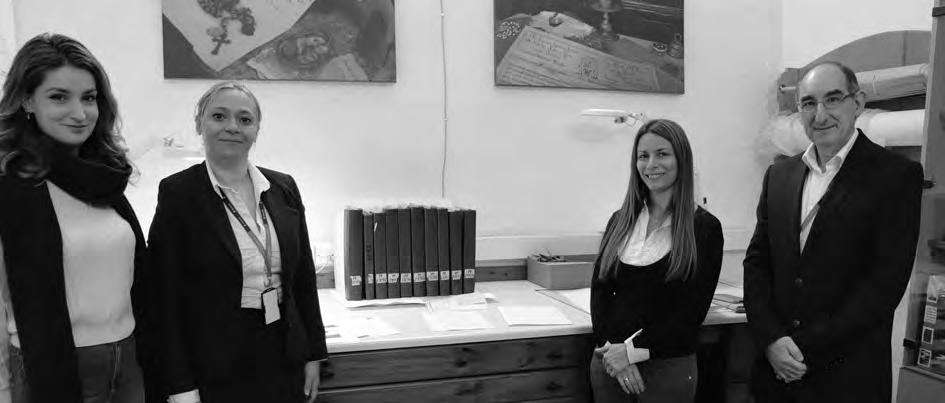

The Central Archive, within the National Archives of Malta, is made up mainly of records created or received by the administration of Malta since 1800.
During 2023 we have embarked on a project to modernise the infrastructure of the research facilities and finding aids at our Reading Room. The introduction of terminals for browsing through our increasing digital material particularly the Plans, Drawings and Maps Collection (PDM) and our photographic collections have been an important addition. Clients can now view in detail the high resolution images on large, touch-screen terminals.
The development of finding aids continued. The Archival Processing Unit’s commitment towards the creation of digital catalogues is a key factor in enhancing the research experience in terms of minimising the time spent on research and more importantly to give more accessibility to our records. Various new collections were added to our digital catalogues during 2023. Of particular interest are three series from the Department of Trade fonds: Patents, Designs and Departmental Correspondence. Together with the Economic Planning Division collection, which was opened for consultation in August 2023, the Department of Trade fonds, complemented the previously-available sources on the economic history of post-war Malta.
Perhaps, the most significant initiative that was undertaken in 2023 and which was aimed at delivering a better service, was the opening of those collections that are stored in offsite repositories for consultation. Clients requesting documents from these collections would be notified when the documents are delivered to the Central Archive, so they will be able to schedule an appointment for research. Within this initiative, launched in July, 123 documents have been brought to our Reading Room to be consulted, following a request by clients. This service has added new pressure on our staff which could have been avoided if the project of the new building materialised.
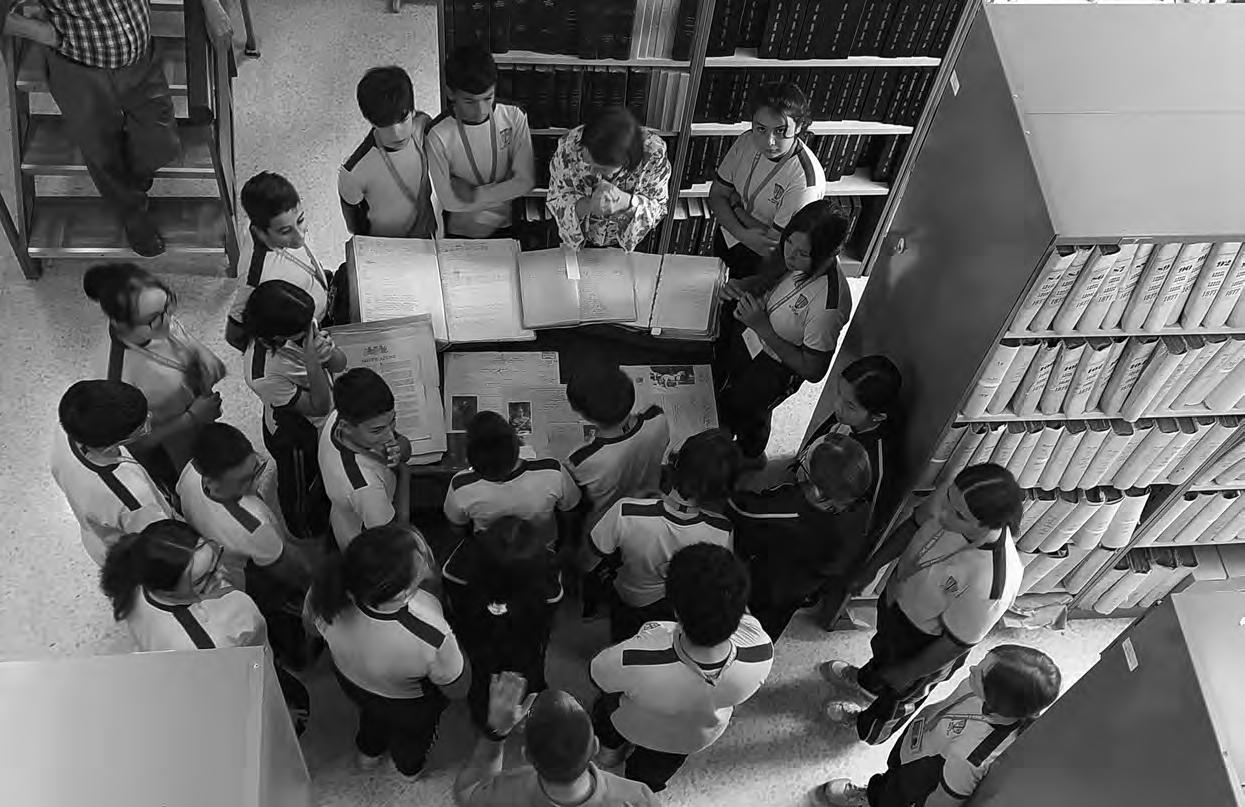
An increase in all of the activities carried out at our Central Archive was registered during 2023. Research sessions reached the pre Covid levels of 2019, which was at that time a record breaking year in terms of visitors, witnessing a sharp increase over the year 2022, with 210 more researchers. A correlated increase was also recorded in the hours spent on research.
Of the 1,662 research sessions carried out on site, 90 of them were carried out by foreigners. The majority of these researchers were persons residing in England, Australia, USA and France. These are countries that in the past had strong migratory connections with Malta. In fact, most of the research carried out by these foreign nationals was almost entirely family history research. In such instances, the collections that have been consulted were mainly the Passport Applications and Customs records. The main intention was to trace the relatives that migrated from Malta to these countries. Another aspect of research carried out by foreigners was to trace records of ancestors in a bid to apply for Maltese citizenship. In this case, apart from the above two collections, items from the Ġuljana Letard Ciantar collection were also frequently requested.
Foreign nationalities carrying research session at National Archives of Malta
10,500 items were requested in 2023, more than 2,000 items over those requested the previous year. When analysing these figures, one has to bear in mind the initiative undertaken in 2021 enabling clients to request the records in advance by doing so they can consult 15 documents instead of the normal allowance of 10 items per day.
However, the opening up of new collections and the ongoing process of cataloguing is allowing greater access to documents that has previously been more difficult to trace. A case in point is the 01 series in the Chief Secretary to Government collection, where more than 10,000 entries have been catalogued over the past four years. Here, more than 3,600 documents were requested by clients during 2023, an increase of more than 1,000 items over the previous year.
Throughout the year, all the traditionally popular collections – BNO (Building Notices), GLC (Ġuljana Letard Ciantar), MFA 01 (Passport Applications), OPM (Office of the Prime Ministers) and PWD (Public Works Department), saw a large amount of requests by researchers. An unexpected increase was registered in the GOV collection (correspondence between the Governors and the Secretary of State), where over 1,000 documents were consulted. The reason was a particular research that was carried out throughout the year by individuals focusing almost entirely on this collection.
Another group of records that are always in high demand are the Police Records (POL). Apart from the Police Occurrence Reports, which portray village and town life throughout the late 19th and 20th centuries focusing on crime and other social issues, the Trading Licences issued by the Police were particularly in demand. We had 40 requests for trading licences registers.
The customer care online channel has become an integral aspect of the Central Archive services. Communication with on site researchers often commences through an online request. Furthermore, the pre booking of documents initiative it has led to further increase of these requests.
The pattern which consecutively followed during the past years has been of a constant increase in the number of e mail requests, however this year and the previous one saw a marginal decrease in e mails received.
In 2023, we received a total of 1,387 e mails through our customer care service, which is very close to the number of those received during 2022.

The peak of e mails was received in January and October, with 146 and 142 e mails respectively. In fact, the e mails received in 2023 outnumbered those received in 2022 during these two months. On the other hand, April and June were the least productive months with regards to e mail requests, with less than 100 e mails received per month.
Upon examining the above data carefully, one may note that the e mail requests were higher in autumn and winter especially during the months of January, February and March, October, November and December. E mail requests were lesser during the spring and summer seasons, principally between April and September. The most plausible reason which might explain this is the school summer recess, considering that a large part of e mails received were requests for research by students in relation to educational projects, assignments or dissertations.
When comparing the numbers with those of 2022, another interesting factor that emerges is that April and September were the months in which we received the lesser number of e mails both during 2022 and 2023. E mails received this year were lower except for January, February, October and December.
As with previous years, family history research continued to be the most common area of interest amongst researchers’ queries, especially by foreigners wanting to find out the origins of their Maltese ancestors and relatives.
Requests for birth, marriage and death records were high, as well as requests for passport application records which continue to generate public interest. In fact, the Ġuljana Letard Ciantar and passport application collections were the most popular this year.
Plans, drawings and maps also continued to be highly demanded by researchers, mainly by MCAST and University students embarking in architecture and design courses.
Building permits and military personnel records were also commonly requested.
Overall, when comparing the combined requests, for the last few years, we can observe a slight but steady increase in our contact with the public. This year for the first time, we surpassed the 3,000 mark.
Our core service remains the assistance in research that we offer to clients. However, we are also responsible for other ancillary services, mainly the re production and copying of documents as requested by clients. Although, in recent years, we have introduced various policies whereby onsite researchers can choose from different options to digitise the documents themselves, the amount of online customers is still keeping these requests in high demand.

In terms of revenue generated from these services, the amount was €4,806.30. More than half of this proceeds was made through the requests from digital documents. With 4,905 images of documents digitised, the amount received was €2,452.50. This was followed by the requests for digital copies of large plans and maps, with the amount standing at €1,776.
Other services that are offered to the public are the certificates from the Passage Assistance Records (PAR) which stood at 14 requests, one more than the previous year. These certificates are requested by Maltese emigrants who for a time settled in Australia who have returned to Malta and are now applying for a pension from this country.
Finally, for those clients who reside in foreign countries and for those who are not able to visit the archives due to various reasons, we offer to carry out research on their behalf from various collections. This service is offered at a charge. This year 14 clients requested this service, one more the year 2022.
A total of 62, cultural and educational visits in 2023 were at an all time high! This surpasses last year’s total of 44 visits. In addition, the number of persons participating in such events is 846, which is more than double last year’s total of 377. This is a very positive outcome, especially when considering the COVID 19 pandemic’s effects in the years before and the resulting decrease in such visits.
Secondary and tertiary education visits were particularly popular. Amounting to 40, they make up more than half of the total number of visits carried out throughout the year. These include: University of Malta (e.g. Department of History) and MCAST (e.g. Book and Paper Heritage Skills) students pursuing various areas of study; and secondary school students, including History option students who are required to carry out their assignment from a selection of documents held at the National Archives of Malta. Additionally, this year we had the pleasure of welcoming a number of school student groups from other countres, such as Denmark, Tunisia and Germany.
As can be seen by the table, there were also numerous cultural visits by the general public. It is always very satisfactory for us to observe the enthusiasm and interest from the public to learn more about the National Archives, the history of the building and the material housed within it.
1 UoM, Diploma in Maltese History in context 14th January 2023
2 UoM, MA in Underwater archaeology 16th January 2023
3 St Paul’s Missionary College, Rabat Career Exposure 17th January 2023
4 Żejtun Secondary School Year 8 18th January 2023
5 Żejtun Secondary School Year 8 19th January 2023
6 UoM , BKIM 19th January 2023
7 Żejtun Secondary School Year 8 26th January 2023
8 Żejtun Secondary School Year 8 27th January 2023
9 Żejtun Secondary School Year 8 30th January 2023
10 Żejtun Secondary School Year 8 1st February 2023
11 Tarxien parish group 17th February 2023
12 Mosta Local Council group 23rd February 2023
13 Malta University Historical Society 23rd February 2023
14 Verdala Secondary, Bormla History Option 13th March 2023
15 BOV Attard branch staff 16th March 2023
16 UoM, MA Cultural and Tourism Development 27th March 2023
17 UoM, Department of History 4th April 2023
18 Professor Leniker and family 12th April 2023
19 St Benedict College, Kirkop History Option 19th April 2023
20 Planning Authority Documentation and Records Centre staff 20th April 2023
21 Serbian I.T. professionals 20th April 2023
22 Maria Regina College, Mosta History Option 24th April 2023
23 Ninu Cremona Secondary, Gozo History Option 26th April 2023
24 Danish Students Visit 28th April 2023
25 St Ignatius College, Qormi History Option 4th May 2023
26 St Theresa College, Mrieħel and National Sports School History Option 8th May 2023
27 Sixth Form Music Students 11th May 2023
28 St Tomas More College, Żejtun History Option 15th May 2023
29 San Ġorġ Preca College, Hamrun History Option 24th May 2023
30 Tunisia Djerba French Secondary School students 29th May 2023
31 St Catherine School Pembroke 30th May 2023
32 Luther College Students 31st May 2023
33 Cultural Visit Dr Louis Galea/Frank Mifsud 6th June 2023
34 Cultural Visit Frank Mifsud 30th June 2023
35 UK Pharmacists 3rd July 2023
36 Cultural private visit Frank Mifsud 12th July 2023
37 OPM Documentation Management Unit 18th July 2023
38 Ombudsman Department 27th July 2023
39 Franciscans Friars 16th August 2023
40 German history students 12th September 2023
41 Cultural private family visit 14th September 2023
42 State Archives Macedonia Ms Elisaveta Markovic 15th September 2023
43 Cultural Visit Australian and UK families 26th September 2023
44 Office of A.G. 11th October 2023
45 UoM law students 12th October 2023
46 Żejtun Secondary School Year 8 6th November 2023
47 MCAST, Diploma in Masonry Heritage Skills 7th November 2023
48 Żejtun Secondary School Year 8 8th November 2023
49 Żejtun Secondary School Year 8 10th November 2023
50 National Book Council 13th November 2023
51 Ancestry Directors 14th November 2023
52 Żejtun Secondary School Year 8 14th November 2023
53 UoM, Department of History students 15th November 2023
54 Żejtun Secondary School Year 8 16th November 2023
55 MHAL staff 20th November 2023
56 UoM, Department of History students 27th November 2023
57 UoM, MSc in Conservation of Decorative Architectural Surfaces 28th November 2023
58 MCAST, Book and Paper Heritage Skills 29th November 2923
59 MCAST, Third Age Community 30th November 2023
60 MCAST, Third Age Community 7th December 2023
61 UoM, Public Administration students 7th December 2023
62 St Martins College, Sixth Form 14th December 2023

“This summer I had the opportunity to host the daily afternoon Tv programme “Kumplimenti” on One Tv and since the National Archives of Malta is very close to my heart, my wish was to include a slot regarding this entity. It is very important that we continue to educate the general public about the importance of the function of the National Archives and the collective memory of the people of Malta and Gozo.
Therefore for 9 consecutive weeks starting off with the National Archivist Dr. Charles Farrugia, and followed by members of the various sections from the Head Office at Santo Spirito in Rabat, the Banca Giuratale in Mdina, the Notarial Archives in Valletta and the National Archives, Gozo, we discussed the work done in each section.
I am honored to say that our televiewers were very much interested in the subject and we were also contacted by various individuals to donate personal documents, photographs and visuals of importance, to continue enriching the various collections we already have so that these may be enjoyed by our nation.”



2023 marked an important year in our efforts to reach out to a greater audience and increase the awareness about the National Archives of Malta. Complementing our daily upload on our social media pages, this year we had a significant visibility campaign on other more conventional media platforms, mainly TV stations and radio broadcasts.
Apart from the occasional programmes that from time to time feature the National Archives of Malta, this year we had a strong presence in the media thanks to a fixed slot on the poplar afternoon show – Kumplimenti, broadcast on ONE TV and co hosted by our colleague Debbie Vella. On this programme we discussed the National Archives of Malta in general and the role of our various Units within.
Finally, in view of the Open Day that was held the 26th November, we had the opportunity to promote this event on different stations and media, mainly TV and radio shows. With seven media interventions at different times and at different stations, in just four days, we definitely managed to reach out to different people from all walks of life.
Erasmus Internship March–May 2023
Public Administration
University of Ludwigsburg, Germany
As a part of my studies, I had the opportunity to do one of the practical parts abroad. So, I spent three months at the National Archives of Malta. To work in an archive is not that typical for my studies, because of that it was interesting to see how a foreign authority in general and especially an archive is structured.
First, I would like to mention how friendly and helpful all employees of the archive are. This is a crucial part of how welcome you feel and how much you enjoy working there.
My main working fields were the digitisation - also including the necessary preparations like cleaning the dusty surface of some photos, the cataloguing and the labelling.
It was very impressive to see such old books, documents, maps, photos and in how good conditions most of them are. Because of age and being unique it is important to protect the materials or if necessary to restore them. That is as well one reason why it is important to have the materials digitised.
Furthermore, the digitisation and the cataloguing makes research much easier and faster and can be used online via the homepage and in the reading room.
If someone asks me for advice for an internship in Malta, I would definitely recommend the National Archives. For me it was a pleasure to be there.
Thank you for the great experience!
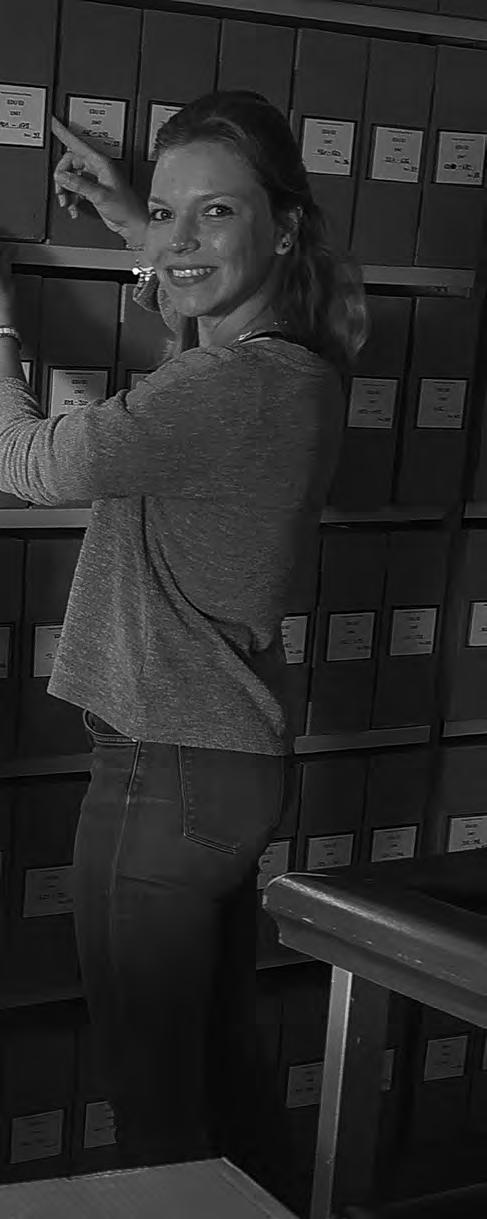
During 2023, we hosted 21 students following different placements from both local and foreign educational institutions. The tasks carried out by these students varied depending on their specialisation areas. However, the mains tasks that these students were given were cataloguing, digitisation, sorting and labelling of boxes and those whose area of specialisation was conservation worked under the supervision of our conservators.
These placements give us the opportunity to focus on particular projects, to which we were not able to allocate resources of our own. This year the main focus was the digitisation of the Times of Malta photographic material.


CHRISTIAN CAUCHI - SOK PROJECT

DARIUS FRANO ERASMUS PLACEMENT

FRANCESCA POLIDANO - SUMMER PLACEMENT

KATERINA ZRINYOVA - ERASMUS PLACEMENT
HANIEN WADI - SOK PROJECT


LAIMA LEPSEVICIUTE - ERASMUS PLACEMENT

MY DO NGOC - ERASMUS

RASA AUBRIZIEVE - ERASMUS PLACEMENT

VIT ZBRANEK - ERASMUS PLACEMENT

MAREN GERLINSKI ERASMUS PLACEMENT
MCAST Placement
July September 2023

During this past summer I had the opportunity to complete a Work Exposure Scheme at the National Archives of Malta. During this time, I worked within different sections of the Archives, namely the Conservation Laboratory where I carried out some works on the preservation of documents through preventative measures, the Banca Giuratale in Mdina, where I worked on digitisation and also assisted Archivists with cataloguing works.
Although I had known about the role of the Archives, working within different units allowed me to gain a comprehensive understanding of their individual roles which contribute towards its functioning as a whole.
This experience not only increased my appreciation for Archives and their efforts in preserving the collective history of the Island but has also provided me with skills which I will surely make use of in my future studies in History and Heritage Management.
Name and Surname Country Educational
1 Hanien Wadi Malta G.F. Abela Sixth Form, Malta SOK project
2 Maren Gerlinski Germany Karl Schiller Vocational School, Dortmund, Germany Erasmus
3 Vit Zbranek Czech Republic SoS Luhacovice, Czech Republic Erasmus
4 Katerina Zrinyova Czech Republic SoS Luhacovice, Czech Republic Erasmus
5 Michaela Enhle Germany University of Applied Sciences, Ludwisburg, Germany Erasmus
6 Samuel Chobot Slovakia Obchodna` Akademia, Nitra, Slovakia Erasmus
7 Darius Frano’ Slovakia Obchodna` Akademia, Nitra, Slovakia Erasmus
8 Emma Miskolciova Slovakia Obchodna` Akademia, Nitra, Slovakia Erasmus
9 My Do Ngor Slovakia Obchodna` Akademia, Nitra, Slovakia Erasmus
10 Francesca Polidano Malta Sacred Heart College, Malta Summer Internship
11 Eimante’ Vaicekausiene Lithuania
12 Andzelika Girdziutè Lithuania
13 Rasa Ambrieziene Lithuania
14 Laima Lepseviciute Lithuania
Vocational Training, Aukstadvaris Gymnasium, Lithuania Erasmus
Vocational Training, Aukstadvaris Gymnasium, Lithuania Erasmus
Vocational Training, Aukstadvaris Gymnasium, Lithuania Erasmus
Vocational Training, Aukstadvaris Gymnasium, Lithuania Erasmus
15 Jean Paul Galea Malta Savio College, Malta Summer Internship
16 Christian Cauchi Malta De La Salle, Sixth Form, Malta SOK project
17 Claudia Gabriela Alucai Romania Alexandru Iona Cuza University of Iasi, Romania Erasmus
18 Ana Maria Barzaghideanu Romania Alexandru Iona Cuza University of Iasi, Romania Erasmus
19 Raisa Zammit Malta MCAST, Malta Jobs Plus Internship
20 Keith Borg Malta MCAST, Malta MCAST Internship
21 Katrina Micallef Malta MCAST, Malta MCAST Internship


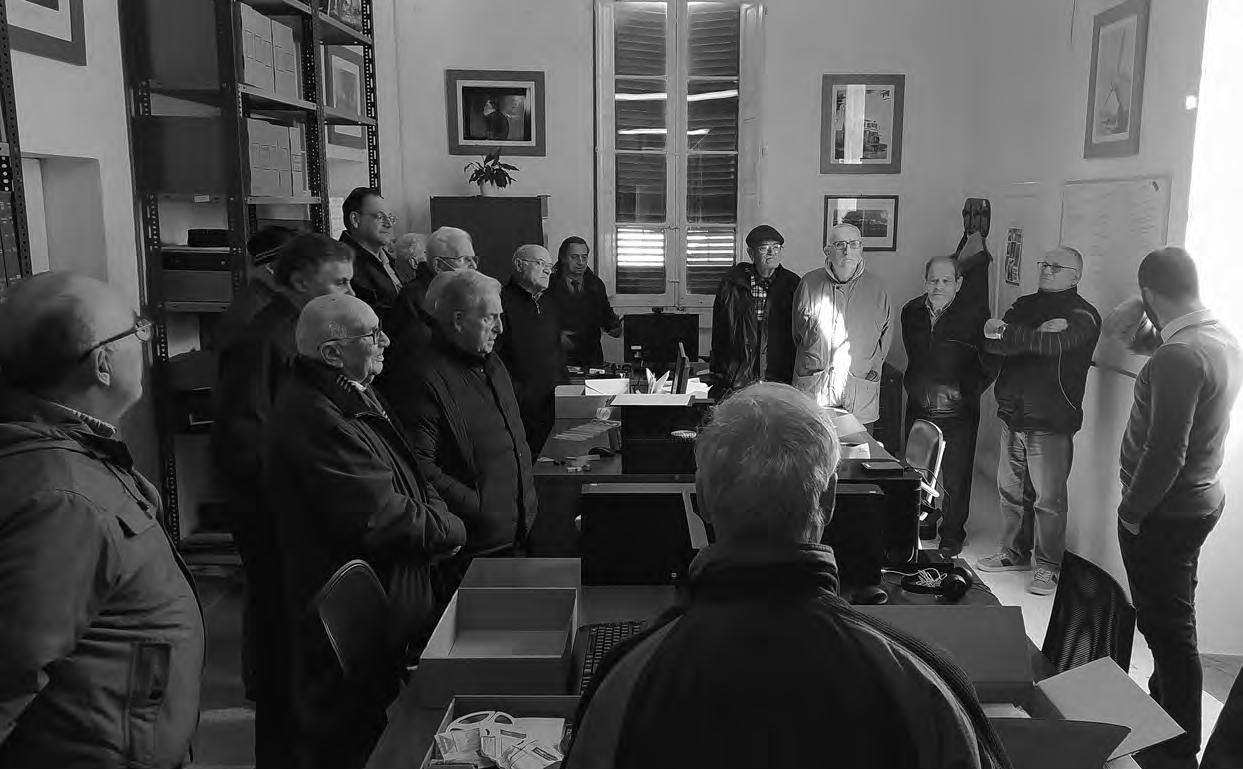
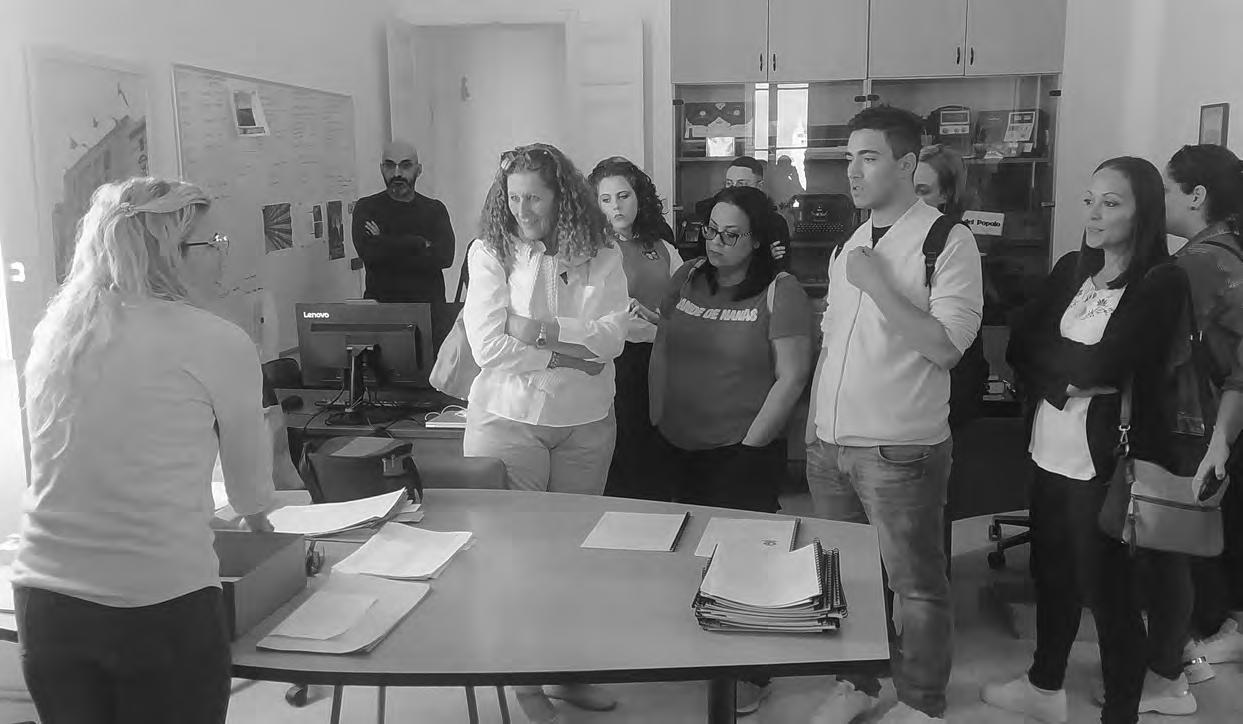
The National Heritage, the Arts and Local Government staff visit on the 20th November 2023.

The Wembley Exhibition, inaugurated one hundred years ago, was a showcase the British Empire’s might. All British domains and colonies were expected to be present with their own pavilion; of the 58 territories which made up the British Empire, only Gibraltar and Gambia failed to take part.
Malta was there.
The construction of the Malta Pavilion, covering 370 square metres, was entrusted to architect Joseph Cachia Caruana (1894 – 1981), winner of the competition for its design launched in June 1923. Cachia Caruana came from an old dynasty of reputable architects, and graduated in 1922, the first time the University established a degree in architecture and civil engineering.
He conceived the pavillion as a walled fortress, accessed through full scale replicas of the Mdina and Vittoriosa gates. The interior space included three large halls: one dedicated to Malta’s prehistory, another to the island under the knights and the third one to contemporary industry, trade and art.
Preparations for the Maltese pavillion had been going on in Malta for quite some time. Edward Tancred Agius (1849 – 1924) a veteran Maltese who had promoted Maltese interests in London since 1869, was appointed Malta’s Commissioner for the Exhibition. A preliminary exhibition was organised at the Auberge d’Italie under the chairmanship of Minister Ugo Mifsud, and the committee aimed at selecting those firms, products and works of art that would be sent to Wembley for the Exhibition.
The Malta Pavilion received widespread praise in the UK: “Malta is able to convey a lasting impression of the island through the delightful and artistic pavilion in which fifty centuries of its history are faithfully represented”.1Another popular paper described it as “one of the wonder shows of the exhibition”.2
1 The London Times, May 27, 1924.
2 The Sphere, July 19, 1924.


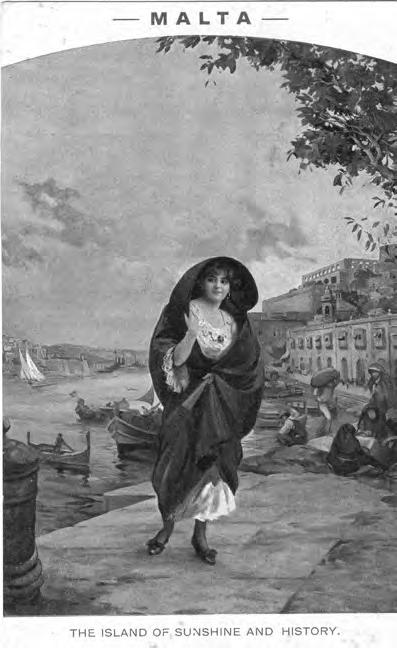
However, the British Catholic press remarked that the Exhibition and the Malta pavilion disregarded the Christian heritage.3 Hurriedly collected funds ensured that by the end of June a small chapel would stand on land across the Malta Pavilion, inaugurated and blessed by Cardinal Francis Bourne.
King George V inaugurated the Exhibition on April 23. Royalty and heads of state from all over the world had been invited. King George V, King Victor Emmanuel III of Italy, together with their consorts Queen Mary and Queen Elena from Montenegro, the Prime Minister of the U.K. and the Governor of Malta, Lord Plumer, visited the Malta Pavilion together on May 28.
The cream of local artists took part: from Edward Caruana Dingli (with a Salome) to Giuseppe Calì (with a Madonna and Child), Lazzaro Pisani (Death of Abel), Gianni Vella (Youth) and Ġużè Duca who entered a scene of Marsamxett harbour with a policeman booking a boy swimming starkers. Lord Plumer’s portrait, by Edward Caruana Dingli, was also on show at Wembley.
Robert Caruana Dingli painted large murals for the Prehistoric Hall. After sending them to Malta, Giuseppe Despott, the expert paleontologist, wanted some changes and the painter suggested Vincenzo Bonello should carry these out.4 These canvases now hang in the Għar Dalam museum.
The prehistoric section showed models of Neolithic temples, the ‘fat lady’ sculptures and a large profusion of ancient pottery.
Ramiro Calì executed the friezes round the Hall of the Knights of Malta, representing episodes from the history of the Order, and some of its buildings. He also authored a large allegory of Malta under British rule, now in the staircase of the Maritime Museum at Vittoriosa.
3 The Tablet, May 24, 1924
4 Bonello, op.cit., pp., 272 273, 319, 331. Images, p. 318, 339
Two postcards by Edward Caruana Dingli, commissioned by the Maltese government as souvenirs of the Wembley Exhibition. Both display the then Tourist Board’s slogan: Malta – the Island of Sunshine and History.
The organisers cluttered the Hall of the Knights with a huge medley of paintings, mirrors, wall clocks, furniture, arms and armour.
Many products from Malta lined the contemporary “Industrial Section” to stimulate orders and business opportunities. Cigarettes from the ATLAM factory, stone carvings, embroidery, pottery, wickerwork, filigree and wood products, together with edibles, such as honey, jams, oranges, grapes, wine, etc, and “attractive young women making Malta lace”.
The silversmith’s craft proudly displayed a model of the HMS Renown and one of Verdala Castle. The infant tourist industry also exploited the Pavilion as a showpiece and a promotion occasion.
The Malta exhibits, crated in 247 large boxes, were shipped to London by SS Aleppo on April 8.
The Maltese government commissioned Edward Caruana Dingli for the artwork of two postcards, as souvenirs of the Wembley Exhibition. One represents a Maltese lady in faldetta against a sunset on Grand Harbour; the other the close up of a country woman selling oranges against the Cottonera side of Grand Harbour. Both display the then Tourist Board’s slogan: Malta – the Island of Sunshine and History.
The prolific London postcard firm of Raphael Tuck & Sons Ltd published a set of 12 sepia photogravure cards, representing in detail the Malta Pavilion –externally and internally, together with views of Malta and a tourist collage.
Those not based on photographs reproduce sections of the frieze in the Hall of the Knights of Malta and are probably the work of Ramiro Calì, except for the last one, showing Neptune overlooking Ta’ Liesse and Grand Harbour by Edward Caruana Dingli. This was also used in full colour as a poster (see cover of this annual report).
The Exhibition, meant to close in November, turned out to be such a popular success that it had to be extended well into the following year. In all it welcomed some 17 million visitors, with peaks of up to 300,000 in one day.



The Wembley Exhibition



List of some of the items (armour, pharmacy jars, paintings and furniture from the Palace) taken to Wembley for the exhibition. National Archives of Malta /MW/136/1924.
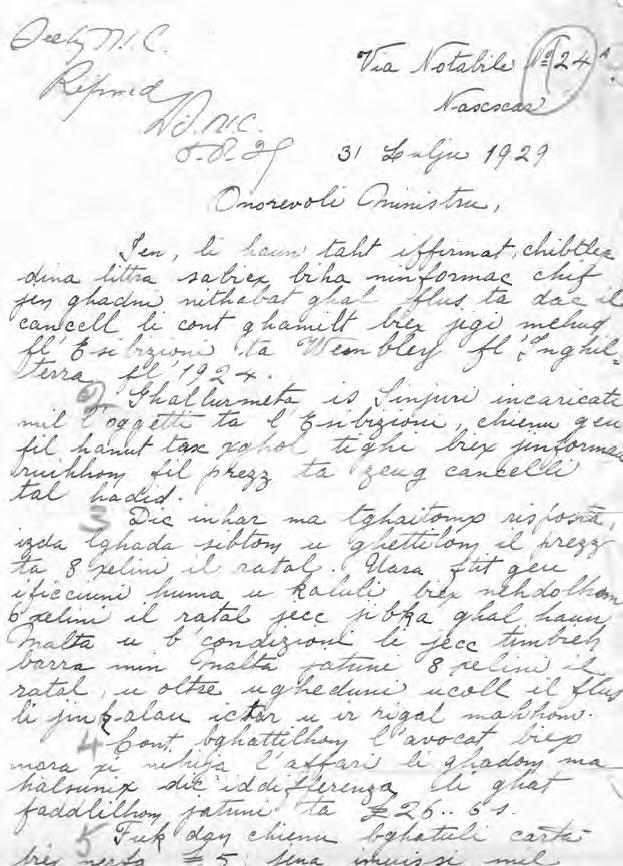
Some issues with exhibitors at the Malta pavilion lingered for a long time. A 1929 letter by Carmelo Calleja, a blacksmith from Naxxar, complaining that he was still owed money for an iron gate exhibited at the Empire Exhibition five years earlier. National Archives of Malta / HOM1/60/1926.
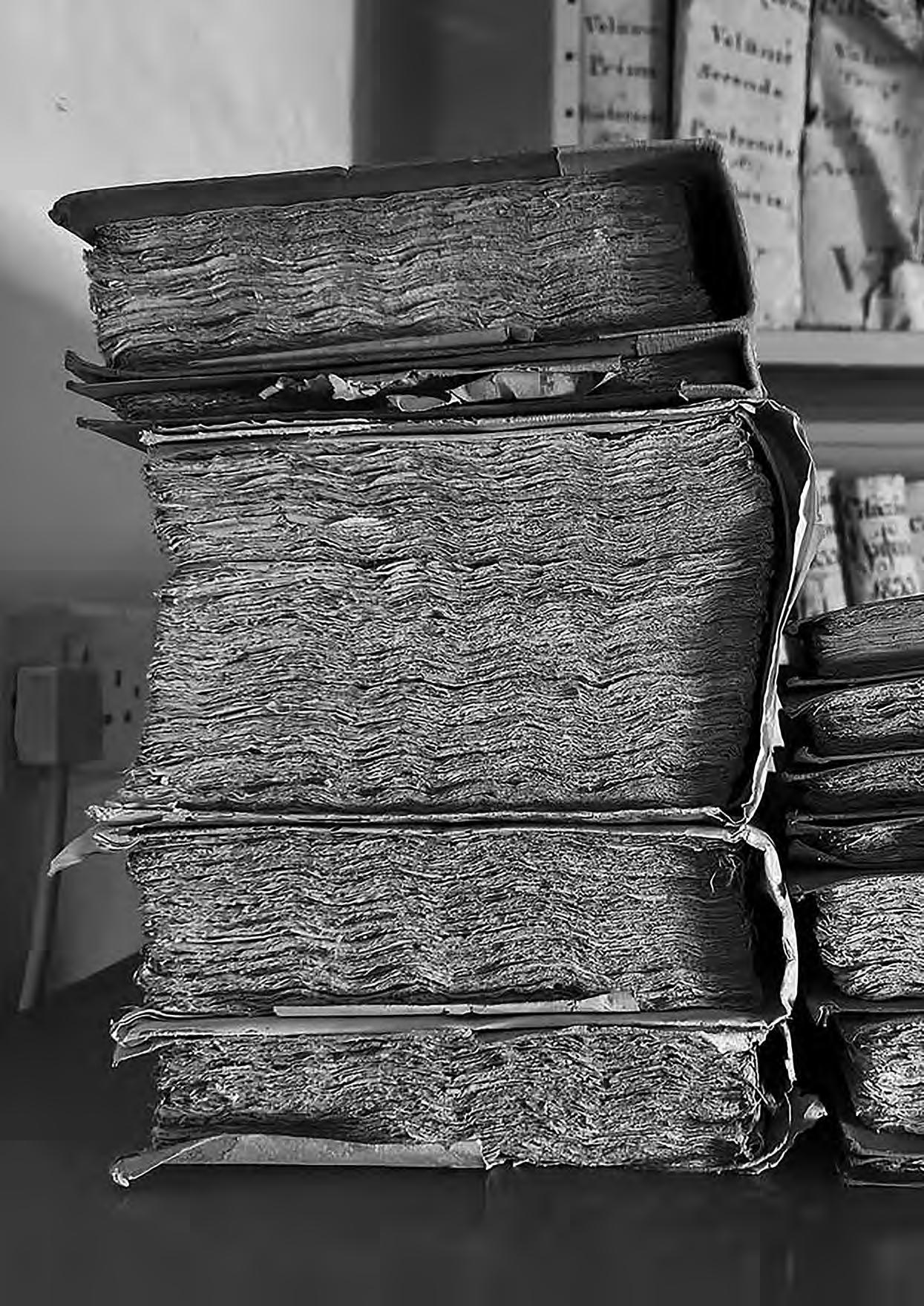
Records from the Tribunal Armamentorum.
During the year 2023, while registering an increase in demand for research conducted electronically, the Courts and Tribunals Archive recorded a decrease in the number of researchers and hours spent on research in the premises.
Ninety six researchers visited the Courts and Tribunals Archive and spent approximately 270 hours researching. They consulted around 129 volumes. This decrease came about because University graduates reading for a Masters in Notarial Studies did not conduct their practical research in the Banca Giuratale, unlike previous years.
For the second consecutive year, the volumes of the First Hall of the Civil Court were the most researched, with a focus on the Judicial Sales and Citations series.
Approximately 14 fonds from various Courts and Tribunals from 1530 to 1798 were catalogued up to the item level. These are now being processed and will be presented online in the coming weeks. Some have already been digitised by HMML and are available on the HMML platform.
The fonds are:
· Appellationes coram Probo Viro (APV) – 2 volumes
Appeals from Sentences issued by the local Ecclesiastical Courts or the Office of the Bulla Sanctissimae Crociatae to either the Metropolitan See in Palermo or the Holy See in Rome.


Students reading for an MA (Notarial Studies) at the Courts and Tribunals Archive, February 2023.
· Curia Aepiscopalis et Provicarialis Notabilis Civitatis (CAN) - 14 volumes
The collection contains cases heard before both the Valletta and the delegated Episcopal Court in Mdina. The Court seems to have been inactive during the insurrection against the French.
· Officium Auditorum Pro Alienatione Bonorum (OAB) – 2 volumes
A series of documents concerning the seeking of permission for the alienation by sale or lease in emphyteusis of properties belonging to the various institutions and foundations of the Order, including commanderies, foundations, monasteries and Langues.
· Officium Bullae Sanctissimae Crocitatae (OBC) – 23 volumes
The fond contain records pertaining to the administration of the Bull of Crusade (Bolla della Crociata) managed by the prior of the Conventual Church of the Order of Saint John of Jerusalem, of Rhodes, and of Malta. The Bolla della Crociata conferred many privileges to those who benefited from it, ranging from soldiers who participated in the struggle for the defence or expansion of Christianity, or those who supported such efforts financially, with the Bulla being valid for a set period before requiring renewal. A specific office was set up in Valletta in the area of the Auberge de Castille (actual location unspecified) to administer the granting of the Bulla, manage the financial aspect of the program and raise the funds required for the renewal of the Order’s licence every six years.
· Officium Civile Sacrae Inquisitionis (OSI) – 3 volumes
A collection of acta originalia spanning 15 cases heard before the Civil branch of the Inquisition, generally concerning the payment of money from one party to the other, or litigation concerning the rent, sale, or use of property. Each case includes the documentation presented as part of the deliberation and the sentence given by the Tribunal is often included.
· Officium Magistralis Secretiae (OMS) – 16 volumes
This Tribunal was in existence before the arrival of the Knights. A judge presided over this Tribunal which was responsible for the valuation of rents and leases belonging to the regno. The Secreto was the collector of rents. The passive cases and all cases related with the scisa were dealt by the Judge of the Secretia. These Segreti used to have their lieutenants, assessors and notaries and had to refer to the Magna
Curia, that is to the supreme tribunal of finance (Tribunale de’Conti). Later on it was substituted by the Officium Magistralis Secretia (1570 1798).
· Officium Spectabilium DD. Juratorum Notabilis Civitatis Insulae Melitae (OJN) – 13 volumes
A collection of documents reling to the activities of the Officium Spectabilium DD. Juratorum Notabilis Civitatis Insulae Melitae.
· Officium Syndicatus Congregationis Munium et Belli (OMB) – 14 volumes
A collection of cases relating to disputes arising from the expropriation of land by the Order or other secular authorities for the construction or expansion of fortifications.
· Officium Syndicatus Officialium (OSO) – 5 volumes
The Officium Syndicatus Officialium was established in 1597 to oversee complaints lodged against the officials of the secular administration for their negligent, criminal or improper behaviour and actions in the course of performing their duties, and so for cases of corruption, misappropriation or bribery, inter alia. The first folios in each volume of the Acta Originalia establish the structure of the court, which was to meet at an unidentified building formerly the property of Bishop Gargallo on Vannella Stretta in Valletta (at least from 1623). At the opening of the Tribunal, an edict was issued detailing its scope and remit and permitting the institution of cases against even former members of the secular administration. It is probable that the Officium was not a standing tribunal but was periodically convened. The Officium could investigate and try officials even while they occupied their positions.
· Officium Venerandae Seniscalliae – 70 volumes
The purpose of the tribunal was to deal with all cases related to the land forces, the servants of the palace, the customs, the university, the judges, the solicitors, the financial procurators and the notaries. In the case of an appeal, redress could be sought at the Supremo Magistrato di Giustizia, an Apellate Court.

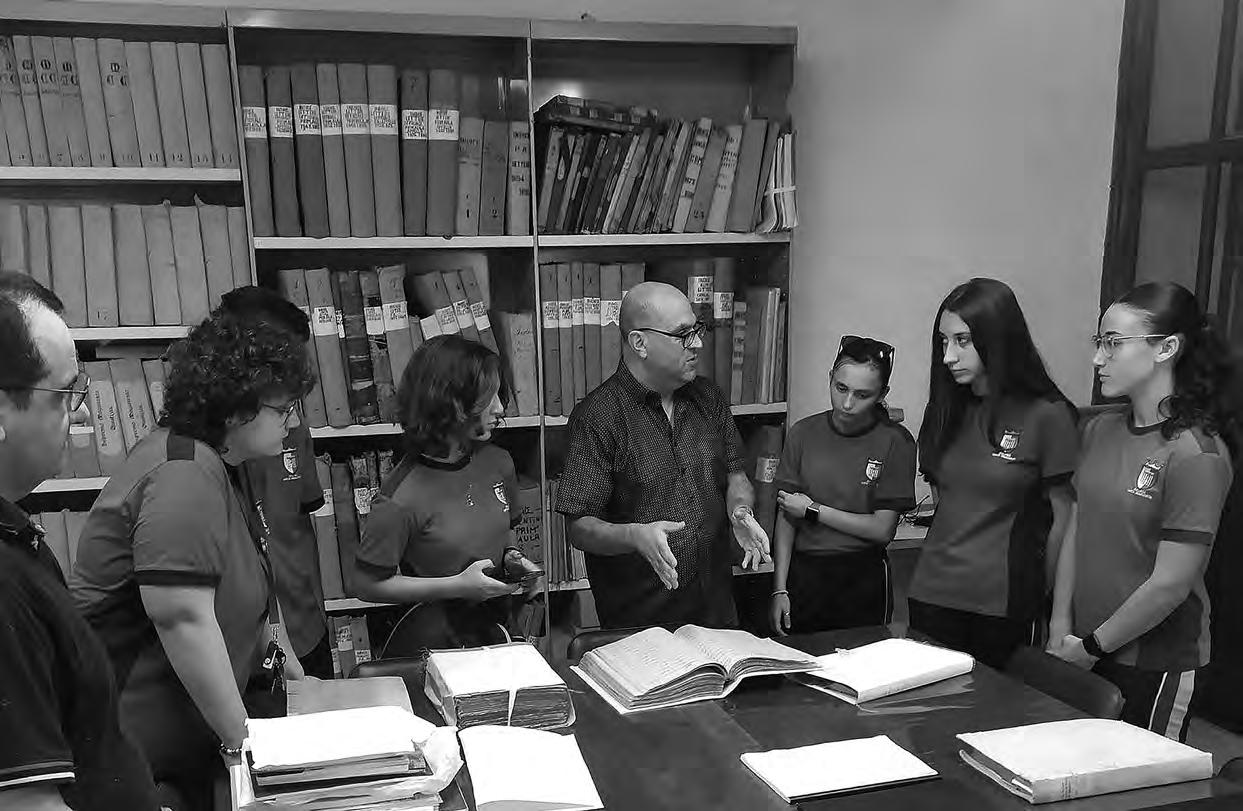
· Part of the Sacra Audentia (SAU) - 4 volumes
The Sacra Audientia was the Supreme Tribunal of Appeal.
· Tribunal Debitorum Religiosorum (TDR) – 17 volumes
The Tribunal, referred to throughout the available documentation as the “nuovo tribunale de debitori dell’Illustrissimo Ordine Gerosolimitano,” was established in 1776. The Tribunal was tasked with hearing cases concerning outstanding debts owed by members of the Order, as the confiscation ordered to satisfy these debts would have a direct consequence on the property or later inheritance of the Order.
· Tribunal Fabricae Sancti Petri de Urbe (TSP) – 1 volume
A collection of documents related to the dispute between the secular authorities (Universitas of Notabile; the Order) against the actions of the Cathedral was presented to Rome. The date of commencement was moved back from the previously incorrectly identified 1625 to the more exact new date of 1583.
· Tribunal Signaturae Justitiae (TSJ) – 3 volumes
A collection of cases was being appealed from sentences previously given by the Magna Curia Castellania and the Corte Secolare di Gozo.
· Magna Curia Castellania – Various registers including Registrum Actorum Criminalium (83 volumes) and Registrum Sententiarum Criminalium (58 volumes).
Tribunal Armamentorum
In 2023, St. John’s University’s Hill Museum & Manuscript Library of Minnesota (HMML) completed the digitisation of the Tribunal Armamentorum fond., The 72 volumes of the Tribunal Armamentorum are now available to the public through the HMML Reading Room at https://w3id.org/vhmml/readingRoom/view/237556.
On June 20, 2023, HMML’s Malta Study Centre hosted a zoom event in partnership with the National Archives of Malta and the Malta Maritime Museum to celebrate the collection’s completion and online access. The speakers emphasised the collection’s historical and archival content, as well as the importance of Malta’s maritime history from an international perspective.
Consolato del Mare
During the year under review work on the digitisation of the Consolato del Mare Records was started by the HMML. By the end of the yearnearly 2 TB of images from this massive collection were digitised by the end of the year. The Consolato del Mare was created by the Order of Saint John of Jerusalem to handle judicial matters related to maritime law in Malta and the Mediterranean.
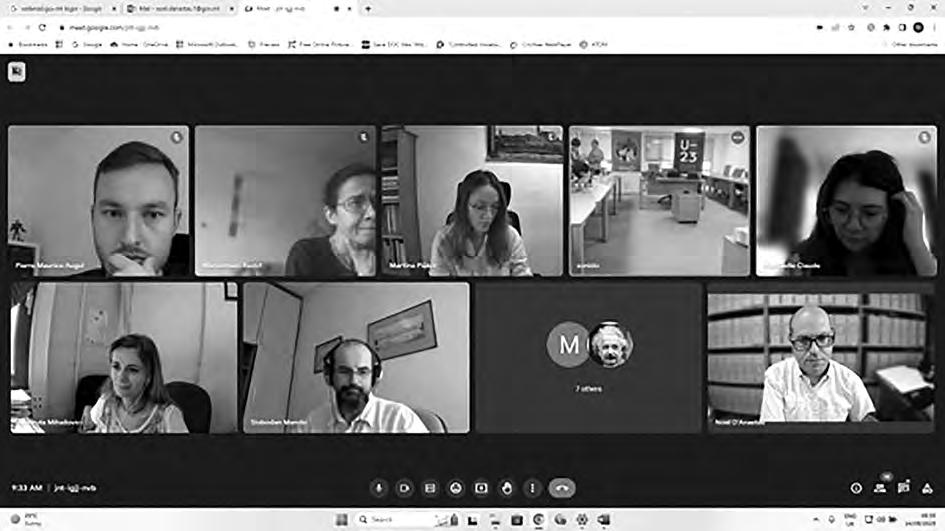
The in house digitisation of Maestro Frank Vassallo’s music collection was almost completely scanned and digitally preserved by the end of the year.
Students pursuing a Master’s degree in Underwater Archaeology and those studying for a Master’s in Notarial Studies visited the Banca Giuratale where they were able to examine archival fonds relative to their studies. Other visits were carried out by History students and Public Administration Students from the University of Malta. There was also a visit by Year 10 students from Verdala Secondary (Santa Margerita College)
Two foreign prosecutors from Germany and Spain visited the Archive to get acquianted with the criminal records. The visit was coordinated by the European Judicial Training Network and hosted by the Office of the Attorney General.
Noel D’Anastas, APEF Country Manager for Malta, participated two online meetings in May and September 2023, hosted by Sweden’s Riksarkivet and Alcalá de Henares, Madrid respectively. The focus of the meetings was on APE’s updates and new commitments for 2024 and a presentation on Records in Contexts regarding archival standards.



The week-long celebrations welcoming the relic of St Francis Xavier were among the main events in Malta during 1924. Judging by the contemporary photos and publications, these festivities, held between 26 May and 2 June, eclipsed by far other events including the general elections that were held barely one week later (9-10 June).
On 8 May 1924, Archbishop Mauro Caruana published a pastoral letter encouraging the faithful to welcome the relic containing the right arm of the saint and to participate in the celebrations. A high level organising committee was set up; it was composed as follows:
Mons Paolo Galea, President
Dr Francesco Pullicino, Treasurer
Mr A.E. Camilleri, Secretary
Members:
Dr Francesco Buhagiar, Prime Minister
Dr Arturo Mercieca, Chief Justice
Mons G. B. Buhagiar
Mons L. Farrugia
Mons LM Camilleri
Fr V. Furci SJ, Rector St Aloysius College
Fr S. Milanesi
Fr A. Bonnici
Fr E. Ceravolo
Marquis G. Scicluna
Mr Alfons Maria Galea
Prof A. Bartolo
Dr A. Magri
Mr John Ellis
Since early morning, devotees flocked to the Bastions overlooking the Grand Harbour awaiting the S.S. Ljubljana that was to bring the relic of St Francis Xavier from Sicily. The ship entered the Grand Harbour at 7.00 am amidst shouts of joy from the crowd, ringing of bells and whistling of sirens.
After the Ljubljana moored along the quay, Archbishop of Malta Dom Mauro Caruana, Prime Minister Francesco Buhagiar and Chief Justice Sir Arturo Mercieca went on board. The relic was brought ashore and was received at Customs House by the Ministers, members of the bench, as well as members of the different learned professions and constituted bodies.
Archbishop Caruana, together the Jesuit provincial Fr Liborio Rubino SJ who brought the relic from Sicily, entered a coach drawn by four horses that took them next to Spencer monument where they joined by a motorcade of some 75 cars towards Valletta. It went through Portes des Bombes and all the way through Strada Reale (now Republic Street) before turning towards Strada Mercanti.
The first stop was the Jesuit Church in Merchants Street. From there, the relic was taken to St John’s C Cathedral on foot; enthusiastic huge crowds gathered along Strada Reale.

At 6.00pm the relic was taken Floriana and from there was taken back to St John’s; the celebrations ended at 11.00pm. 1 2 3 4 5
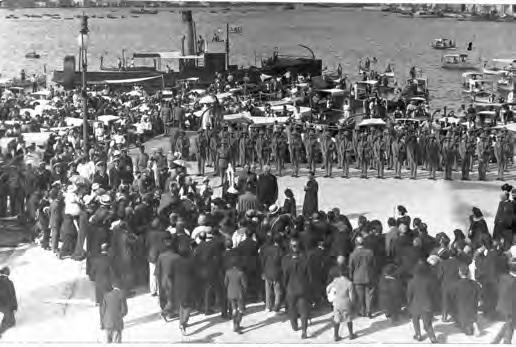

3. Archbishop Caruana entering Customs House with the relic. On the right is St James’ Schola Cantorum, a choir that played an important part during the festivities.
Giovanni Bonello Collection.
4. The procession with the relic of St Francis Xavier moving towards St John’s Co Cathedral from Strada Reale, after visiting the Jesuits Church in Merchants Street. Photo: Giovanni Bonello Collection.
5.



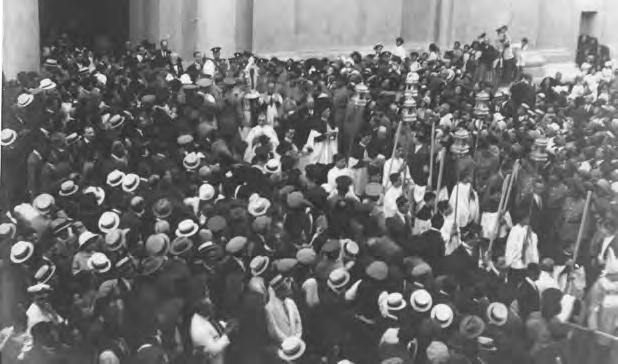

WEDNESDAY, 28 MAY
TUESDAY, 27 MAY
Mdina and Rabat were the focus of the celebrations. Pilgrimages from Rabat, Dingli and Mosta to Mdina Cathedral were organised in the morning. The relic was taken to Santo Spirito Hospital (today the central offices of the National Archives) and to the Duke of Connaught Hospital (Mdina).
The focus was St Helen’s Church in Birkirkara. Pilgrimages from Lija, Attard and Balzan arrived at Birkirkara Church.
THURSDAY, 29 MAY
The relic was taken St Aloysius College; celebrations were organised for college’s former students.
FRIDAY, 30 MAY
The relic was taken around by Jesuits, including the Poor House (today St Vincent de Paule Residence), Corradino prison and orphanages. In the evening, the relic was taken to the Seminary in Floriana.
SATURDAY, 31 MAY
Celebrations were held as St John’s Co Cathedral. Huge crowds entered Valletta on this occasion; newspaper reports state that from Sliema alone there were 2,000 persons.
The celebrations targeted students, from University and Lyceum students to school children. Newspaper reports estimated that some 3,000 students took part. In the evening the relic was taken to Floriana on a decorated lorry.
In the evening the
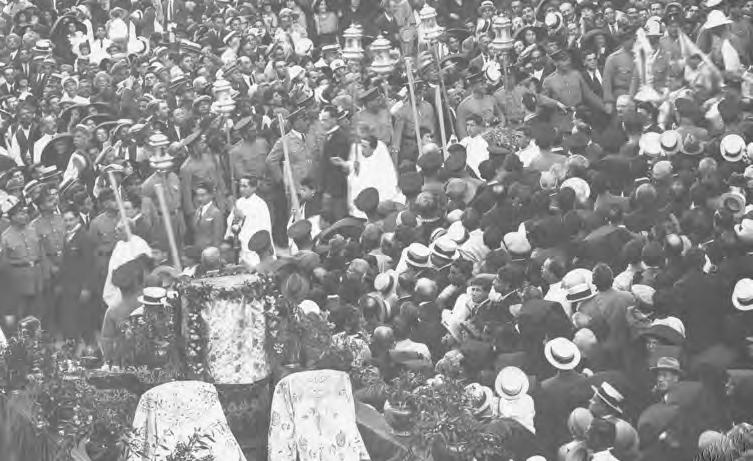

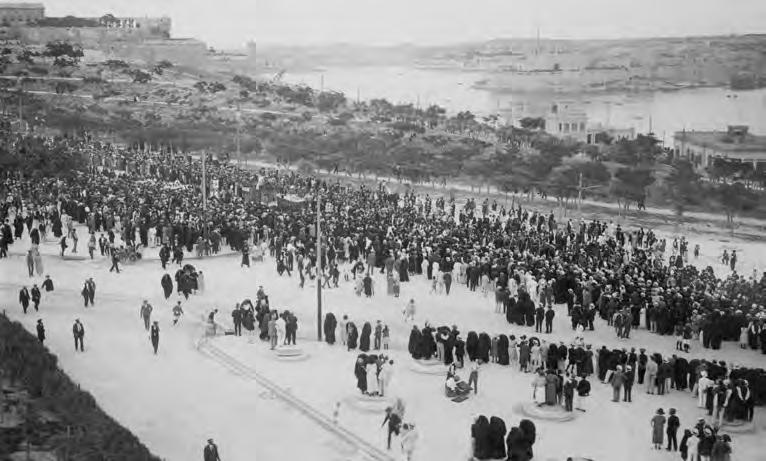

At 6.00am the relic arrived at Mġarr in Gozo. One hour later a procession left Racecourse Street toward the Cathedral in Victoria where several celebrations were held up to 3.00pm. Then a procession left from the Cathedral; the relic was taken also to St George’s Church in Victoria. At 6.00pm it left Victoria and was boarded on the Golly that took the relic to the Gran Harbour where the Ljubliana was waiting to leave to Sicily.
These celebrations were very popular; in fact several photographers recorded these events and published a significant number of photographs. We are reproducing some of these photographs, mostly from the Giovanni Bonello Collection.
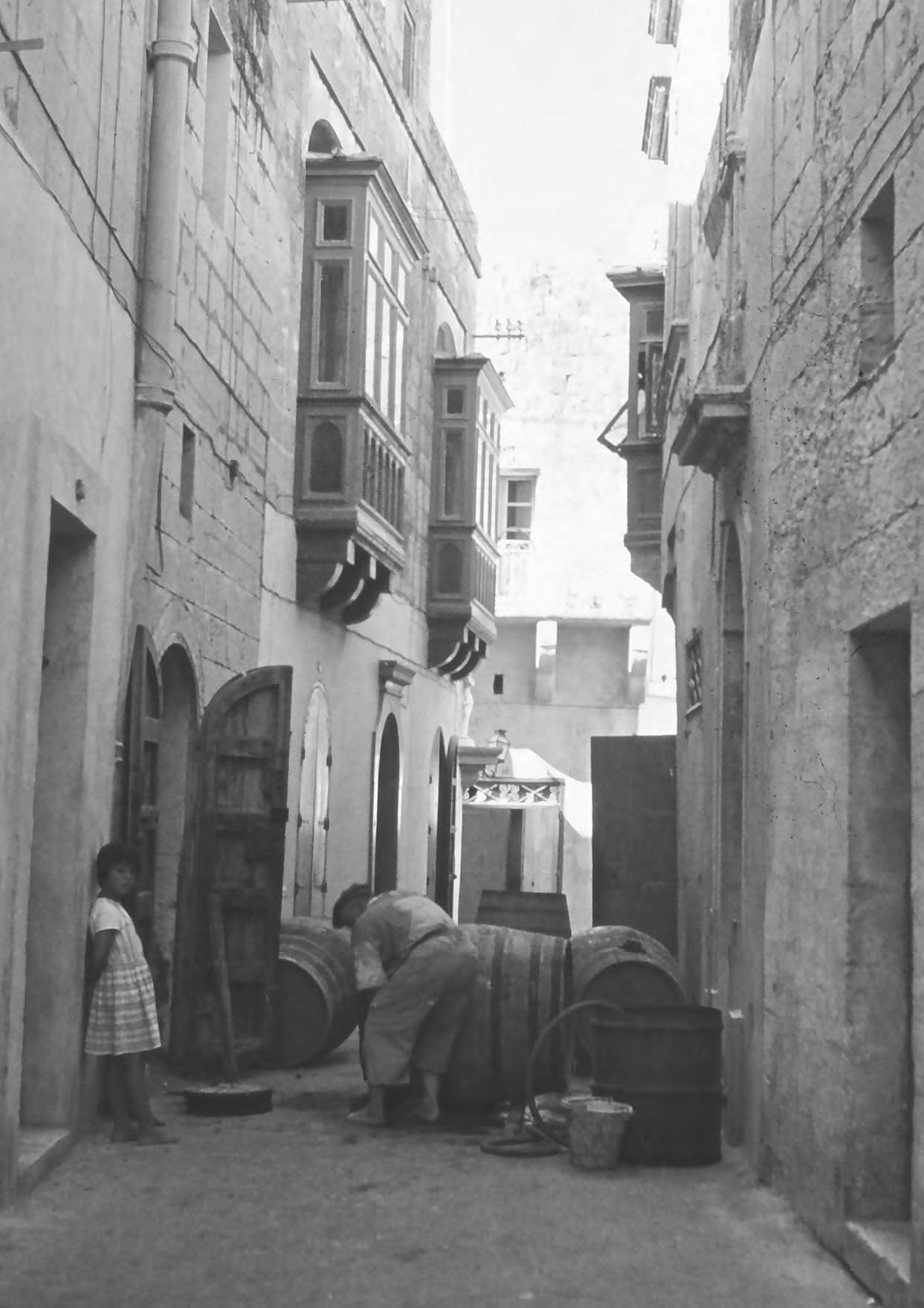
The Gozo Archive, an archive within the National Archives of Malta, is the public record office for the documentation created and received by Government departments and establishments in Gozo and Comino. It provides its services from the main premises in Triq Vajrinġa in Ir-Rabat, Gozo and includes another two repositories in Għarb, one of which houses the register copies of notarial acts published in Gozo and Comino.
During the year under review, an Archives Assistant was seconded with an NGO in Gozo while the complement was increased by three new staff members bringing the total current staff complement at the Gozo Archive to six. During the summer months a University student and a young volunteer had a work experience at the Archive. A trainee under the Government of Malta and Maltapost agreement for training of persons with special needs is also deployed at the Gozo Archive.
In 2023, visits were carried out by staff members at the Department of Industrial and Employee Relations (DIER) at the Ministry for Gozo to assess a number of volumes previously pertaining to the Department of Labour and Emigration (DLE). 61 volumes were eventually transferred to the Gozo Archive. A visit was also paid to the premises of the former Lands Department in Gozo which suffered from an incident of severe water infiltration. 241 plans and maps were salvaged and taken to the Archive where they were straightened, dried, cleaned and stored.
During the year under review, visits were carried out by our staff at the Gozo Law Courts at Ċittadella and at the Nadur Primary School. At the Law Courts a number of volumes were earmarked for transfer. Unfortunately, since both the main hall of the Victoria as well as the Għarb repository are full to capacity, no additional volumes could be transferred. A small collection of thirty volumes from Nadur Primary School was transferred to the Għarb repository since refurbishment works were scheduled to commence at the said school. The Gozo Passports Office also earmarked a substantial amount of passport applications for transfer to the Gozo Archive; however this transfer could not be carried out because of space shortage.
The table below lists the new accessions that were added to the Gozo Archive during 2023. Sizeable collections from the Law Courts and Passports office could not be transferred due to lack of space.
Contents Source
Plans and maps Lands Section Ministry for Gozo
Colour photographic slides
Date of Transfer Description
17/02/2023
Ms Lucy Hart
01/03/2023
Postcards, Photographs and documents
Dr George Azzopardi
Map of Gozo Transferred from Victoria Police Station
Old Gozo Postcards and Photos
Dr George Azzopardi Donation
Personal files Ministry for Gozo
Colour photographic slides John Cremona
Attendance registers and correspondence Gozo College Żebbuġ Primary School
Plans and General correspondence Transferred from Ta’ Ġurdan Lighthouse
02/06/2023
08/06/2023
Plans of various Government projects in Gozo, Survey sheets of Government tenements and maps.
Colour photographic slides of Malta and Gozo taken by Mr Anthony Hart, formerly Chief Architect in Edinburgh City Architect Department Scotland, taken between 1950 and 1970’s.
Extent
241 sheets
03/08/2023
05/08/2023
16/09/2023
30/09/2023
09/10/2023
359 slides
Postcards and photos of Gozo. 39 items
Printed map of Gozo signed G. Cassar dated 10/08/1922
Handcoloured to show the different police districts in Gozo.
Old postcards and photos related to Gozo.
Personal files on attainment of 75 years of age.
Colour photographic slides of Gozo 1970’s.
Attendance registers and mixed correspondence.
Plans, drawings, daily records and general correspondence.
1 item
3 items
11 files
117 slides
4 volumes
22 plans and 3 box files
Contents Source
Information about artists with Malta/Gozo connection
Fr Charles Cini SDB
Reference books Fr Charles Cini SDB
Photographs Joseph P. Zammit
Registers Deparment of Industrial and Employee relations
07/10/2023
09/10/2023
10/10/2023
Personal archive of Peter Apap Bologna of Melitensia Art Gallery Lija about artists with Malta/Gozo connection.
Various old editions of classical reference Works.
Black & White photographs showing emigrants leaving Malta Airport on 19 March 1968.
21 box files
28 books
14 photos
11 October 2023
Registers pertaining to the Department of Labour and Emigration.

924 volumes/items were added to the Gozo Archive during the year under review. This is significantly more than those registered during the previous two years: 710 (2021) and 133 (2022).
Up to the end of the year, the Archive held fonds from twenty nine different entities, each of which is subdivided to reflect the diverse activity carried out by the entity that created the fonds. The fonds, by the cataloguing code are:
AG Archives Gozo (National Archives – Gozo section)
CA Civil Abattoir
CC Civic Council
CG Curia Gubernatorali (Courts of Law)
CI Charitable Institutions
CP Circulars and Posters
CR Cremona Collection
DF Documentaries and Films
GB Malta Government Savings Bank
GL Ġurdan Lighthouse
GM Ġuljana Masini
HI Hospitals and other Institutions
IR Inland Revenue
LC Local Councils
LE Labour and Emigration
MG Ministry for Gozo
MH Medical and Health Department
MP Monte di Pietà
PA Photograph and Albums
PD Police Department
PM Plans and maps
PO Passport Office
PW Public Works
SG Secretariat to the Government
SN Street naming
SS State Schools
ST Statistics
UG Universitas Gaudisii
ZM Miscellanea
During 2023, digitisation was carried out on three separate fonds. The digitisation of the MH fonds (Medical and Health Department) consisting of building applications was continued. This fonds is by far the most popular and the continuous handling of the fragile volumes and plans is detrimental to their conservation. 187 volumes from the PD fonds (Police Department) consisting of Occurrences Books covering the years 1889 to 1927 have also been digitised. Digitisation of the SG fonds (Secretariat to Government) pertaining to the first years of British administration on the Island was also commenced. This digitisation project is being carried out by a trainee employed through an agreement between Government and Maltapost for persons with special needs.
Research sessions during 2023 amounted to 252, more than the previous two years – 101 (2022) and 212 (2021). The number of research hours amounted to 316, also more than the previous two years: 240 (2022) and 354 (2021). The number of items consulted was 502.
During the year 2023, the MH Medical and Health fonds proved to be again the most popular; followed by the GM Guljana Masini fonds and the PD Police Occurrences Books.
The following is a break down of statistics per month (2023):
July
The following table shows the number of consultations from each fond per month (2023):

Gozo Archive staff received training in basic handling, cleaning and storage techniques. Staff were instructed how to make folders and materials to use.
The Anthony Hart Collection of photographic slides as well as a second collection of slides accessioned during the year under review were sent to the National Audio Visual Institute (NAVI) for cleaning, cataloguing and digitisation. It was agreed that the originals are to be kept in the cold storage room at the Central Archive in Malta since such facilities are not available at the Gozo Archive.
Several items from this collection were sent to the Conservation Laboratory in Malta for restoration and conservation.
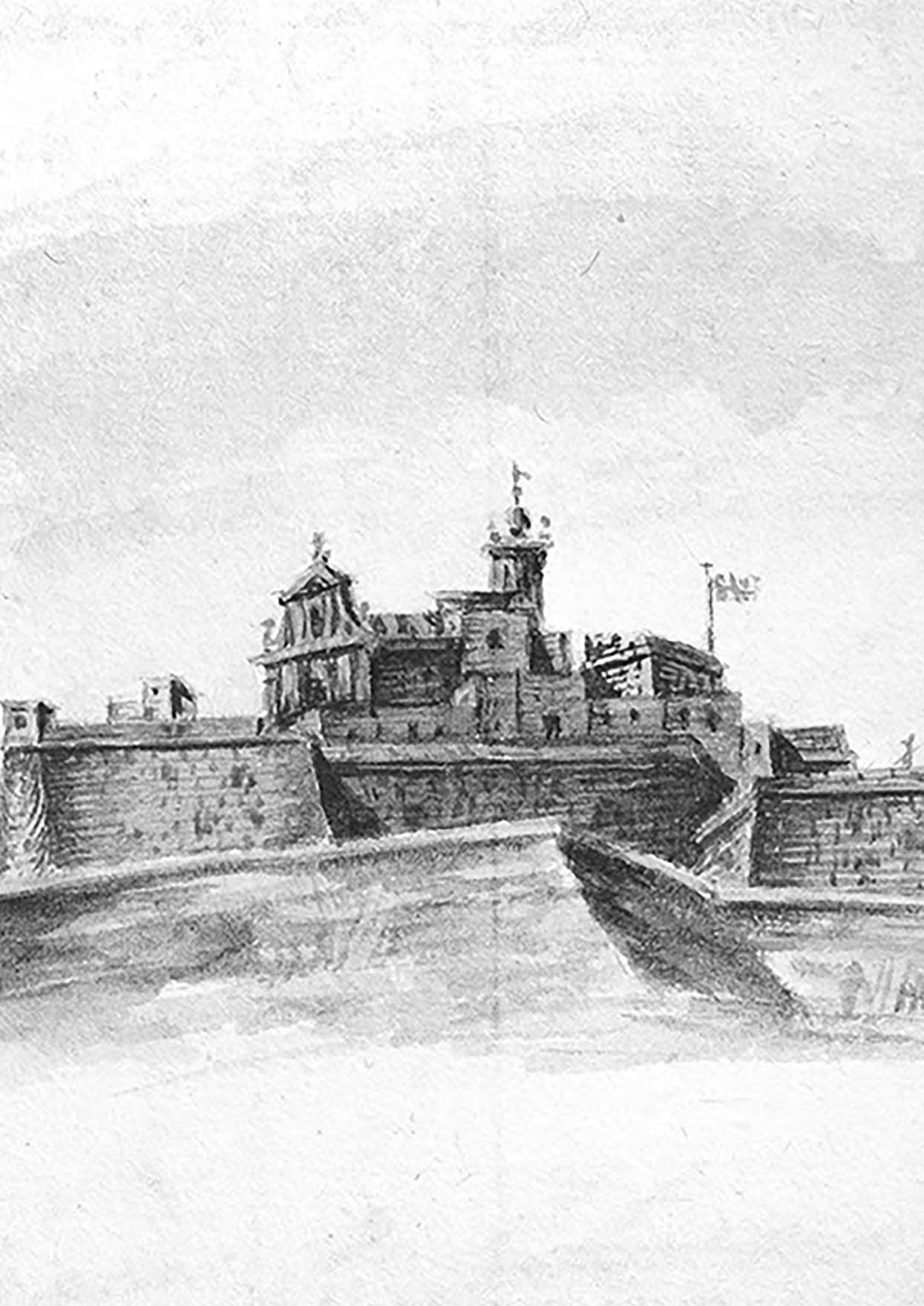
Watercolour of Cittadella in the acts of Notary Antonio Portelli.

On the occasion of the 75th anniversary of the tragedy of the drowning of 23 persons in the Gozo channel on 30 October 1948, the Gozo Archive set up an exhibition which included documents, photographs and artefacts related to the tragedy. Staff took up the challenge to track and collect photographs of all the victims and survivors of this tragedy. A catalogue of the exhibition was also printed. The Archive also contributed significantly towards the photographs featured in the book written by Dr Mgr Joseph Bezzina to commemorate the event. The exhibition proved to be extremely popular and around 600 persons including students from different classes visited the exhibition.
Staff from the Archive also took part in the Open Day held at the Central Archive on 26 November. Our stand included a selection of photographs and documents from the 1948 Tragedy Exhibition which proved to be very popular with visitors.

On the occasion of the Public Service Week, Principal Permanent Secretary Tony Sultana, accompanied by Permanent Secretary Joyce Dimech, paid a visit to the Gozo Archive on 1st February 2023. They were shown a selection of important documents conserved at the Archive and the work undertaken by the section was also explained. A particular focus was made on the ongoing digitisation projects as well as on the fonds which are already available online for public consultation.
The Assistant National Archivist attended the meetings of the National Archives Council as an ex-officio member on the same council as provided by the National Archives Act. The issue of lack of space at the Gozo Archive was highlighted in several meetings.
Marco Camilleri, Salvina Portelli, Paul Falzon, John Cremona, Josianne Cassar and Maryanne Curmi.


The Notarial Registers Archive, Valletta.
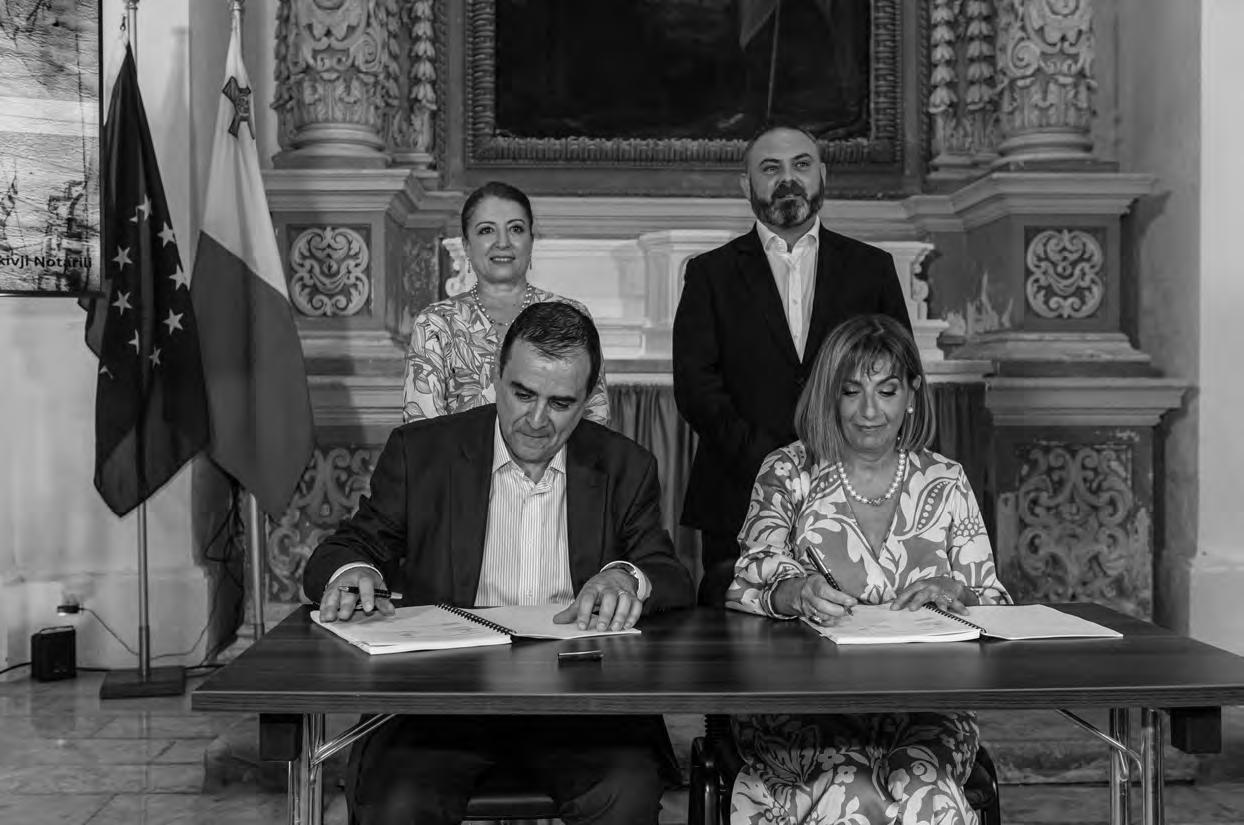
Agreement between the National Archives of Malta and the Notarial Archives Foundation
On 25 July 2023 the National Archives of Malta signed an agreement with the Notarial Archives Foundation (NAF) for the management of the operations at the Notarial Registers Archive (NRA). Following two decades of voluntary efforts in rehabilitating, preserving and raising awareness about the NRA, the Foundation was entrusted with the responsibility of managing the NRA.
The NAF is a voluntary organisation, previously known as the Notarial Archives Resource Council, that was established in 2004 and is directed by a Board of Administrators. The NAF President of the current administration is Dr Joan Abela. The NAF Board delegated the running of the NRA to the Notarial Registers Archive Committee (NRAC) that includes a representative of the National Archives of Malta.
In 2023, the NRA team, led by Dr Joan Abela, consists of nine members, seven of whom are National Archives of Malta’ s employees that are on loan with the NAF.
The NAF’s employment of a Chief Knowledge Officer was important for the setting up of the Knowledge Department at the NRA. This Department oversees the cataloguing, archiving and palaeographic activities at the NRA. Its key focus is to ensure seamless data integration, consistency and synchronisation across all NRA departments. The Department also plays a vital role in monitoring the technology installed at the NRA and in addressing any IT related issues.

In 2023, the main responsibility of the NAF was to oversee the completion of the ERDF project, which included the finalisation of the NRA Museum in collaboration with Fondazzjoni Patrimonju Malti (FPM). The ERDF project saw a total investment of €5 million into the rehabilitation, conservation and preservation of the Archive’s buildings and the collection. The NRA Museum, another result of the ERDF project, now exhibits highlights from the NRA collection, including the Kantilena and the document of the granting of the George Cross to Malta.
The ERDF project was officially inaugurated on 23 November 2023.
In November 2023 the NAF also resumed its volunteering programme, which it had to pause in 2020 due to the ongoing ERDF rehabilitation works and the outbreak of COVID 19. NAF volunteers now visit the NRA twice a week to participate in various activities, including dusting and transcribing, giving tours of the Museum and other miscellaneous works. Whereas the volunteers who are engaged in the dusting project are supervised by the NRA conservators and the trained NRA staff, all volunteers involved in the transcription project work under the supervision of the NRA palaeographers. Since the recommencement of the volunteering programme, the NAF has seen the return of many dedicated long time volunteers and it has welcomed many new enthusiastic recruits.
Official inauguration of the refurbished Notarial Registers Archive, November 2023.


Another milestone that the NAF celebrated was the launch of the Lingua Latina ab Initio Courses 1-3, organised in collaboration with the Malta Classics Association, as the registered representative of Euroclassica in Malta. The courses lead up to the international ELEX Vestibulum certification and the syllabus of these first three courses covers the basic grammar and rudimentary elements of syntax of Latin. Students who successfully attend these courses will be suitably equipped to engage in basic independent reading of Latin documentation. Fifty students registered for the first of these courses, with many having already registered for the subsequent two courses.
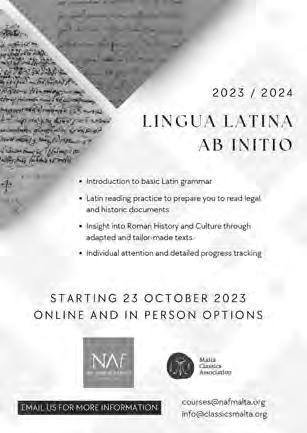
Conservation projects
In 2023, various conservation projects were carried out. These included items now displayed at the NRA Museum, namely notarial volumes, single leaf items and logbooks from the Maritime Collection. Works mainly consisted of mechanical surface cleaning, paper repairs, text consolidation, sewing consolidation and replacement where necessary and consolidation of various aspects of the bindings. Before and after photography and condition reports were also updated accordingly. In addition to our ongoing initiatives, the conservation team is currently working on the conservation of three sixteenth century documents sponsored under the Adopt a Notary scheme.

The disinfestion, by Anoxia treatment of the NRA collection continued. The disinfestation cycle is forty days long and when ready, the boxes in which the notarial volumes are packed are inspected by the NRA conservators for any signs of insect activity. Each box is given an individual barcode for identification purposes and is individually sealed in plastic. As of December 2023, thirteen batches of approximately 250 boxes each have been disinfested.
Throughout October and November, the Conservation Department primarily focused on finalising conservation work on the objects to be displayed in the NRA Museum. The Conservation team also assisted Fondazzjoni Patrimonju Malta, in the design of the plinths of the Museum and in the mounting of the exhibits for display. The Department was also responsible for creating the ideal environment within the showcases, ensuring that correct lux levels are maintained and installing silica gels to stabilise relative humidity and temperature.
The migration of the collection to the NRA is planned out in different stages. In preparation for the migration, the Conservation Department collaborated with the Knowledge Department in monitoring the Repository’s Climate Control Units (CCUs) to ensure that the environment is optimal for the safe storage of the collection. A re shelving plan of the entire collection was also devised. Moreover, the shelves were lined with Plastazote®, which provides additional protection to the documents.
Following their disinfestation treatment, batches of volumes are brought to the NRA. These are then surface cleaned by
dedicated NAF volunteers and catalogued under the supervision of the trained staff. Each volume is also bound with a conservation grade ribbon that contains a label to which a NFC tag is affixed. Following this, the conservators transfer the volumes to the Repository and place them on their designated shelving space.
The migration process is designed in such a way that the collection is returning to the NRA in ascending Register number order: the first batch to enter the Repository in 2023, for instance, contained the volumes of Registers R1 to R5.
The first months of the Knowledge Department were dedicated towards setting up the IT infrastructure for the Archive and the employees. Several meetings were held with the Information Management Unit (IMU) of the Ministry for National Heritage, the Arts, and Local Government (MHAL) to understand the network system at the NRA. The Knowledge Department also oversaw the patching of numerous ports at the NRA, which remains an ongoing process.
In order to understand the function of the various systems in place at the NRA, in addition to monitoring their performance and maintaining the machinery, the Knowledge Department devised different types of monitoring sheets, thus capturing data on the CCUs, the data loggers and the heat and smoke sensors, to mention a few.
In 2023, the Department also oversaw the installation of new CCTV cameras in the NRA Museum, which allows for remote monitoring of the Museum and its visitors.
In collaboration with the Administration Department, the Knowledge Department also reviewed and negotiated several service agreements for the maintenance and upkeep of various systems in place at the NRA. As a result, starting in 2024, service agreements for the maintenance of the security systems, the air conditioning units and the CCUs are set to become operational. Negotiations for other service agreements are still ongoing.
The Knowledge Department incorporates within it the Palaeography Section. One of its key responsibilities is the creation of a data corpus of transcriptions of notarial documents from the NRA collection in different languages, namely Latin, English and Italian. This corpus is intended to serve as a resource for Notarypedia, which will be an online platform with a knowledge graph as a backend, whereby with the use of Artificial Intelligence, data is extracted from the contents of notarial deeds and catalogued. This will facilitate both automatic transcription and data mining processes.
The Palaeography Section also works on the transcription and translation services that are being offered by the NRA to third parties. This initiative has proven to be successful in attracting the interest of clients from varied backgrounds and it also is a stable source of income for the Archive.
One of the primary objectives of the ERDF project was to enhance the accessibility of the NRA collection to the general public by making it available online. In 2023, substantial market research was undertaken to carefully select the most suitable equipment for the digitisation of the NRA collection that would also respect handling standards set by the NRA Conservation Department. It is hoped that the digitisation equipment will start servicing the NRA in early 2024.
In 2023 the Knowledge Department and the National Archives agreed about the standards for the cataloguing of the NRA collection in line with international archiving standards. This forms part of the migration process of the NRA collection from the storage facility to the NRA. In the absence of a complete inventory of the collection, in 2023, the Department prioritised setting the foundations for cataloguing work to become a key activity of the Department in 2024.
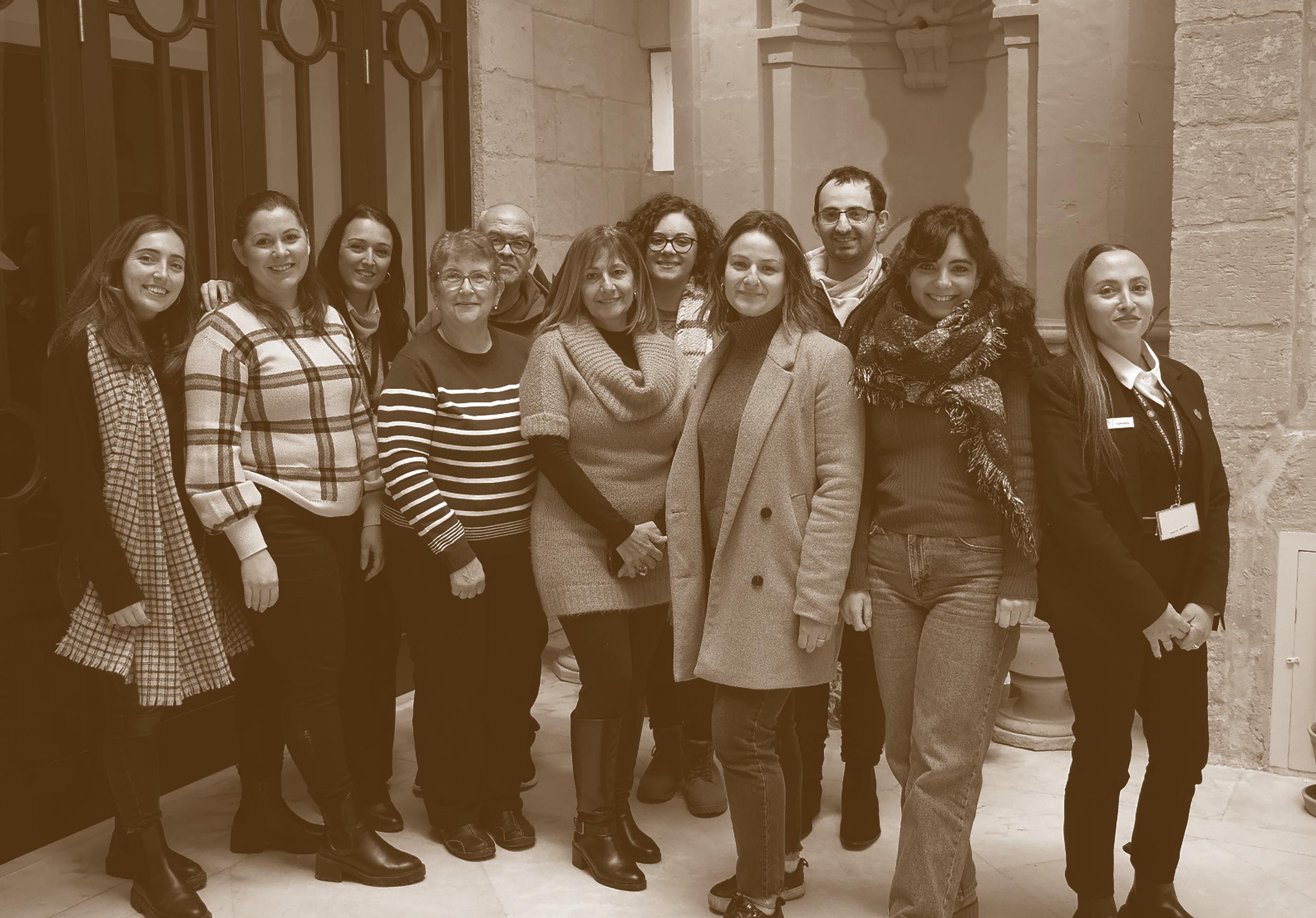

Joseph G Scerri MA (Doc.Mel)
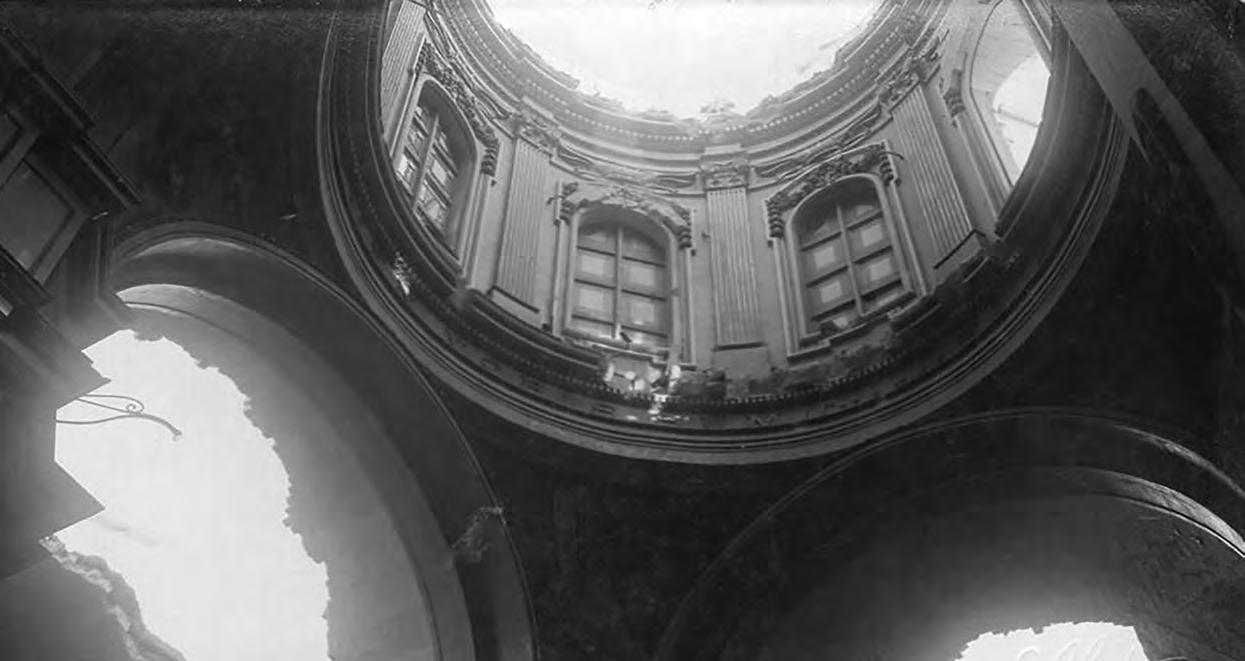

Saturday, 29 November 1924. At approximately 10.45pm a huge noise shattered the center of Rabat. The dome of St Paul’s parish church had collapsed, piercing through the round vault ceiling of the two main side chapels and the choir, penetrating the church ‘s floor deep down into the crypt.
The scene was that of a destroyed church, something which the people had never envisaged or seen until then. The main white marble altar and St Stephen’s and St Anthony the Abbott’s altars in the choir were badly damaged. Alessio Erardi’s 17th century titular painting showing the Shipwreck of St Paul was torn.
Two days later, on 1 December, addressing the Legislative Assembly the Hon Dr Giuseppe Degiorgio described the Rabat dome incident as “catastrofe immane”, a huge catastrophe. The newspapers carried extensive reports on this incident. Numerous photos of the event, taken by locals and British service officers based on the island, still exist.
The Government took the matter very seriously. On Friday 5 December Prof. Carlo Mallia, Minister for Justice, set up a board of inquiry board composed of Judge Prof. Robert Ganado as president, and architects Oliviero Borg Olivier, Frederick C. Bonavia and Francesco Maria Caruana. The board instructed Richard Ellis to document the incident by photographing the site.
The destruction from the collapse included the vaulted ceilings of the two side chapels and the choir. Photo: Richard Ellis.
Damages in church structures because of tremors and earthquakes are not that rare in the history of these islands. The most renowned is the 1693 earthquake that struck on 11 of January at 1.30pm when a 7.4 Richter (ML) tremor was registered 1 .
The 1693 earthquake left a heavy toll on the southeastern part of Sicily. Although no deaths were registered in Malta, structural damages of a serious nature were recorded especially in Mdina and in Rabat, its suburb. In the latter, the belfry of the newly built parish church of St Paul, inaugurated ten years before, collapsed. The choir apside suffered the same fate. Damage was also recorded on the dome structure. Structural repairs and alterations were conducted by its original architect Lorenzo Gafà 2
On the 20 February 1743 another earthquake hit the islands and several churches suffered heavy damages. In Gozo, the parish church of St George and the church of St James in Rabat as well as the church of the Immaculate Conception in Qala were badly damaged. The most prominent damages recorded in Malta were those reported in the cathedrals of St John’s in Valletta and that of Mdina. The Mdina Cathedral lost one of its smaller domes and cracks were developed all over the structure. No damages were logged in the parish church of St Paul in Rabat.
However, ten years later, a report written by two architects and three master masons in the presence of a notary and two witnesses was submitted to Grandmaster Pinto, the Cathedral Archpriest and the Rector of St Paul 3. This report referred to dangerous faults in the building of the dome and refers to serious cracks at various parts of it. It also recommended a series of drastic interventions. There is no indication that any such intervention was carried out. Yet still this dome had resisted at least another 23 earthquakes recorded in Malta until that of 1923. Moreover, it had been loaded with another aesthetically magnificent, yet heavy dome built on top of it in 1919 1920 designed and constructed by Architect Carmelo Micallef4
On the 18th of September 1923 at 7.30am, a 10 to 12 seconds tremor was felt in Malta and Gozo. The 6 Richter magnitude earthquake had done damages to the Rabat St Paul’s Church dome snapping deep cracks visible from the inside of the older dome in five different parts of the 19th century fresco showing the apotheosis of St Paul in Heaven, painted by Giuseppe CalÌ. One of the stone flame finials from on top of the lantern fell and ended on the church parvis. Nobody was injured. On close inspection it resulted that one of the cracks was approximately 10 cms wide whilst other cracks were detected on the outside crust of the dome. Architect Andrea Vassallo was entrusted with the repairs which included a thick metal ring made of eight parts and imported purposely to secure the dome form the outer side. It was only after the installation of this iron belt in June 1924 that the other repairs could be carried out 5 .
By November of the same year, four out of the five window cracks on the outside of the dome were repaired. But then the dome collapsed on 24 November.
The church was closed to the public and parish church services were transferred first to St
1 Galea P. (2007) Seismic History of the Maltese Islands and Considerations on Seismic Risk, Annals of Geophysics, Vol 50,n.6, p.725 740.
2 Rabat St. Paul’s Parish Archive (APR), CLF/4, Fabrica di San Paolo (1693 1705), f.92 includes a list of damages suffered by this church because of the 1693 earthquake whilst repairs are recorded in folios 103v, 103r and 121r.
3 (A)rchivum (C)athedralis (M)elitensis. Misc 377. f.7.
4 Scerri JG (2020), Il-Koppla tal-Knisja ta’ San Pawl tal-1920. Il Festi Tagħna, no 44, pp 4 7.
5 Scerri JG (2023), It-Terremot ta’Mitt Sena Ilu, 18 ta’ Settembru 1923 Il Festi Tagħna, no 47, pp 17 29.
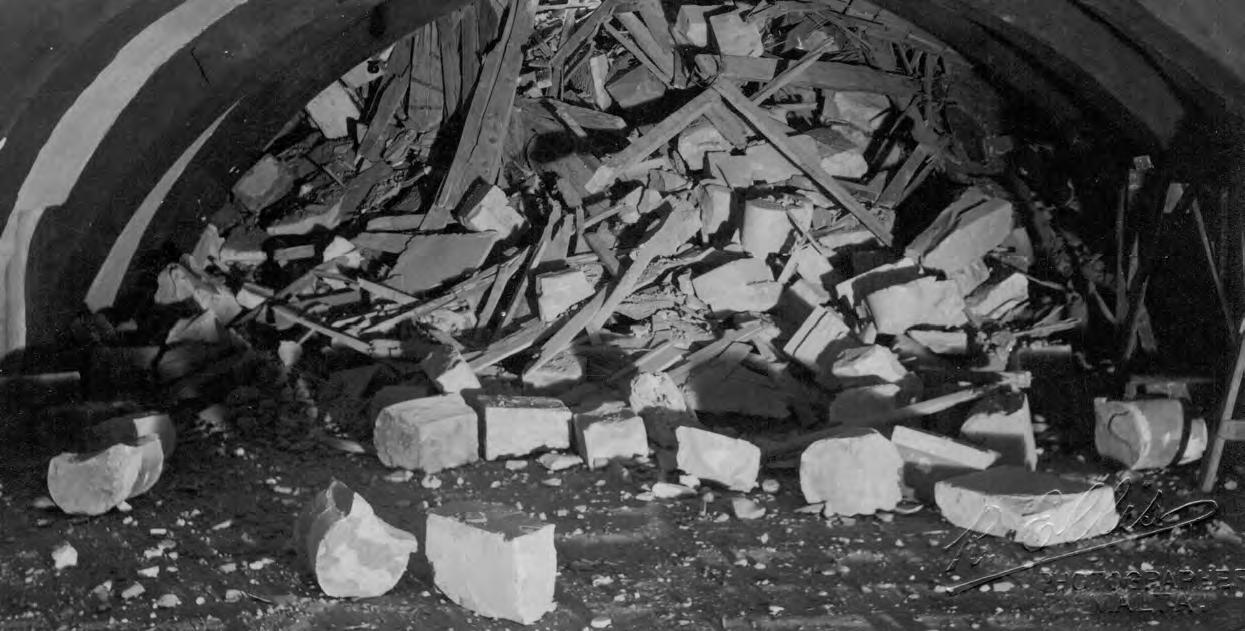
Cathaldus Chapel and then to the corridor and chapel at the first floor of the Convent of the Chaplains of St Paul’s Grotto, the building which today serves as the Wignacourt Museum.
The parish priest Rev Enrico Bonnici reached out the people of Rabat and compatriot immigrants mostly those in Detroit and California to raise the huge amount of funds needed. The Government through the Legislative Assembly voted the sum of £ 1,000 to help in the rebuilding of dome and repair of the church. Parish priest Bonnici set up a committee made up of parishioners serving in the parish’s various entities to discuss way forward.

The high level of destruction visible led to some of the parishioners suggesting that the church should be demolished and built on the site of the adjacent cemetery of St Paul facing North. Others suggested that the church should be held facing east yet it should have been extended sideways to create two aisles to the central nave. These and other conflicting suggestions led to heated discussions which where never concluded as the committee was dissolved by order of HG the Archbishop Mons Mauro Caruana in April 1925.
Works had started to clear the church from dangerous structures and debris. Parishioners volunteered for this work under the guidance of Master Mason Salvatore Sapiano from Rabat. Various fund raising activities were held including fairs organized in the Government Primary School premises with record funds gathered. These were held all day on a Sunday and consisted of games prized with gifts manufactured gratis by some parishioners themselves or provided by others. Concerts by the Count Roger Band of Rabat were also organized during such activities to entice more crowds. Emigrants hailing from Rabat, living in Detroit and California as well as in Canada also helped by sending substantial funds which were collected for this aim 6
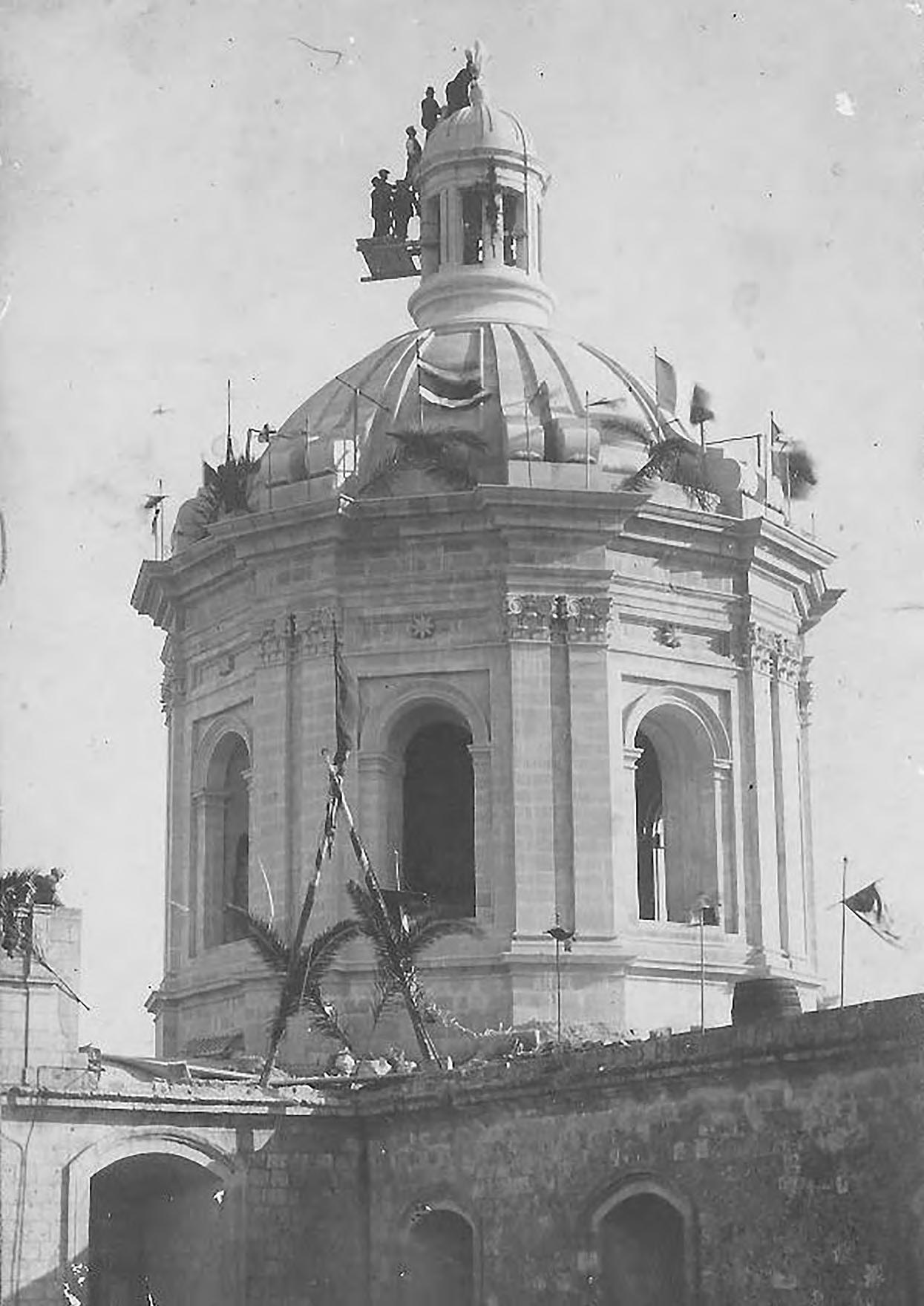
By the feast of Corpus Christi held in June 1925, the central nave of the church was operational and served as a church while what was left of the dome was dismantled down to the pendentives, the three vault ceilings damaged were repaired, and a new dome designed by Prof Robert Galea was rebuilt under his own direction. Restoration marble works were carried out to repair the main altar and other side altars while the titular painting was restored back to its old glory.
On Sunday 28th February 1926 the cross atop of the dome was unveiled in situ by Parish Priest Bonnici himself 7 and the entire church was re opened for public worship and blessed by HE Mons. Mauro Caruana, bishop of Malta at 6.30am of Sunday 10th October 1926. The day was full of liturgical activities whilst late in the evening the Count Roger band performed a musical program in the parish square followed by band marches in the streets of Rabat lit and decorated for this festive and joyful occasion 8
This extraordinary incident remained imprinted in the minds of those people who witnessed it. It was also widely considered as a miraculous intervention as it left no casualties and since it happened only a few hours before the church would have been filled with people attending for the aurora, the earliest mass of the day.
The story, only lost its thrill during the Second World War, when Maltese churches as many other buildings, were destroyed leaving deaths and destruction.
The commemoration of this incident, triggered by nature combined with human error, is a tribute to a relatively small community, whose love and dedication prompted it to focus all its efforts towards repristinating their old and historic parish church in a very short time.
7
8


MEMORJA is the oral, sound, and visual archive of the National Archives of Malta, set up to be the Maltese Islands’ main depositor of public memory. By employing cutting-edge research methodologies along with theoretical and archival approaches, MEMORJA seeks to collect, record, transcribe and preserve individual and shared/community memories, oral history and traditions, knowledge, and experiences. The objective is to make all this material available for research, interpretation and educational purposes.
Fieldwork had started in 2017 through face-to-face pre-interview meetings – the first of their kind for the National Archives of Malta – leading to the creation of networks in the community. These new relationships with individuals from different backgrounds allowed members of the public to share their stories with the Project through oral and video interviews and the donation of personal photographs, letters, film reels and artefacts. Given the opportunity to have their experiences documented for future research, these ‘partners’ are today addressing a lacuna often not found in official documentation and are thus providing more balanced and rounded perspectives on numerous historical themes and subjects.
Notwithstanding the Project’s staff shortages, 2023 proved to be as fruitful a year as any. Through continuous networking, fieldwork and marketing, MEMORJA continued to record and collect substantial quantities of oral history interviews, photographic materials and ephemera from both new associates as well as old friends who have dug up further fascinating documents relating to ongoing research themes.
Laying the groundwork for these meetings is just as important as the interview itself. The process of establishing a friendly relationship as well as getting to know the potential interviewee takes a significant amount of time – weeks could stretch into months of negotiations. This is followed by ethnographic notetaking which, in turn, simplifies the writing of a series of open ended questions. Ultimately, this helps both parties – interviewer and interviewee – in discussing public, personal and sometimes traumatic experiences with ease.
The past year’s fieldwork included personal stories linked to industry, the Second World War, healthcare, music and colonial politics. Ninety five year old Joseph Scerri had started working at HM Dockyard back in 1943 during war torn Malta. He reached pensionable age in 1987 and subsequently retired from his duties as an engine fitter. In between, he had seen the rise of trade unionism – which had spilled into militancy on certain occasions – the rundown of the British defence establishment, the privatisation of the dockyard and its nationalisation in the late 1960s.
Tony Pace’s love affair with music had started back when he was a child and has spanned the entirety of his adult life, best encapsulated by his mastery of the guitar. He was a mainstay of the local circuit in the 1960s, having played with numerous bands until he was contracted to play in a nightclub in London for a period in the same decade. He had joined the Armed Forces of Malta, played with famous musicians the world over, took part in various visits by foreign dignitaries, instructed musicians at the University of Malta, played in various catering establishments over the decades while also having found the time to double as a guitar teacher to a slew of guitar players who have gone on to have careers of their own.
Dr Herbert Lenicker’s collaboration with MEMORJA produced three interviews on two different themes. The 87 year old medical consultant was a child when the Second World War broke out. Notwithstanding the chaos and confusion which war often produces, this period in the young boy’s life was further complicated by his German surname. Apart from discussing the general interruption of the rhythm of everyday life, the younger Lenicker had endured taunts, discrimination and bullying at the hands of children who – innocently yet wrongly –believed that he had been an ‘enemy alien’. The latter issue was still prevalent in the doctor’s memories, nearly eighty years after. After finishing his medical studies in the early 1960s, the newly minted doctor had his first work experience in Santo Spirito Hospital, today hosting the Central Archive of the National Archives of Malta. He broke down the then hospital’s set up, the patients he had to take care of and the ailments he most had to deal with. From the mid to late 1970s, he was as the final acting superintendent of the Lazzaretto quarantine hospital on Fort Manoel. He emigrated to Australia to practice medicine and subsequently returned the following decade. These last two experiences make up the second and third interview subjects in Dr Lenicker’s collection.
Further interviews have been acquired through individuals who, by MEMORJA ’s good reputation and marketing efforts, felt confident enough in our team to preserve them and making them available to anyone and everyone wishing to access them. Donations of audio interviews by Mr Lawrence Ancilleri and Mr Vince Pulis, as well as others, reflect our efforts to strive for synergy with local communities in the preservation of lost voices.
The Malta Bus Archive continued with pre interview meetings with individuals who were in one way or another connected to the local public transport industry. Associating with these individuals like Joseph Farrugia, the last practitioner of tberfil, a form of pinstriping art on buses, who gave insight to a very specific aspect of its history and details of what the job entailed. The Malta Bus Archive also acquired around 400 images from the late Mr Dave Godly, henceforth known as the Dave Godley Collection, as well as other donations from transport historian Mike Fenton, all which date to between the 1970s and the 1990s.
Work on the Covid 19 theme has progressed at a steady pace, with new acquisitions of diaries and interviews from medical professionals, including Ms Roseanne Camilleri, CEO of Primary HealthCare. The interviews involve numerous topics, from the initiatives established by the Malta Government to a medical doctor’s experiences tackling Covid 19 on a personal level. These new acquisitions will help piece out the experiences of Maltese society from all walks of life, and how each tackled it in their own way.
Attempts at further strengthening the presence of fieldworkers is heavily restricted due to the severe shortage of team members working on MEMORJA. Attempts at reaching out for more potential interviews, photographic materials and ephemera have been reciprocated by individuals who in turn had initiated contact themselves.
In addition to oral histories, MEMORJA was successful in preserving hundreds of digital images, these being the collections of Jeanne Roffe Vassallo, Francesca Zammit, Gino Theuma and Mark Mifsud Bonnici.
Ms Jeanne Roffe Vassallo had loaned MEMORJA her late father’s original Second World War era photo album which he had compiled during his wartime service. In addition, Ms Roffe Vassallo also donated digital images of her father and her paternal grandfather: the architect duo of Edwin and Andrea Vassallo. The former had been a Government minister during Lord Strickland’s administration in the late 1920s, whereas the latter was the renowned architect whose claim to fame lies in the designs of – among other things – the Zammit Clapp Hospital in Sliema, numerous chapels at the Addolorata Cemetery, Villa Rosa in St Julian’s and the Basilica of Our Lady of Ta’ Pinu Basilica in Għarb, Gozo.
Francesca Balzan donated copies of her late grandfather’s photos which he had taken in the 1950s and 1960s. These consist of local soldiers’ portraits and photos of family get togethers and meals with his friends at his allotments overlooking Tal Ħandaq valley in Qormi. The last major collection MEMORJA received was from Ms Winifred Theuma, widow of the late photographer Gino. Gino Theuma made a living out of photography and during his career was employed with The Times, the Department of Information and the Malta Government Tourist
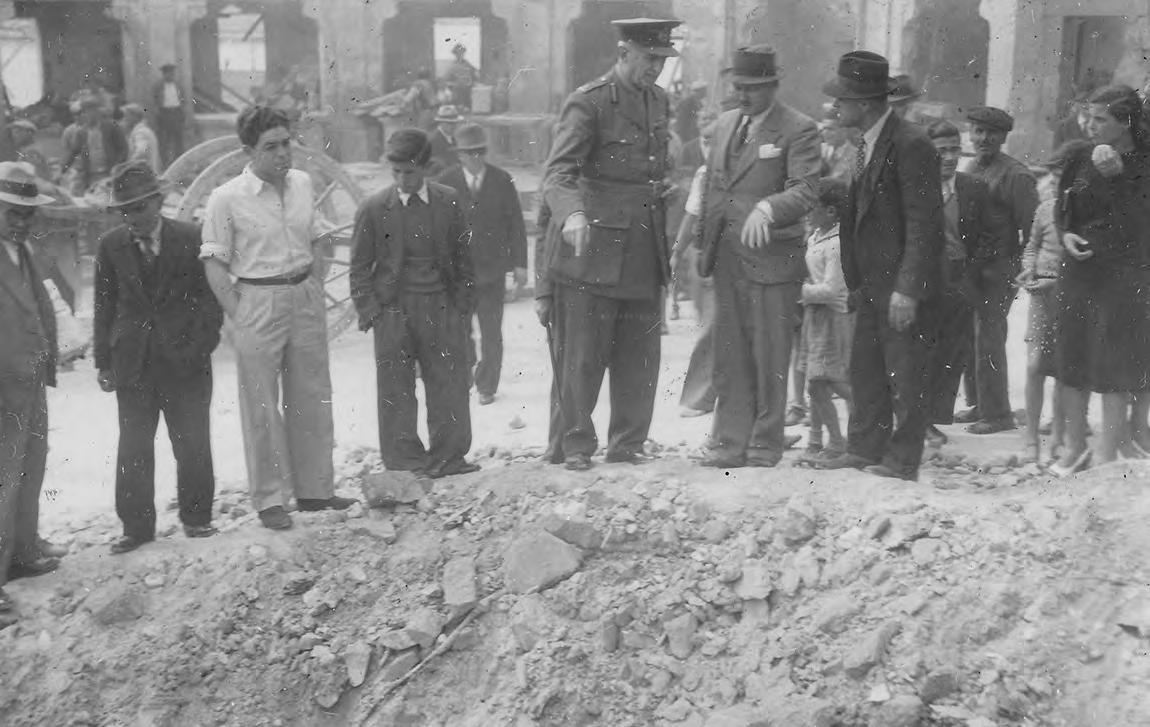
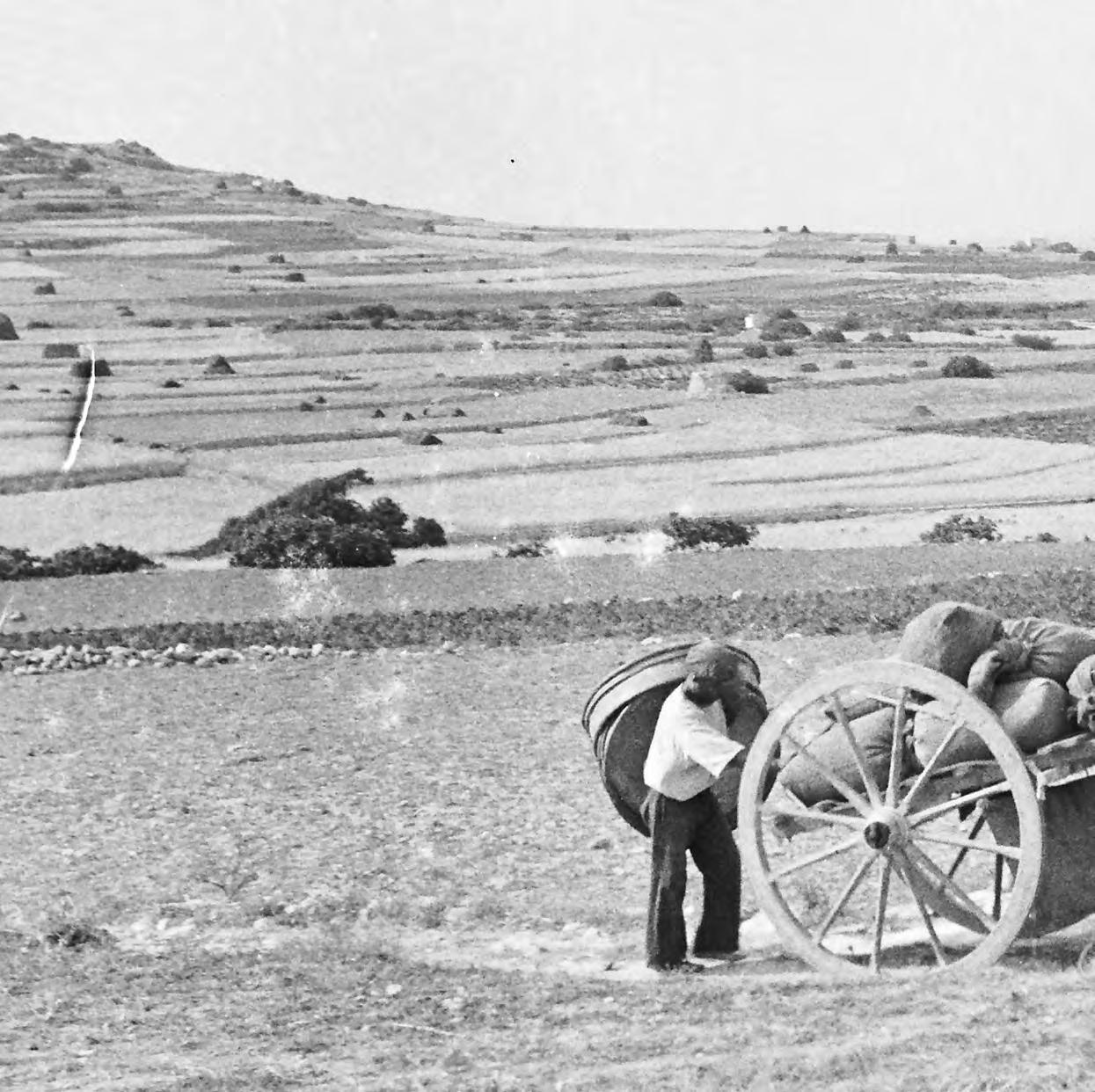
Collection.
Board. Gino managed to capture the social and industrial side of a country in transition from colonial administration to independent rule. He had covered all sorts of assignments: peasant agriculture, fishing, sports, political events and local traditions. His lens offers contemporary researchers a window into the recent past.
Collaboration between MEMORJA and the Mifsud Bonnici family had started back in the summer of 2017 when pre interview meetings were held with the late Maurice and Loulou Mifsud Bonnici. This married couple was later interviewed about their individual wartime

experiences. In 2023, their son Mark collaborated with MEMORJA in his father’s stead. Over the past year, countless hours were spent digitizing and curating ephemera, photographic materials and film reels that had been temporarily loaned to the Project.
The documentation collected concern an array of issues and agendas. Mainly, these can be split into two – those pertaining to Mr Maurice Mifsud Bonnici himself and those concerning his wife’s uncle, Mr Walter Salomone. The document timeline range between the 1910s and the 1970s and include significant coverage of the Second World War from the experiences
of a teenager – that is of Maurice – and of a serving officer in the British Army – Walter. The Walter Salomone documentation includes his personal papers as a Minister for Customs, Agriculture and Fisheries in the Strickland Cabinet between 1927 1930. They also include official documentation about the establishment of the Ta’ Qali Aerodrome; newspaper cuttings of certain canon events; official correspondence to and from London and, most prominently, official ‘Fortress Orders’ and reports from his time as Liaison Officer as a Captain in the 2 Btn. Royal Irish Fusiliers, stationed in the Mosta/Naxxar/Għargħur area. All these documents were kept in exceptionally good condition, considering that they are over eighty years old. Maurice’s documentation hosts diaries, newspaper cuttings, essays, letters, and files that reflected his career as an engineer, as well as an individual who was inquisitive and keen on learning. His diaries consist of an accurate recounting of air raids, bombardments, mishaps, deaths and daily life of the Malta during the Second World War, including the naval vessels that were anchored in the Grand Harbour. The collection also shows Maurice’s creative side, hosting a series of plays written by Maurice in his younger years; as well as his professional side as Chief Engineer and General Manager of TeleMalta and Chairman of Telecommunications.
This, along with the many already digitised material gathered prior, is a representation of how beneficial it is to remain in contact with donators and interviewees, since one interview could (and at times would) lead to an avalanche of informative, delicate, beautiful and rare material such as was this one.
A major achievement was the addition of new volunteers joining MEMORJA ’s ranks in conducting fieldwork. Academics, researchers and other individuals are now working on a Maltese Sign Language History project, an oral history of the local meat industry and the Thalidomide scandal in colonial era Malta. Their efforts, while being instructed by MEMORJA ’s academic advisor Prof. John Chircop, have proved to be instrumental in branching out to new thematic horizons while preserving new experiences from being lost.
MEMORJA also contributed to the publication“Mikiel Barbara: Bennej Prim tal-Karozzi talLinja,” the subject being frequent MEMORJA collaborator Mr Anthony Barabra’s father, a renowned expert bus builder who had left a legacy as one of finest tradesmen of his generation. Through his links, Ninu, had assisted in identifying new potential interviewees as well as relevant material to the Project.
Donated by Format
Mark Mifsud Bonnici Paper documents; Photographic Material Official correspondence
Diaries
Newspapers, Letters · Personal notes · Published literature · Postcards · Photographic material
Jeanne Roffe Vassallo
Francesca Zammit
Gino
Ninu Barbara Paper documents and items
Fabian Mangion Digital surrogate of paper documents
Anne Cuschieri Paper Documents
Diaries


Accession 2021 009G The George Azzopardi Collection
In the dynamic landscape of safeguarding and preserving the collective memory of the Maltese nation, the National Audio-Visual Institute (NAVI), which consists of several audiovisual treasures which fall within the remits of the National Archives of Malta, has employed an audiovisual archivist, Sabrina Calleja Jackson, to take on the comprehensive digitisation and cataloging of its diverse range of audio-visual material. The National Audio-Visual Institute (NAVI), which was initiated in 2021, was designed towards collecting, preserving, and managing audiovisual media with the objective of enhancing accessibility of Malta and Gozo’s National audiovisual heritage.
NAVI currently holds around 354,000 individual items. These consist of a variety of media from photographic slides, films reels, audio tapes, CDS and cassettes, to name a few. The primary role of the audiovisual archivist is to ensure the long term accessibility and usability of the materials for research, education, and entertainment. This goes without mentioning that the audiovisual archivist must abide by copyright and privacy laws, intellectual property rights whilst also keeping in mind the significant ethical considerations which play a vital role when dealing with wishes of donors, cultural sensitivity and ensuring fair access to collections.
During 2023 we witnessed the successful completion of several remits pertaining to audiovisual archiving. Cataloging remains at the heart of our archival mission and the creation of a comprehensive audiovisual cataloging template which includes up to date audiovisual metadata, organized according to image, moving image and audio. This meticulous process not only involves detailed descriptions of each item but also enriches metadata, providing invaluable context for historians, researchers and the public. The enriched metadata also gives more detailed information on the physical material to better understand the preservation and care of such items. This year, we also implemented strategies to enhance handling of audiovisual items which also brought new and improved equipment to enhance our archival processes. These include new workstations with up to date editing software along with physical digitisation equipment allowing for smoother and more advanced handling of our audiovisual material. We anticipate that the upgraded tools will contribute to the ongoing preservation efforts of our valuable audiovisual collections.
Highlights from this year’s accessions provide a captivating journey through the diverse and historically significant audiovisual items meticulously preserved by our team. This year, we continued the digitisation and inventory for one of the largest audiovisual accessions received to date – The Times of Malta Photographic Collection. This accession, which was originally deposited in 2022, has continued to see the Times of Malta’s photographic collection (photos dated between 1940’s and 2000’s) being conserved, rehoused into archival boxes, inventoried and digitised. The work carried out on this accession could not have been done without the help of a number of students and volunteers who have digitised and inventoried around 12,000 images consisting of 35mm negatives, 120mm negatives, photographic prints and newspaper cutouts. The digitised images are then uploaded onto an open source web based software where a volunteer works on the metadata and overall catalog.
Other highlights from 2023 also include raw TV production footage kindly donated by Simon Cusens who received the items from Ms Molloy (co producer with her husband Alan Murgatroyd) of a 1 video production in the UK titled ‘Convoy’ (Channel 4, 1994), including other pedestal/WW2 Malta media collected by Mr Cusens. The ToM display during Open Day 2023
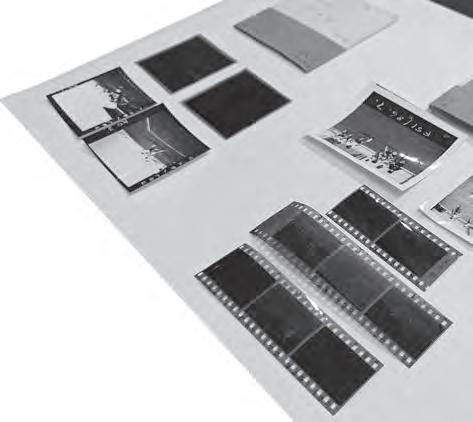


National Archives of Malta also received a donation of items ranging from photographic prints, negatives, artefacts and paper documents originally belonging to Giuseppe Galea (1911 1993), a Maltese sculptor who studied in Rome between 1933 1938. Among the noteworthy additions to our archives is the footage and reels capturing the film ‘Giuseppe’ (1972) by Cecil Satariano (1930 1996), Maltese filmmaker, which were kindly donated to us by Ms Veronica Galea. This valuable contribution not only enhances our comprehensive collection but also preserves the artistic legacy of Satariano.
Several milestones and challenges were encountered throughout the year, however, with the diligent efforts of our team we have managed to move forward and to make substantial progress. The past months have seen successful completion of projects which have been deposited in previous years, including the digitisation of several accessions received via our Gozo archives consisting of several mounted slides along with a beautiful magic lantern glass plate of a traditional Gozo boat (in Maltese: Dgħajsa tal Latini) at Ta’ Liesse in Valletta. In the background are passers by, horse drawn carriages and open warehouses including business signs, in French and Italian, above buildings. Also, the cataloging processes completed with the new audiovisual catalogue templates for several projects deposited in previous years to provide more metadata and accessibility of our expansive archival collections. This goes without mentioning the many other accessions kindly deposited to us by dedicated collectors, institutions and generous individuals passionate about preserving our shared history. A descriptive list of progresses performed in 2023 may be found hereunder:

Progress for items accessioned prior to 2023:
Accession title Description
The Times of Malta
Photographic Archive
Deposit by the Times of Malta through an agreement entered as of 19th August 2022 by and between the National Archives of Malta and Allied Newspapers Limited (C 308) of Times of Malta.
The Kevin Casha Private Deposit
The Guido Stilon Collection
Photographic positive slides created by the Kevin Casha Photographic Services Ltd. The collection includes studio and outdoor portraits, events of various nature, locations, natural landscapes, etc. The collection also includes photographs taken overseas.
The Guido Stilon Collection (Photography Positive Slides & Negative films). This Photographic collection includes portraits, personal and family photographs, festivities, transportation, trades, landscapes of the Maltese Islands, and numerous photographs of overseas locations, among others.
Progress
At the moment, around 12,000 negative photos, photographic prints and newspaper cutouts have been digitised. An inventory is being drawn.
Digitisation and cataloging in progress.
The Karmenu Fava
Photographic Collection
Private Deposit by George Azzopardi
Stan Fraser Collection
Veronica Galea
Private Deposit
The Karmenu Fava Photographic Collection. A photographic collection created along the career of photographer Karmenu “Charles” Fava. The photographs feature sports activities in the Malta, cultural heritage, society, trades, and more. The collection consists of negatives, slides and publications on which these photographs have been featured. This accession also includes the photographic equipment that was used by Charles Fava.
Several accessions deposited by Mr Azzopardi throughout the years. Audiovisual processing including negatives containing aerial photography, postcards, slides, photographic prints, magic lantern glass plate, etc.
A number of digitised Super 8 reels and digitised photographs containing WWII footage.
Digitisation (carried out by Dr Charles Paul Azzopardi) has been completed and cataloging in progress.
Digitisation and cataloging in progress.
Digitisation and catalogue completed.
Digitisation completed (coordinated by Ms Veronica Galea) and cataloging in progress.
Progress for accessions received in 2023:
Accession title Description
Tony Pace Collection
An album containing 7 Maltese Contemporary Folk songs originally composed by Tony Pace. The donation also received a score book with score music for the songs in this album. This accession is also part of the MEMORJA project.
Private Deposit by Simon Cusens
Anthony Hart Collection Lucy Hart private deposit Gozo Archives
Joseph Bezzina Collection
Louis Borg Manche Private Deposit
Private Deposit by Paul Edgar Micallef
Raw TV footage of a 1 hour production titled ‘Convoy’ including tape transcripts and other pedestal/WW2 Malta media footage (1940 1942). Raw TV production footage originally donated to Mr Cusens from Ms Molloy (co producer with her husband Alan Murgatroyd) of a 1 hour video production in the UK titled ‘Convoy’ (Channel 4, 1994) + other pedestal/ WW2 Malta media collected by Mr Cusens.
A number of photographic slides of Gozo and Malta taken by the late Mr Anthony Hart formerly Chief Architect in the Edinburgh City Architect Department, Scotland.
Records of the Boat and Ski Club as collected by Joseph Bezzina (father of the depositor). The deposit includs photographs, exhibition charts, minute books and accounts.
Progress
Received digitised and cataloging in progress.
MEMORJA have also interviewed Mr Tony Pace for oral history and have collected other ephemera.
Planning stages for digitisation and cataloging.
Photos of Sergeant Edward Briffa and cake for Coronation banquet accompanied with letters of appraisal and thanks for his services.
Digitisation and catalogue completed.
Planning stages for digitisation and cataloging.
Photographic slides used for tourist brochures. Planning stages for digitisation and cataloging.
Various records, photographs, photographic albums, loose records which were created by/belonged to Perit William F. Micallef and Perit Carmelo Micallef related to their work as architects and civil engineers.
Photos of Sergeant Edward Briffa and cake for Coronation banquet. Accompanied by letters of appraisal and thanks for his services on 3 seperate occassions.
Planning stages for digitisation and cataloging.
Digitisation complete and cataloging in progress.
Marie Vella Collection 2 albums containing 176 digitised photos. Digitisation complete and cataloging in progress.
Accession title
The Giuseppe Galea Collection
The Raymond Bonello Collection
Description
Photographic prints, negatives, artefacts and paper documents originally belonging to Giuseppe Galea (1911 1993), Maltese sculptor who studied in Rome between 1933 1938.
Family photos from Mr Raymond Bonello including photos of relatives who emigrated abroad, family portraits, religious portraiture (Holy Communion photos) and a photo of his Grandfather with a Maltese ox on his farm.
Progress
Digitisation complete and cataloging in progress.
Digitisation complete and cataloging in progress.
Gozo Archive
Photographic Slides of Gozo
The Jacqueline Formosa Collection
The Joseph Ellul Collection
Private Deposit by George Azzopardi
Colour photographic slides of Gozo taken during the late 1970s and early 1980s.
Passport and 2 photographic albums containing wedding photos and photos showing various generations of the family during family activities, outings and portraits.
Digital copy of Joseph Ellul’s photographic collection.
One 1915 photograph of HMS London at the Grand Harbour and two postcards; one picturing the Maglio Garden in Floriana (used). An another of the Entrance of the Grand Harbour, Valleta side (unused).
Digitisation and catalogue completed.
Planning stages for digitisation and cataloging.
Digitisation complete and cataloging in progress.
Digitisation complete and cataloging in progress.
Cachia Family Digital photo of actors and extra during the filming of “Pulp”
Emmanuel Mifsud Collection (Ghana)
Photo taken during filming of ‘Pulp’ in Malta in 1972 with distant views of Torri l Ahmar, Mellieha. Photo contains father of Henry Cachia and also includes actor Michael Rooney (second from right).
Deposit of 40 mp4 files (which only contain audio and no footage) from Mr Joseph Mifsud containing traditional folk music (ghana) by his late father ghannejj Emmanuel Mifsud (December 1921 – April 1983) amongst other folk singers.
Digitisation and catalogue completed.
Digitisation complete and cataloging in progress.
Charles Cronin Private Deposit
The Ernie Miller Collection
A digitised version of the footage which includes a 22 minutes 42 seconds clip of Malta (family film featuring John D. Cronin FRCS MP, Mrs Cora Cronin, Mstr Charles Cronin) including scenes of the Grand Harbour, HMS Eagle R05 (Audacious Class aircraft carrier), Squadron of three (Ton Class Minesweepers), etc.
This collection of digital photos, shot by Ernest William Thomas Miller during his posting in Malta (1951 1959)
Digitisation complete and cataloging in progress.
Digitisation complete and cataloging in progress.
Over the past year, we have welcomed a diverse group of individuals eager to explore the intricacies of audiovisual archiving. Volunteers, students and staff members from the National Archives, who are an indispensable part of our archival community, have contributed their time and passion to various projects, amplifying our archival efforts. As we reflect on the past year, we extend our gratitude to the students and volunteers whose enthusiasm and dedication not only enriched their educational experiences but have also played a crucial role in advancing our mission to preserve and share our nation’s audiovisual heritage. The students who chose to work with us gained hands on experience whilst growing their professional network. Volunteers who join us have a passion for history and preservation and gain the opportunity to learn and develop skills whilst forming part of an ever growing community. Flexible commitments help us to schedule duties and to make sure that certain work never stops within the production stages. Throughout 2023 the Malta National Archives, specifically NAVI, saw 5 volunteers and 6 students. This goes without mentioning other volunteers and students who were involved in other sections of the archives.
List of volunteers, dates and assigned work:
Francesca
Norbert


List of students, dates and assigned work: Name
Enkelejd Memetaj Internship from University of West Attica
Michaela Ehnle Internship Ludwigsburg University of Education
Maren Gerlinski Work placement Kalr Schiller Vocational College, Dortmund, Germany
Vit Zbranek SOŠ Luhačovice Vocational School Czech Republic
Katrina Zrinyova SOŠ Luhačovice Vocational School Czech Republic
Raisa Zammit Jobs Plus – Work Exposure Scheme
September 2022 –February 2023
March 2023 – May 2023
April 2023
May 2023
May 2023
The Times of Malta Photographic Archive
The Times of Malta Photographic Archive
The Times of Malta Photographic Archive
The Times of Malta Photographic Archive
The Times of Malta Photographic Archive
August 2023 current The Times of Malta Photographic Archive, The Guido Stilon Collection, The Joseph Ellul Collection
The Malta National Archives Staff who are directly working on NAVI projects:
Marlene Gouder May 2023 current The Guido Stilon Collection, The Raymond Bonello Private Deposit
Joseph Amodio August 2023 current The Kevin Casha Private Deposit
Our institute actively participated in a variety of events which gave us the platform to represent our departments to a wider audience. Collaborations with television programs allowed for the integration of historical footage which amplifies the impact of archival collections. These interviews not only showcased what is currently in hand but also generated an interest within the community and offered a platform where individuals felt they could easily come to us to discuss their audiovisual and archiving needs. A few such events which NAVI formed a part of throughout 2023 were the Public Service Expo in May, interview on One TV’s programme ‘Kumplimenti’ in August, the National Book Festival in October, initiatives such as interviews, news articles, etc, covering the partnership between the Times of Malta and the Malta National Archive’s in October, and the Malta National Archive’s Open Day in November. This goes without mentioning the number of visits we received where groups from various backgrounds were given the opportunity to tour the building and speak with representatives from every department.
In conclusion, this year encapsulated a year marked by significant strides in the preservation, accessibility and celebration of our nation’s audiovisual heritage. The collective efforts of our dedicated team, alongside the invaluable contributions from volunteers, students and external collaborators have pushed us forward in our mission. Following the successes of the past year we plan to keep this momentum and pave the way for future collaborations.
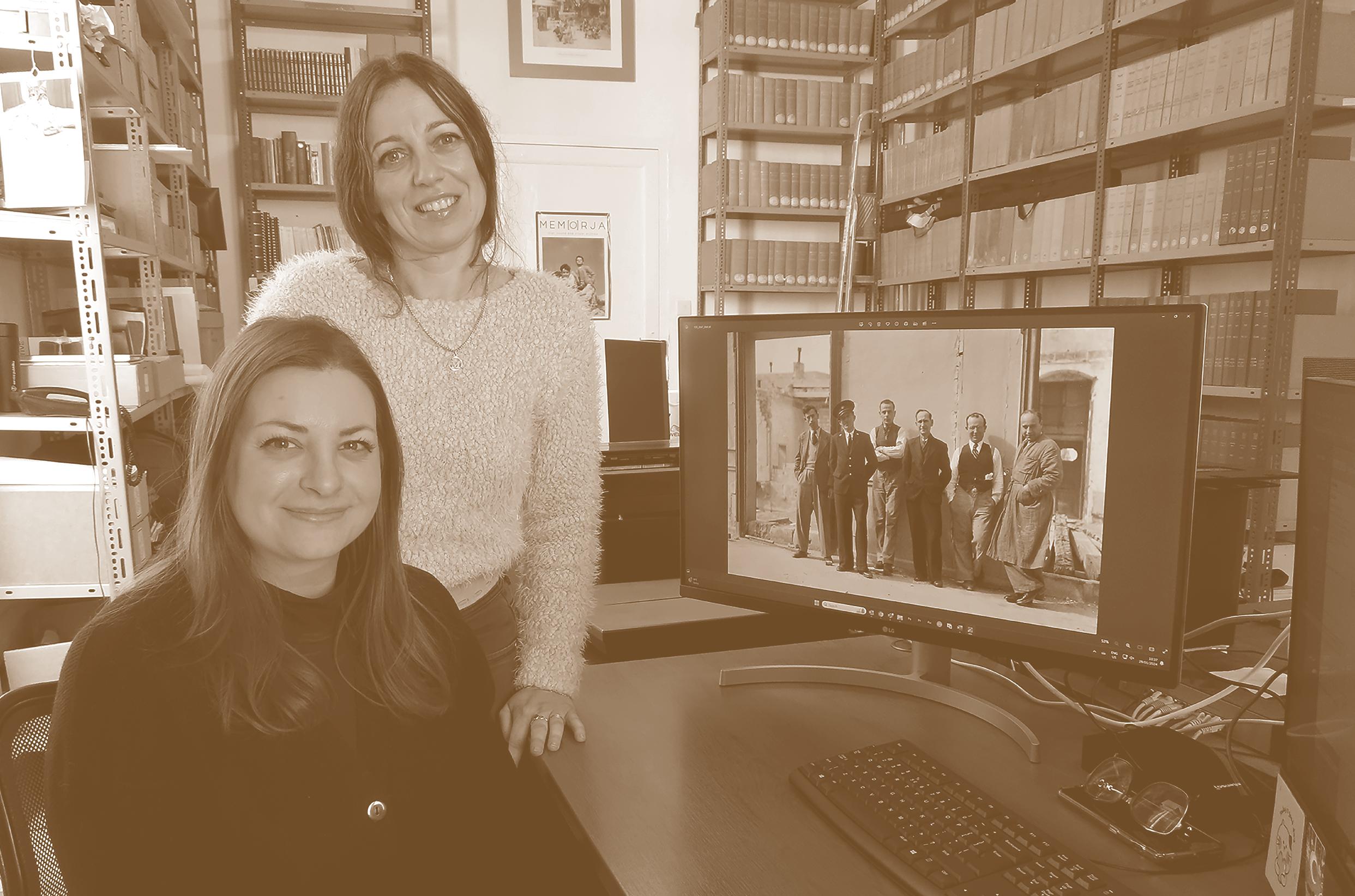

The National Archives Council is set up in line with Article 14 of the National Archives Act (2005), which stipulates that:
(1) There shall be a National Archives Council, appointed by the Minister, which shall be composed as follows:
(a) a Chairperson;
(b) the Superintendent of Cultural Heritage ex officio or his representative;
(c) the Chairperson of Heritage Malta ex officio or his representative;
(d) the National Librarian ex officio or his representative;
(e) the Permanent Secretary in the Office of the Prime Minister ex officio or his representative;
(f) a person to represent the non governmental archives or records centres;
(g) three other persons chosen from amongst persons known to be users of and familiar with archives, records management and information professions, or working in non governmental organisations dedicated to information and archives, one of whom shall be appointed by the Minister responsible for Gozo.
In line with the National Archives Act, during the year under review, the Council continued to fulfil the functions assigned to it by the Archives Act, mainly:
(a) to promote the National Archives and other record keeping entities;
(b) to ensure and facilitate the collaboration between the different stakeholders with direct or indirect responsibility for the protection and management of the archives sector;
(c) to advise the Minister on the management of archives in Malta;
(d) to draw the attention of the Minister or of any organisation or person responsible for archives to any urgent action that may be considered necessary for the better management of archives and records;
(e) to advise the Minister on any matter arising from the provisions of this Act and on any other matter referred to it by the Minister.
The President and Members of the Council are the following:
President
Prof. Raymond Mangion
Members
Dr Joan Abela
Dr Steve Borg
Ms Maroma Camilleri
Mr Mario Coleiro
Rev. Can. Dr Nicholas Doublet
Mr Kurt Farrugia
Mr Max Farrugia
Ms Judith Frendo Cumbo
Dr Lillian Sciberras
Mr Neil Spiteri
Ms Sarah Brincat acts as Secretary to the Council.
As in previous years, Dr Charles J. Farrugia, the National Archivist and CEO and Mr John Cremona, Assistant National Archivist for Gozo have attended all Council meetings and have also supported its work by regularly updating the Council on the working of the Institution.
During the time frame under consideration, the Council kept operational with regular meetings, often on a monthly basis. In terms of logistical operations, the Council started meeting at the offices of the Permanent Secretary for the Ministry for National Heritage, the Arts and Local Government at Old Bakery Street in Valletta. Following the reassignment of Permanent Secretaries due to a Cabinet reshuffle and alternative place to hold the meetings was identified. Currently the Council meets at the Notarial Registers Archive premises in St Paul Street Valletta, which following the legal changes in the Notarial Archives Act and the National Archives Act is now one of the repositories functioning under the National Archives.
In terms of the topics discussed during the last year, the following were the major point on the agenda:
• The need of a new building for the National Archives of Malta
• The need to expand the Gozo Archives in the area currently occupied by the School
• The preservation and accessioning of private papers
• The conditions of conservators
• The salaries and conditions of archival staff
The main topic of each meeting is the urgent issue of the new national archives building. This is an electoral manifesto measure and its urgency derives from the fact that following
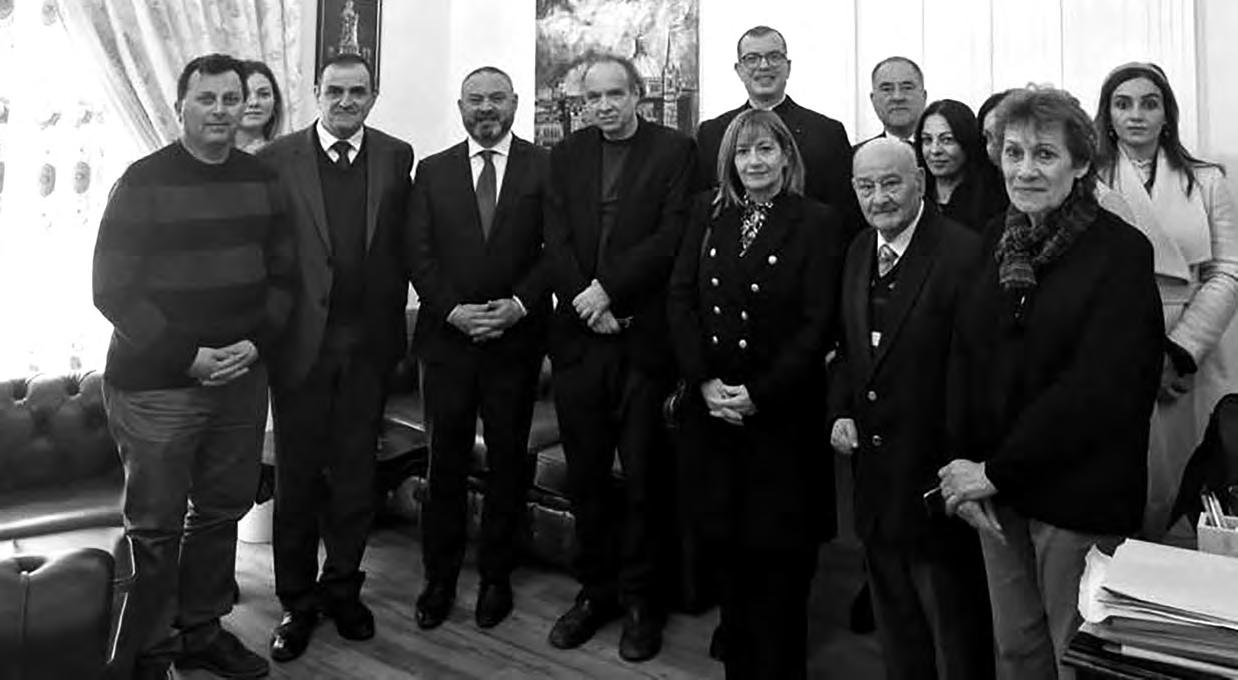
the public signing of a notarial deed to shift lands to the National Archives in Ta’ Qali, another Ministry took over the said land leaving the National Archives project pending. At each meeting, the President of the National Archives Council Professor Mangion makes a statement supporting the need of such a building and asking Mr Simon Abela, the MHAL advisor responsible for the project to update Council about the progress.
Throughout the meetings the National Archivist is also asked to update the Council about the developments happening at the National Archives. The main updates that the National Archivist gave during 2023 included:
• A new Collective Agreement for NAM employees
• The hiring of storage at private repositories due to lack of storage space
• Updates on the Open Day held at the National Archives
• The Acquisitions of Papers including those by Professor Henry Frendo and Albert Ganado
• The international activity of the National Archives
• The opening of the Notarial Registers Archives and an Agreement on its management
Two whole sessions were allocated for the presentation of the Annual Report of the National Archives of Malta. Members were presented with a hard copy of the document and the National Archivist summarized each section offering members the opportunity to ask and clarify any issues that they might come up with. The same report is presented to Parliament by the Minister for National Heritage, the Arts and Local Government in line with the provisions of the National Archives Act (Cap. 477).
The year 2023 was also a busy one for the Friends of the National Archives. This NGO set up in 2000 aims to support the National Archives of Malta through public engagement, sponsorships and educational activities. Its Executive Committee held regular meetings, almost monthly and the main topics discussed were: the compilation of the annual Journal L Arkivju; the participation at the Book Festival; the promise by Government to build a new national archives for Malta; procedures that have to do with Banking and our status as NGOs registered with the VO office; attempts at establishing stronger relations with the Maltese library association MaLIA; the Open Day that the National Archives organized in November; the forthcoming 25th Anniversary Celebration of the association and potential sponsorship of purchase of records.
During this period the Executive Committee was made up of:
• Dr Evelyn Pullicino President
• Dr Charles Farrugia – Vice President (in line with the Statute)
• Ms Marica Camilleri – Secretary
• Ms Mary Anne Farrugia – Assistant Secretary
• Ms Doris Zammit – Public Relations
• Dr Gerald Bugeja Treasurer
• Mr Martin Hampton – Membership Secretary
• Ms Danica Abela – International and Social Media Officer
• Prof George Cassar – Education Officer and Editor


As in previous years during 2023 the FNAM published the Journal Arkivju. This year’s publication featured articles about archivistics as well as articles which have been written from sources found at the National Archives and other archives in Malta or abroad. This publication is usually timed to be available during the Malta Book Festival. This year instead of the usual stand the Friends of the National Archives shared a stand with the National Archives, which allowed for more exhibits, interaction with the public and educational activities. The outcome was positive.
Throughout our interaction with the public the Committee continued to emphasize the important that Government keeps its promise and invest in the building of a national archive repository that make it possible to preserve our memory for future generations. This in particularly was emphasized during the Open Day organised by the National Archives on 26th November 2023.
Another initiative was targeted to strengthen collaboration between stakeholders working in the LIS in Malta. The Committee of the Friends of the National Archives met with the representatives of the Malta Library and Information Association (MaLIA). The aim of the meeting was to increase collaboration between the two NGOs.
One of the aims of the FNAM rganization is also to support the efforts of the National Archives of Malta in its efforts to purchase private records that have national significance. During the year the FNAM was approached by the national archivist and asked whether they will be willing to fork out the necessary sum to purchase a collection of national significance which formed part of the Albert Ganado archives. The records in question were created by the Comitato Permanente Universitario and covers the years 1908 1923. The holdings that are made up of several volumes will fill a gap when it comes to the comprehensive history of this body which later became what today is known as the Kunsill Studenti Universitarji (KSU).
2025 is the 25th anniversary since the setting up of the FNAM. Activities are in the pipeline for this celebration. During the coming year the Friends of the National Archives plans to carry on with its campaign for a new National Archives building, as well as other activities which help to raise awareness about the role which archives play in preserving the Maltese cultural identity.
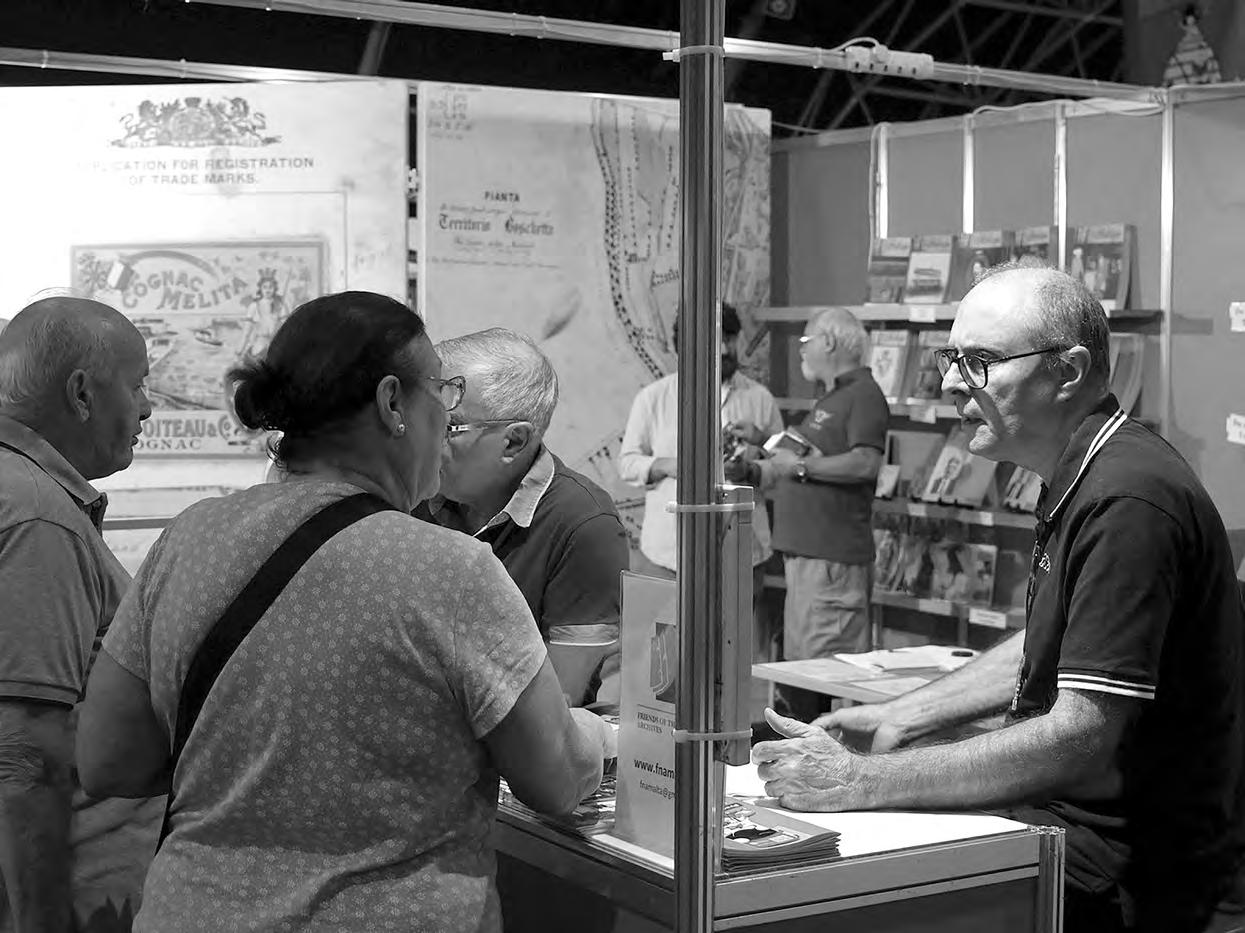
During 2023, a number of volunteers gave their services for free to the National Archives of Malta. Besides those who have been “resident” volunteers for a number of years, during 2023 we had new generous individuals who assisted us on a number of projects.
We would like to express our gratitude to these persons:
• Danica Abela
• Maria Elizabeth Azzopardi
• Dione Azzopardi
• Alfred Bezzina
• Mary Buttigieg
• Mariella Cachia
• Pauline Cassar
• Marlene Cefai
• Edwin Debono
• Marlene Debono
• John Deguara
• Mark Farrugia
• Dione Gatt
• Norbert Gingell
• Martin Hampton
• Marsha Iaci
• Twanny Mifsud
• Vince Pulis
• Mevrick Spiteri
• Skye Vassallo
• Laurence Zerafa
• Raisa Zammit
We extend our gratitude for your invaluable contribution. Your commitment inspires us in our mission to preserve and promote the rich tapestry of our memory and identity. Your efforts have made a difference within our organization and profoundly impacted the broader community.
Whether you dedicated your time to organizing events, assisting with projects, helping at the Annual Meeting, or spreading archives awareness, your passion for our cause shines brightly and inspires us all.
We are deeply thankful for your willingness to give your time and energy to support our shared goals.
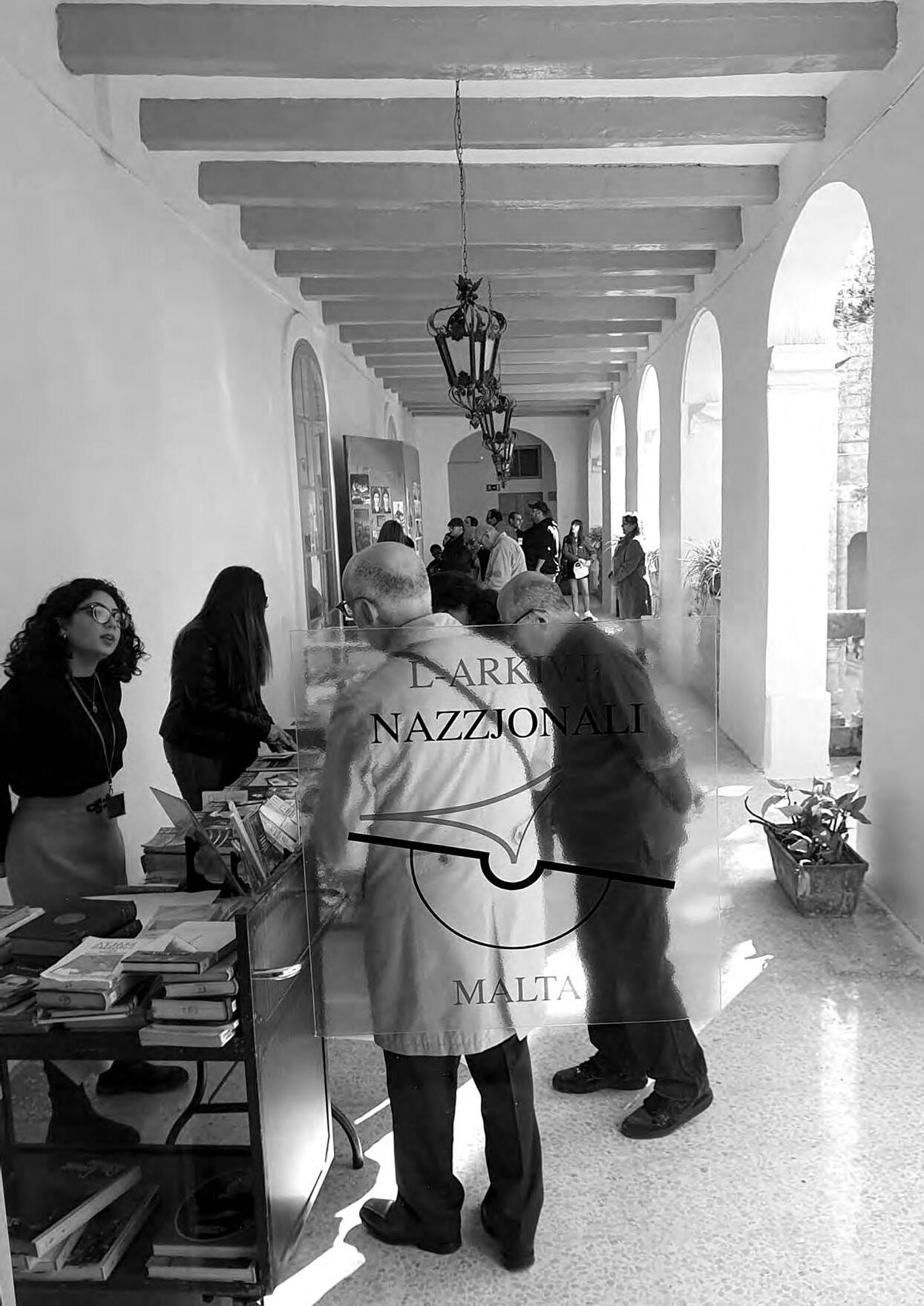

The use of Artificial intelligence within archives and its impact were discussed at a meeting of the European Archives Experts Group held in Madrid on 5 October 2023.
The 8th International Symposium entitled “Ensuring Dignity for Archives and Archival Services,” was organised by the International Institute of Archival Science, Trieste Maribor at the Alma Mater Europaea, Maribor, and online. The Maltese perspective on this topic was presented by our national archivist.
During the month of April national archivist Dr Charles J. Farrugia was invited to deliver a series of lectures on archives at the Scuola di Archivistica of the Universita’ degli Studi di Firenze. Projects managed by the National Archives of Malta such as Memorja were also presented during these sessions.
It was also a golden opportunity to build collaboration between the Historical Archives of the European Union that operates from Villa Salviati in Florence and the SAGAS Department of the University of Florence. In fact, Dr Farrugia organised a tour of the said archives for his Italian students.

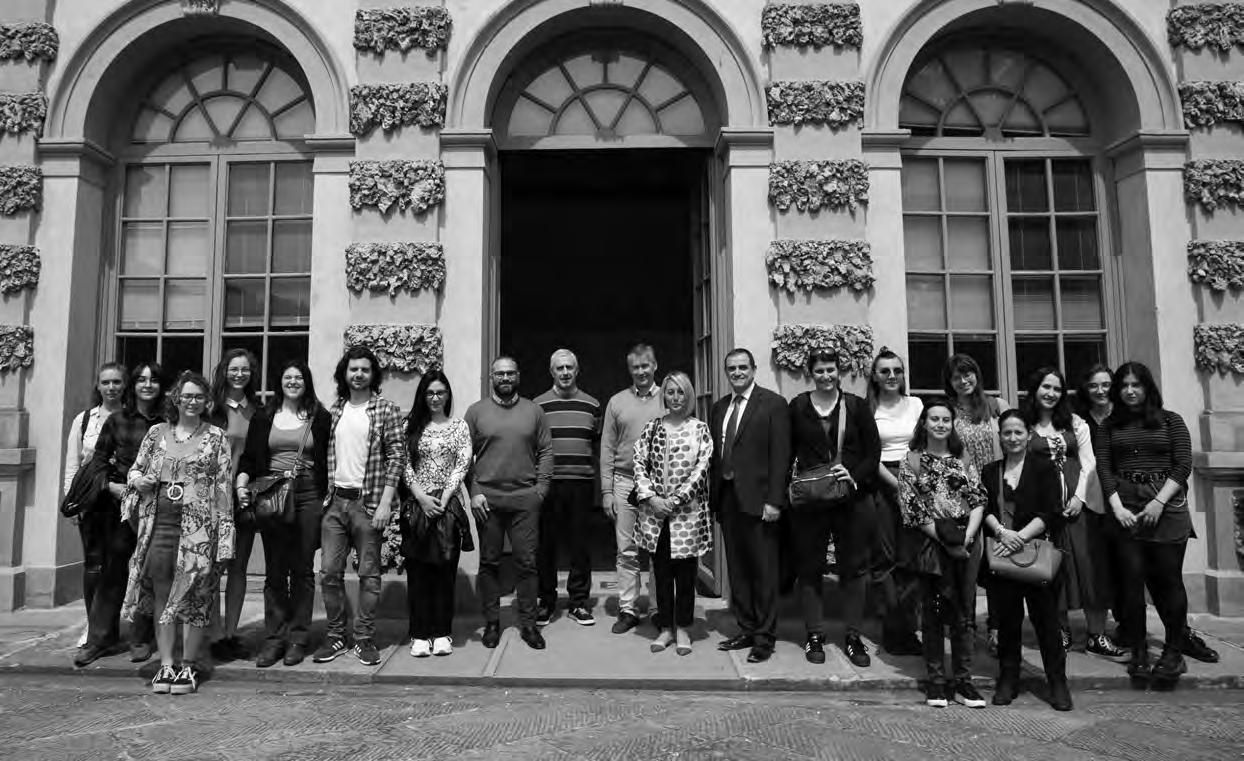

Malta participated in the European Archives Experts’ Group Meeting held at the Van der Nootska Palace, Stockholm. The morning session was devoted to the strategy discussion that was started at the Oslo meeting. The meeting discussed the European Collaborative Cloud for European Heritage. This initiative for a digital infrastructure that will connect cultural heritage institutions and research organisations across the EU is supported by the Commission Directorate General for Research and Development (RTD), through the Horizon Europe Research and Innovation programme.
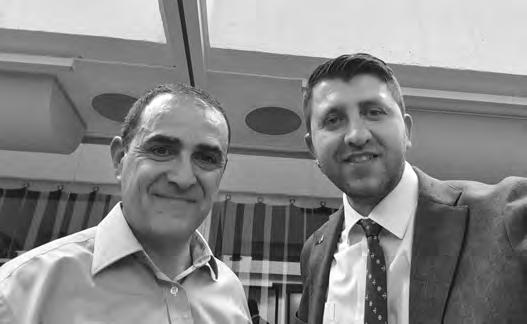
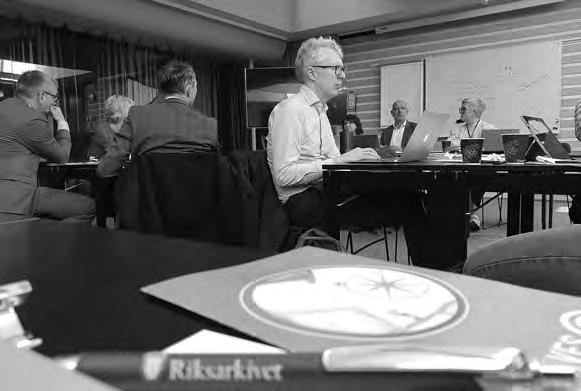
The second day was allocated to the European Board of National Archivists with an opening address by Karin Svanborg Sjövall, State Secretary to Minister for Culture. The role of the National Archives in Sweden was discussed by Karin Åström Iko, Director General of the Swedish National Archives. The meeting also celebrated the acceptance of the Swedish Freedom of the Press Act of 1766 document in the Memory of the World Register. Other interesting presentations dealt with the way national archives describe themselves and their mission, and enhanced preservation during a time of crisis. Delegates also had the opportunity to hear a first hand update on the situation of archives in Ukraine from Anatolii Khromov, Head of the State Archival Service of Ukraine.
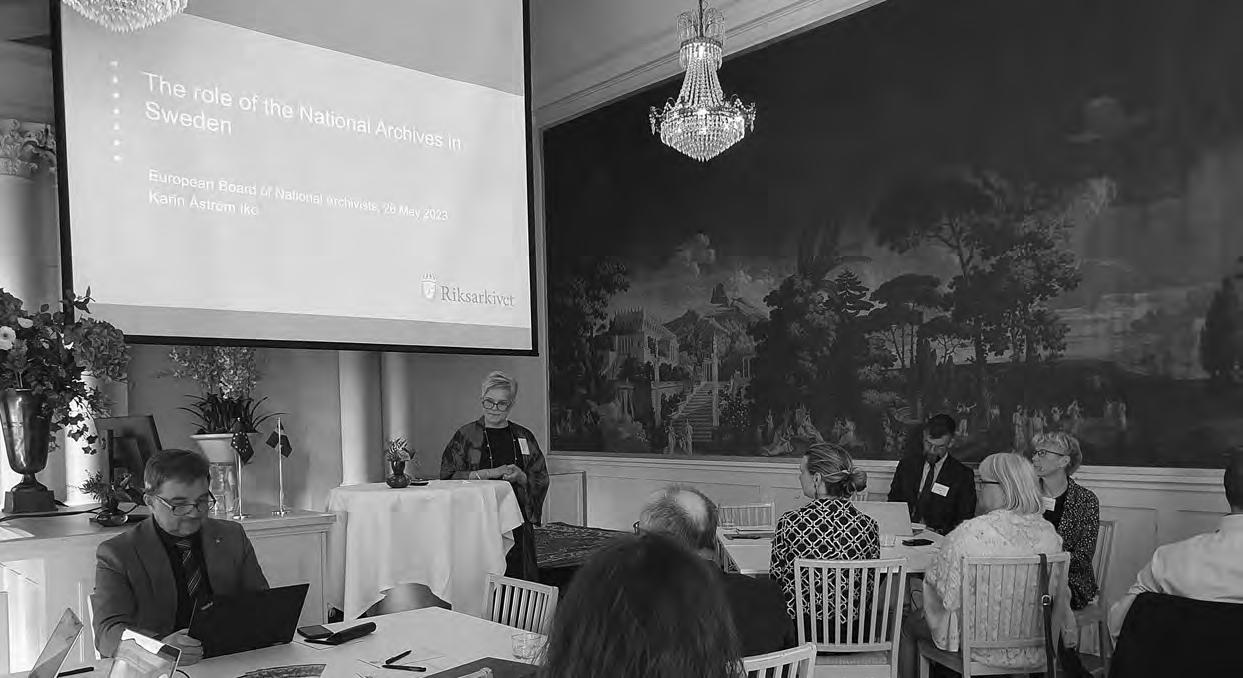
As part of the initiatives taken by the Presidency of EURBICA that up to last year was chaired by National Archivist Dr Charles J. Farrugia, a series of online lectures were organised. One of these focused on the EU funded project “The European Digital Treasures Project (EDT)” which lecture was delivered by Karl Heinz from ICARUS.
Presentation by national archivist Dr Charles J. Farrugia entitled “Archives, Personalities and Institutions: Italo Maltese relations over the years” at the International Conference in honour of Professor Laura Giambastiani entitled ‘Archivi e Archivistica’.
One of the landmark achievements during 2023 was the completion of the Digitisation of the Tribunal Armamentorum under a project by the Malta Study Center (MSC) of the Hill Museum and Manuscript Library (HMML). This milestone was celebrated through an online event during which speakers Dr Daniel Gullo, Mr Liam Gauci and Dr Charles J. Farrugia explained the fonds, the project and its significance to those studying Maltese and international history.
A discussion was held coinciding with author Martha Cooley’s visit to Malta. The panel made up of doctoral student Marica Camilleri, Head of the Communications Department at the
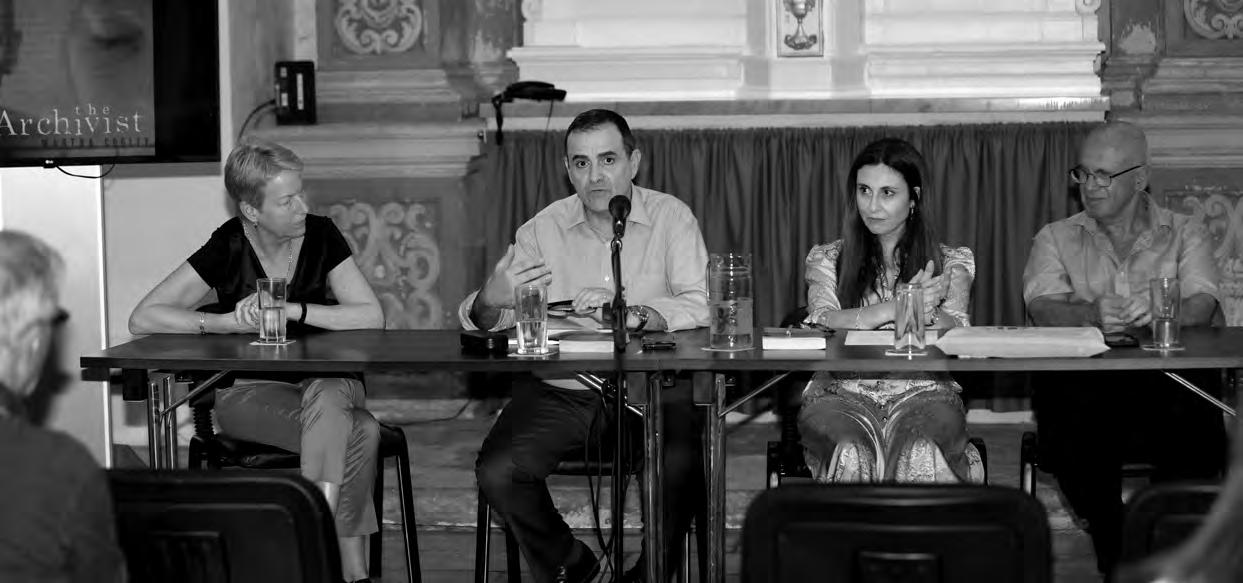
University of Malta Professor Ġorġ Mallia, author Martha Cooley and national archivist Dr Charles J. Farrugia discussed the book ‘The Archivist’ and its relevance to the real life of the archivist in the post Covid 19 realities.
Under the leadership of Dr Farrugia, EURBICA organised another online lecture entitled “Safe Havens for Archives”. The lecture was delived by Sahar Ammar, Program Officer (Dealing with the Past) within Swisspeace.
As part of the Spanish Presidency of the EU the National Archives of Malta participated at the European Archives Experts Group and the European Board of National Archivists that were held in Madrid. The National Archives of Malta was represented by Leonard Callus, Community Engagement Manager.
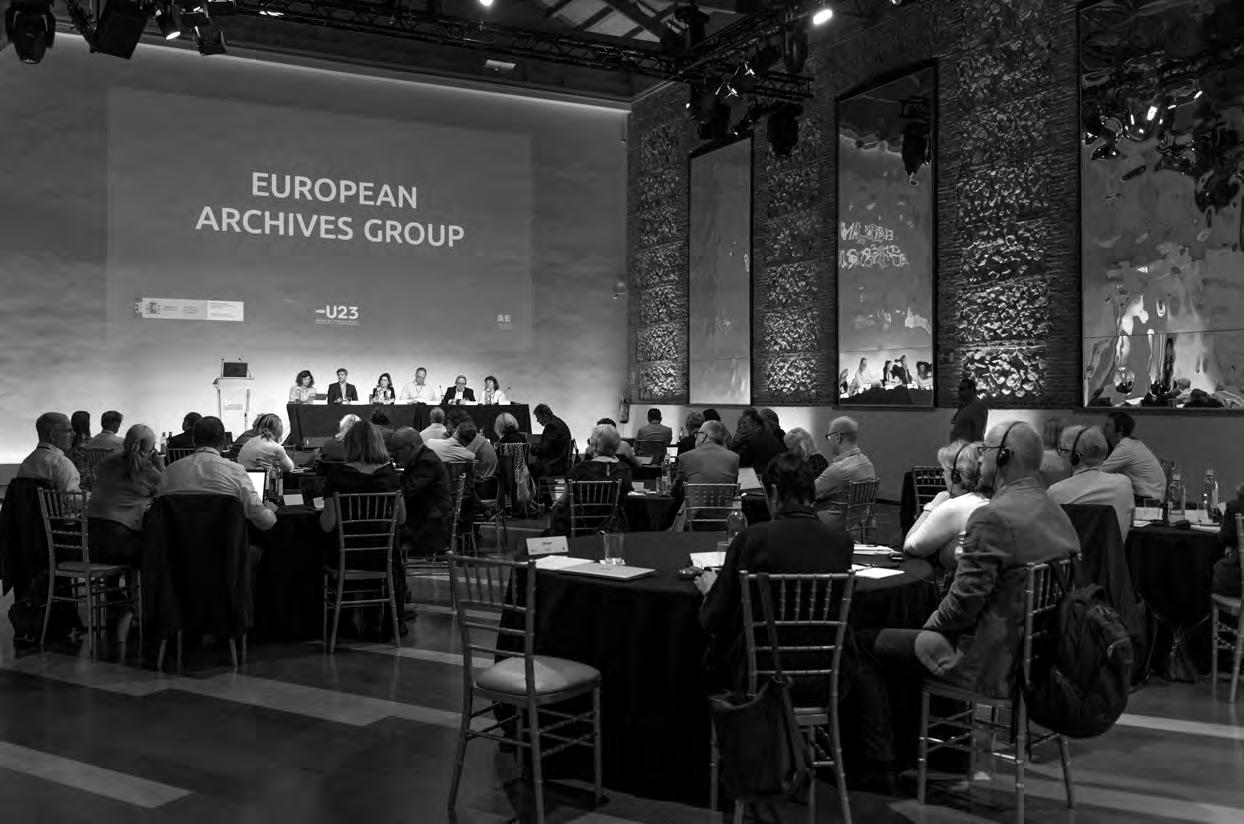


The International Congress on Archives was held in Abu Dhabi, UAE, between 9 – 13 October 2023. It brought together more than 3300 participants from 140 countries. The main theme of the Congress was ‘Empowering Knowledge Societies’. During this Congress national archivist Dr Charles J. Farrugia presented a paper entitled ‘The Right to Be Remembered: from a legalistic to a humanitarian perspective’.
The EURBICA General Assembly was convened on Monday 9 October 2023 as part of the preliminary meetings prior to the International Congress on Archives held in Abu Dhabi. This was the last session chaired by Dr Charles J. Farrugia as the General Assembly of the ICA convening in Abu Dhabi appointed him as Member on the Evaluation Commission of ICA.
ICA President Josée Kirps congratulating Dr Farrugia on his new post within ICA.

The National Archives of Malta is an active member of the Document Lifecycle Management Forum (DLM) and in the past has also hosted its annual meeting in Malta. During this year’s event which was held in Salamanca Spain, the institution was represented by Kevin Buhagiar, IT advisor.
Dr Charles Farrugia participated in the ICARUS 31st Convention held in Skopje and Ohrid. During this event the National Archivist discussed the over two decades experience of the National Archives of Malta in dealing with external organisations entrusted with the digitisation of Maltese archives.
During a visit to Cardiff as part of his CPD obligations in the Financial sector, Manager Michael Zammit Munro had an orientation visit to the Archives in Cardiff.
Our last international commitment for 2023 was an online paper deliver by Dr Farrugia during the ‘Digital Archives Seminar 2023’ entitled ‘Higher Eduction, Science, Research and Innovation Archives’, organised by the National Research Council of Thailand and Sukhothai Thammatheirat Open University in Thailand. The topic of the presention was ‘Best Practices of Digital Archives in Malta: The Case of the National Archives’.
Dr Farrugia addressing the conference in Thailand virtually.

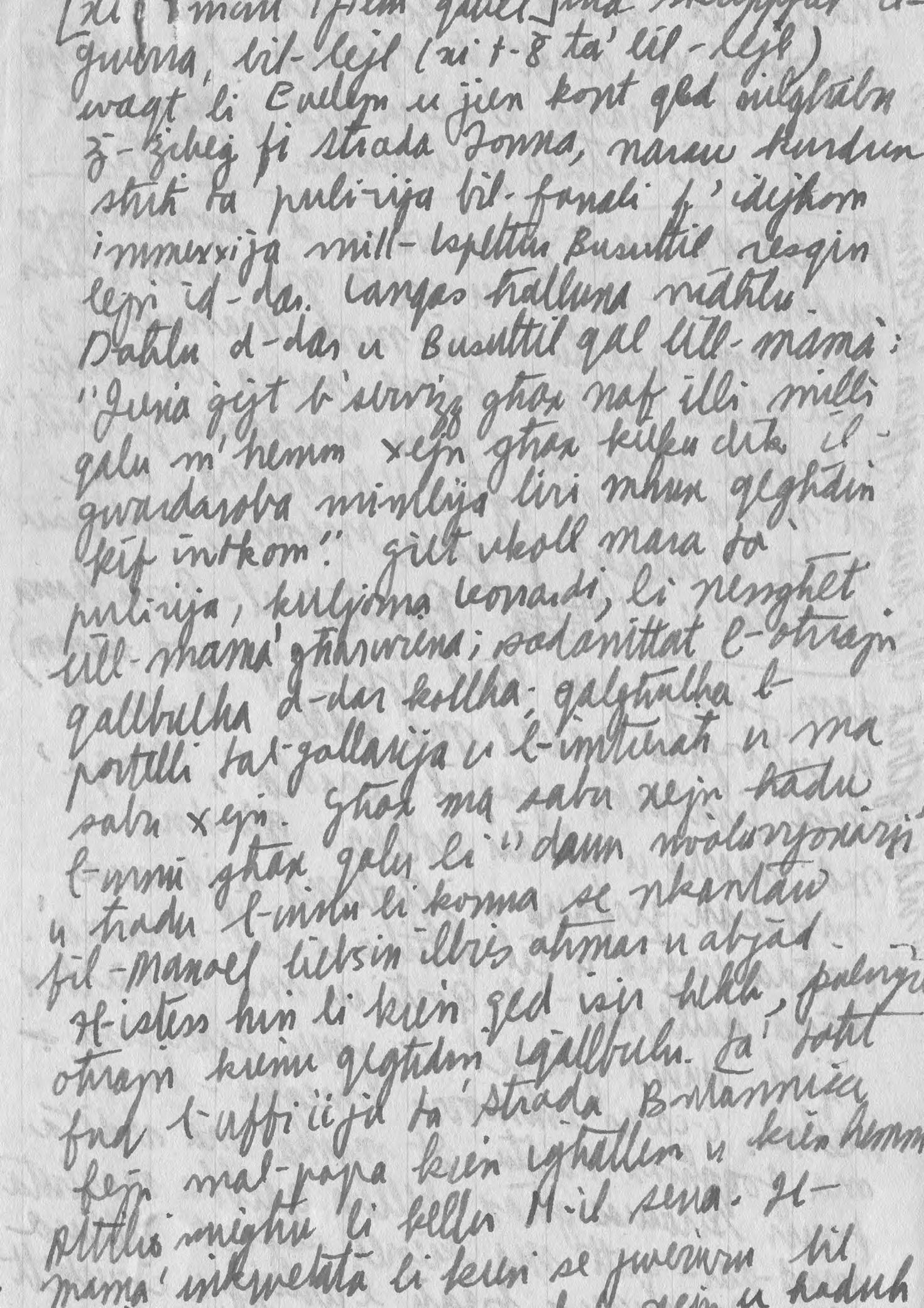
Notes written by Sylvia
describing her childhood experiences. These form part of the records donated by
to the National Archives of Malta on 15th February 2023.

18
The first of a number of visits by Year 8 students from St Thomas More College, Żejtun. During these visits we discussed the role of the National Archives, the various tasks that we do and what type of research can be carried out from our documents. We believe that awareness about the Archives should start from school. The other visits by these students were held on 19 and 26 January as well as on 1 February.
Year 10 students from St Paul’s Missionary College visited us as part of a career exposure experience. The students were addressed by Joseph Scerri, Manager at the National Archives and former student of the same college.
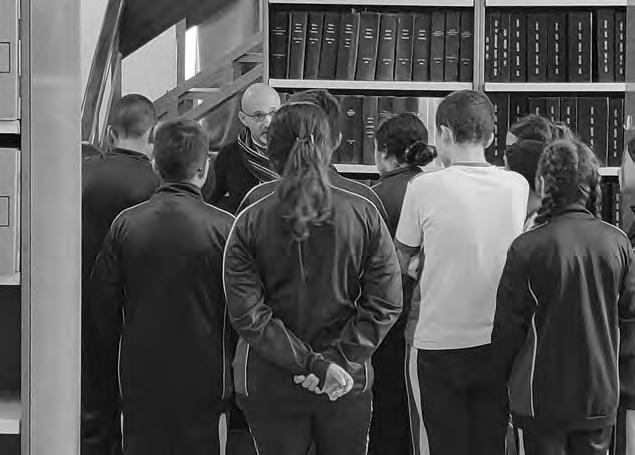

19
Ninu Barbara donated of a copy of his book Mikiel Barbara: Bennej Prim tal-Karozzi talLinja to the National Archives. In October 1931 Ninu’s father, Mikiel Barbara ta’ Żagrag (1906 1987) left his employment building horse drawn carts and joined Frenċ Saliba to start building buses. Ninu has already donated Mikiel’s handwritten memoires as well as an interview, notes and photos to MEMORJA project within the National Archives.
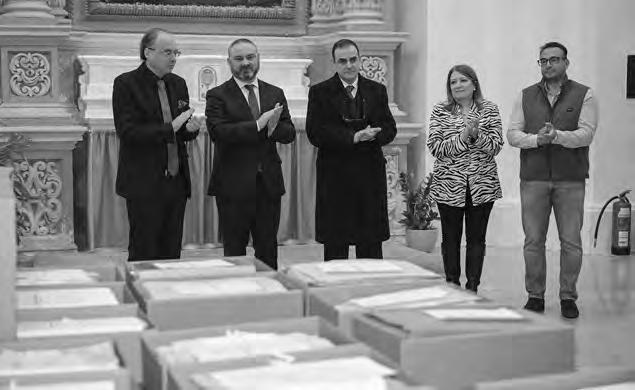

We celebrated the acquisition of a number of records from the Albert Ganado Collection. The main feature of this acquisition is the Sir Adrian Dingli’s papers. Sir Adrian Dingli (1817 1900) was a key Maltese figure during the first 100 years of the British period. Besides an eminent legislator and judge, he was perhaps one of the finest statesmen Malta has had. Some called him the “de facto Governor of Malta”. The British Government entrusted him with delicate diplomatic missions in Italy, in Cyprus and Tunisia. This acquisition includes also records related to the Bonavita family, Emmanuele Mizzi, Paolo Testaferrata Abela, Alfredo and Federico Caruana Gatto and Albert Laferla. 31
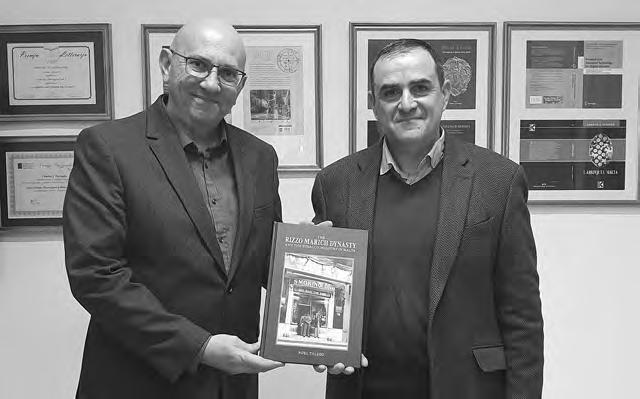
Noel Toledo donated a copy of his book The Rizzo Marich Dynasty and the Tobacco Industry in Malta. The book deals with Malta’s rich history in the tobacco industry. Although a small island, Malta was a big player in cigarette manufacturing, providing for both the local market as well as for export. In writing this book, Mr Toledo made use of records from our archives.
Principal Permanent Secretary Tony Sultana has visited the Gozo Archive, together with Permanent Secretary Joyce Dimech.


15
During a ceremony presided by Minister Owen Bonnici, we celebrated Henry Frendo’s donation of a collection of his records to the National Archives. This collection is made up of notes, interviews, research papers, photos and audio recordings related to the history of Malta during
Professor John B. Pace donated a collection of 29 letters written during the Gozitan insurrection against the French in 1798. Most of the letters, that are kept at the Gozo Archive, were written by Archpriest Saverio Cassar as the Head and Superintendent General of a provisional government set up to govern the Island during one of the most interesting and tumultuous periods of the recent history of Gozo.

the last 200 hundred years. Prof. Frendo is a professor of modern history at the University of Malta. His main areas of research include imperialism, nationalism, decolonisation, postcolonialism, journalism, migration and ethnicity in Central and Eastern Europe, the Mediterranean as well as the Middle East and North Africa.
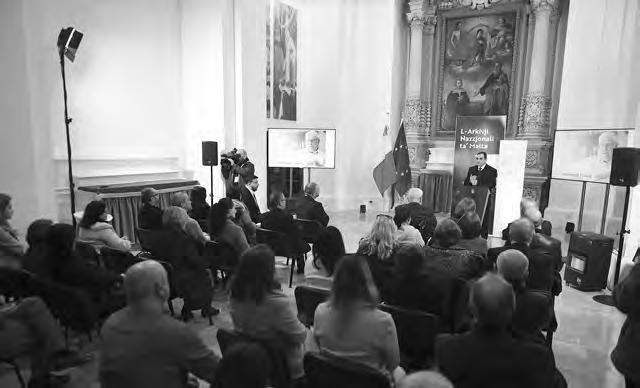


24
Photographer Kevin Casha donated his slide collection, made up of over 8,000 items, to the National Archives. Kevin is a fellow of the Royal Photographic Society, a highly awarded Maltese photographic artist and tutor with career in photography spanning over 40 years.

20
Principal Permanent Secretary Tony Sultana visited the Central Archive. During his visit we discussed our work and the challenges we are facing. We thank Mr Sultana for his support.
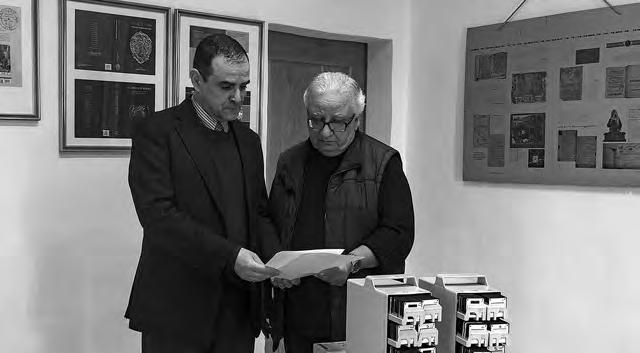
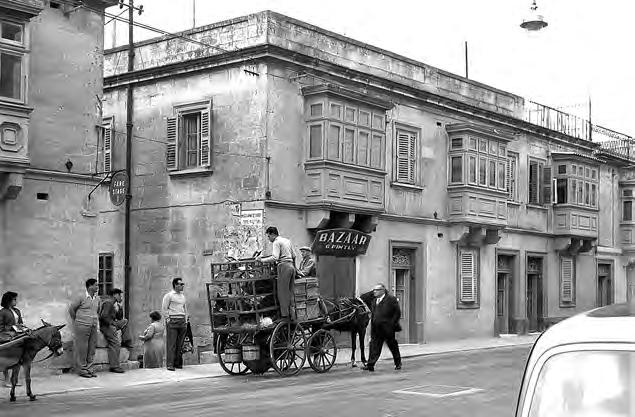
The National Archives of Malta organised another Narrative History course, led and co ordinated by Prof. John Chircop. These courses are provided to persons who eventually will conduct interviews on behalf of the MEMORJA project. These volunteers are critical in our attempt to gather oral histories.
10
Barry Miller donated a digital copy of photos of Malta in the 1950s, shot by his father Ernie while stationed here. Ernest (Ernie) Miller worked for the British Government as an electrical and mechanical engineer in the Ministry of Defence and lived with his family in Malta between 1952 and 1959. His son Barry was born in Malta in 1955.
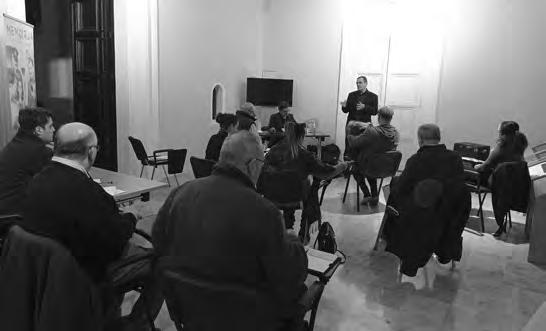
Researcher Jefferey Sammut donated a copy of his book Malta War Occurrences: The Police Logbooks 1940-1942. This book is developed following extensive research into police stations’ records covering the first years of WW2 providing a fresh perspective, namely the civilian population’s experiences during that major upheaval.
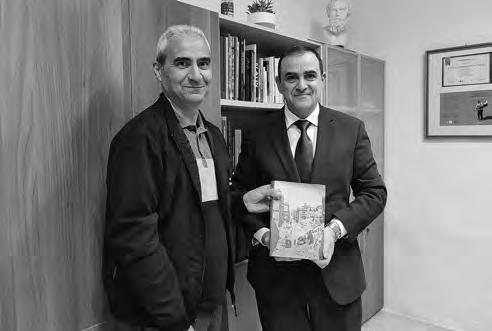
12
Lucy Hart donated a collection of slides of views of Gozo dating from the 1960s to the Gozo Archive. The slides were taken by her late husband Anthony Hart who

was the Chief Architect in the Edinburgh City Architect Department, Scotland. He visited Gozo for the first time about fifty years ago for a holiday and continued to visit Gozo every year until he eventually settled in Gozo.
We hosted students reading for a Master of Science in Tourism Development and Culture within the Erasmus Mundus Joint Masters’ programme. During the visit, the students had the opportunity to discover more about the archives and the different tasks we carry out.
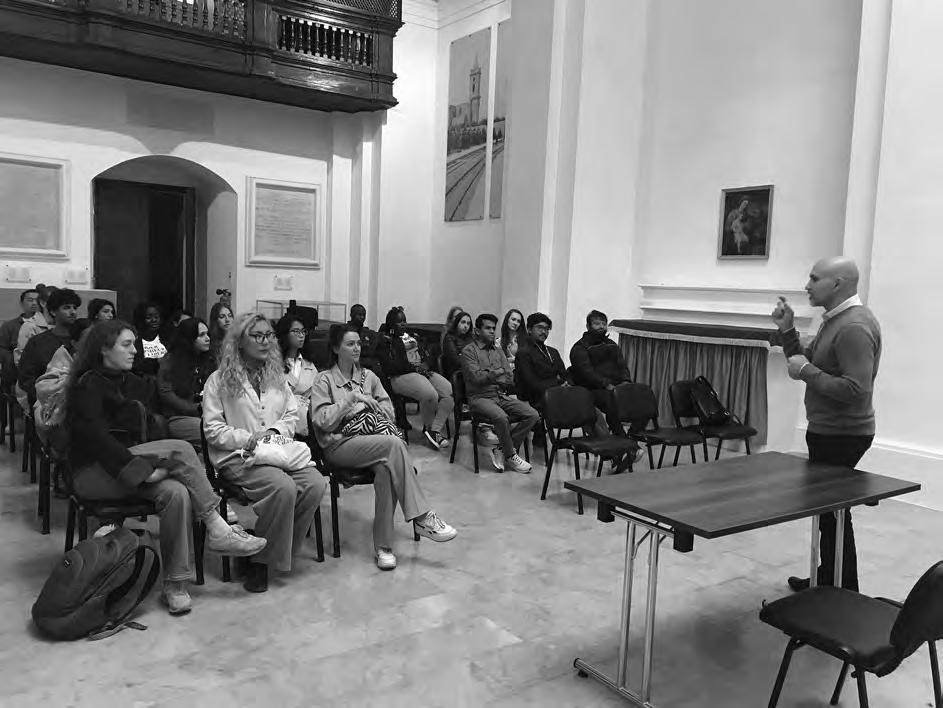
Maria Borg and Chanelle Mifsud Briffa, conservators working on the Notarial Registers Archive collection, participated in a two day workshop in the Netherlands focussing on paper identification with paper expert Amelie Couvrat Desvergnes. Their participation in this workshop was supported by the Malta Arts Fund.


12
Revisiting memories! Dr Herbert Lenicker and his daughter Erika Micallef visited us at our main office in Rabat. Dr Lenicker used to work here at the time when the building still served as Santo Spirito Hospital.
5
The Collective Agreement (2021 2025) covering the National Archives employees was signed. The National Archivist signed on behalf of the National Archives while Zvetlana Pace signed on behalf of the employees. Mario Sacco and Isabelle Farrugia signed on behalf of the UĦM, Voice of the Workers.


One of a series of visits by 72 students from the Sacred Heart Minor Seminary School in Rabat Gozo at the Gozo Archive.
26
We played our part during conference held at the Verdala Palace, as part of the L-Ilsien Malti għal Qalbi campaign, Noel D’Anastas, on behalf of the National Archives, discussed various aspects of our language with four other speakers. During the second part, a discussion about challenges associated with the use of Maltese was held.


The exhibition Decadence Now organised by the project City of Art, was inaugurated in Valletta. It brought together artists, curators and researchers inspired the fin-de-siécle movements. The National Archives lent a record from the Vincenzo Maria Pellegrini Collection related to the tickets sold for Gaetano Donizetti’s opera Don Pasquale at the Royal Opera House in Valletta on 28 May 1917.
We participated in the Public Service Expo 2023 held until the 12 May at the MFCC Ta’ Qali. This event gathered all the Public Administration under one roof and was a showcase for the best digital tools used by the Public Service.

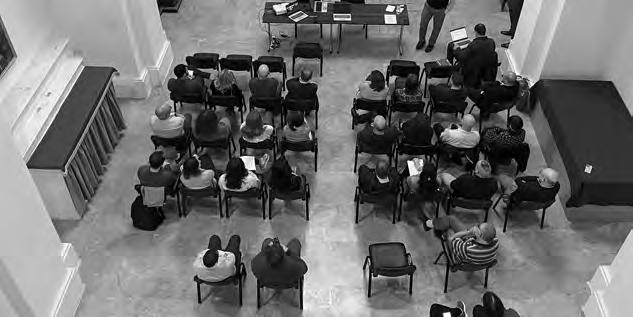
18
Today we started evaluating our performance in 2022 and discussed the progress in reaching our targets for this year. This exercise was split into two sessions, the second one was held in June.
25
The last visit of a series of visits by Year 10 students from different colleges across Malta and Gozo. Students choosing history as an option have had the opportunity of discovering more about the Archives and to practice research using primary sources. These visits were organised in collaboration with the Education Division.
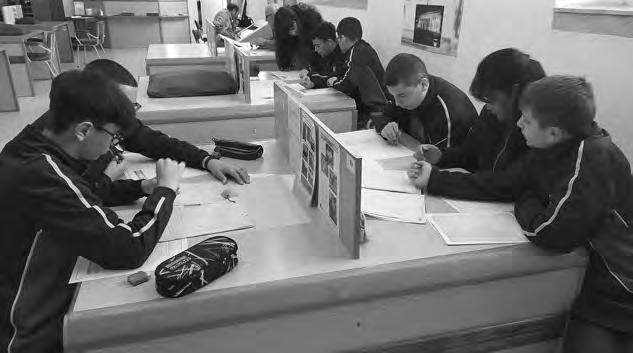

31
29
Exploring shared Mediterranean roots. We hosted students from the Lycée International Victor Hugo in Djerba, Tunisia. Together we analysed a number of passport applications submitted by Maltese persons intent on emigrating to Tunisia some 100 years ago as well other records related to the relationship between our countries.
We participated in the exhibtion Shemà at the Gozo Bishop’s Curia organised as part of the Lejl Imdawwal event. From the Gozo Archive we have lent an anonymous record of St John’s gospel in Maltese that goes back to the first have of the 19th century. The record includes the Latin Vulgate version, Archbishop Marini’s italian translation, Cannolo’s Maltese version (1822) and an updated Maltese version. Cannolo’s St John’s gospel is the earliest printed bible text in Maltese and was commissioned by members of the Protestant Church.

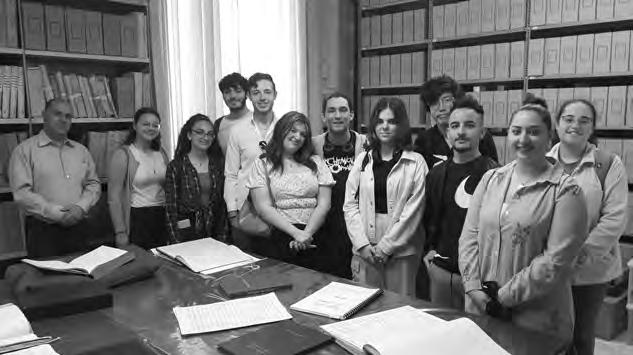
Music students from Junior College together with their tutor, Mro Manoel Pirotta, visited the Courts and Tribunals Archive in Mdina. They were shown the Charles Camilleri and Frank Vassallo music collections as well as other music manuscripts.
An exhibtion commemorating the 250 anniversary since the death of Francesco Zahra, organised by Fondazzjoni Belt Victoria, was inaugurated at Il Ħaġar (Rabat, Gozo). Zahra’s will in front of Notary Ignazio Saverio Bonavita, that forms part of the Notarial Registers Archive, was exhibited.

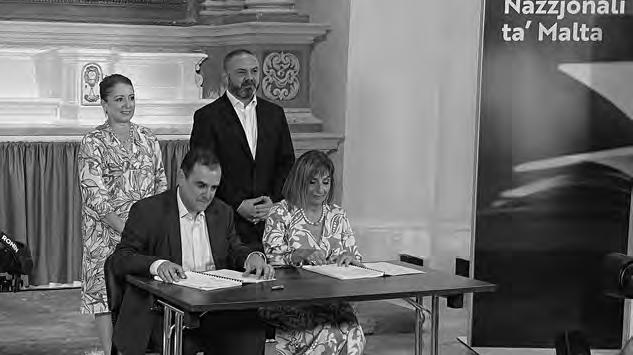
27
We signed an agreement with the Notarial Archives Foundation whereby the Foundation will manage the Notarial Registers Archive within the National Archives of Malta. We thank the Foundation for their commitment and work and look forward towards a succesful partnership that will further strenghten this archive.
The Omudsman, Justice Emeritus Joseph Zammit McKeon visited the National Archives. During the visit we signed the retention policy that guides the management of records generated by his Office. We appreciated his comments about the importance of the National Archives as a democratic instrument that is essential for an accountable and transparent administration.



Eimantė Vaicekauskienė and Anželika Girdžiutė from Lithuania completed a three week internship at the Courts and Tribunals Archive in Mdina. Their contribution to the Archive includes paginating several volumes and digitising part of the Mro Frank Vassallo collection.
16
The Economic Policy Department records were opened for research. These 2,016 files cover Malta’s economic development during the first 16 years following Independence (up to 1980). They include a wealth of information to economists, researchers, students and interested persons.
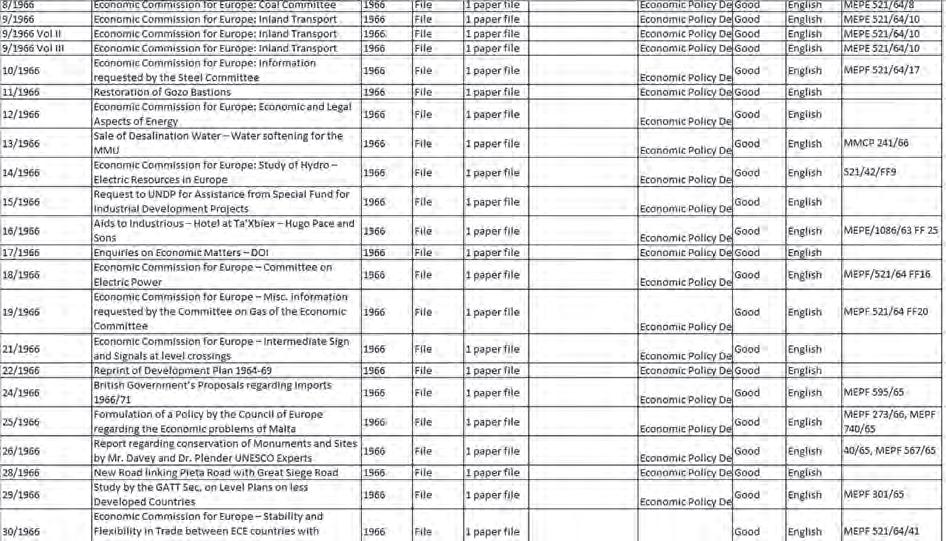

We hosted Franciscan Conventual Friars with whom we share a particular relationship. One of their convents is a neighbour of ours and 650 years ago these Friars managed the Santu Spirtu hospital in Rabat (then Ospedale San Francesco) that today is our Head Office.
Maryann Gauci and Rebecca Murray donated the records of their father to the National Archives. Ambassador Victor J Gauci (1931 2018) joined the diplomatic service during Malta’s Independence period. He played central role when Malta was elected in the United Nations Security Council in 1983/1984 and represented Malta in the Conference on Security and Co operation in Europe. He served as Ambassador for Malta in China and High Commissioner in Australia. He retired in 1996. Besides matters related to his diplomatic activity, these records include the manuscript of his book ‘Insights into Sliema’.

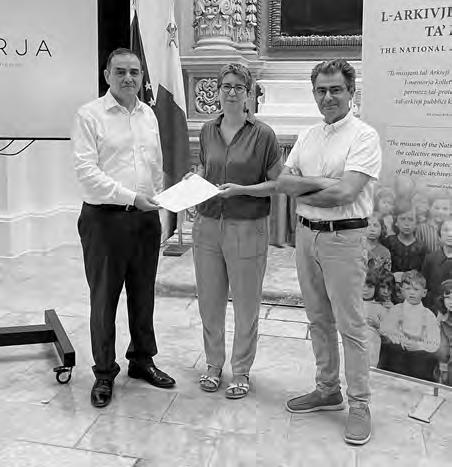

Marcia Grima and Maria Rosaria Zammit Abouzid, whom we trained in oral history, donated interviews they had carried out to our MEMORJA project. Such contributions are crucial in creating a network of experiences and memories that form our social history and public memory.
31
Conservator Aurora Belli ended her employment with the National Archives. Recalling the beautiful experiences we have shared, we thanked her and wished her success.


28
Steven Mallia donated a copy of his book The History of Water Conservation on the Maltese Island and published by Il-Ġibjun to the National Archives’ reference library. Archival research has been a major element for production of this book. A number of archives are cited, among which the extensive records collections on the subject matter held at the National Archives.
The Malta Thalidomide Survivors Association launched the book The Malta Thalidomide Affair at our main building in Rabat. Besides assisting with archival material from the National Archives, we are collaborating with the Malta Thalidomide Survivors Association within our Project MEMORJA to gather and record the experiences of the persons impacted by this drug.

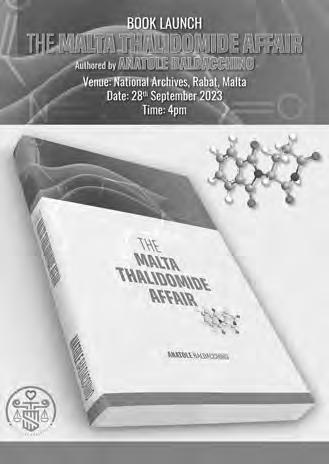
30
The exhibition In Search of Line, created by the Fondazzjoni Patrimonju Malti together with the Victor Pasmore Gallery was inaugurated. We have contributed by lending a record from the Notarial Registers Archive to included in this exhibition held at Dar L Ewropa, St Paul’s Street Valletta.
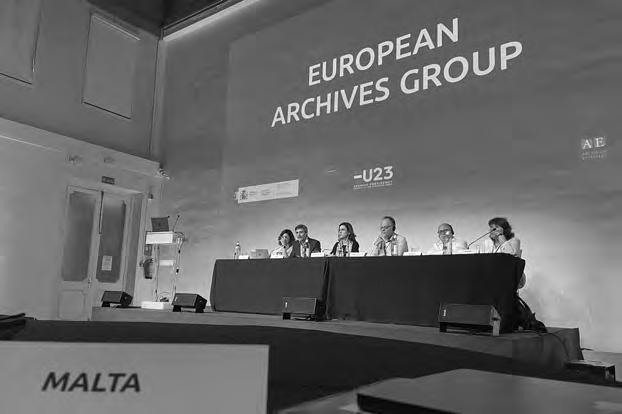
18
We met in Madrid with our colleagues from the European National Archives for our six monthly meeting so that, together with the European Commission, we discuss our situation as well as the challenges and opportunities we are facing, This time we foucused on the opportunities and issues ushered by Artificial Intelligence.
We participated in the Malta Book Festival at the Malta Fairs & Conventions Centre in Ta’ Qali between 18 and 22 October. This year we have created a larger stand than usual and developed several opportunities to interact with the visitors.

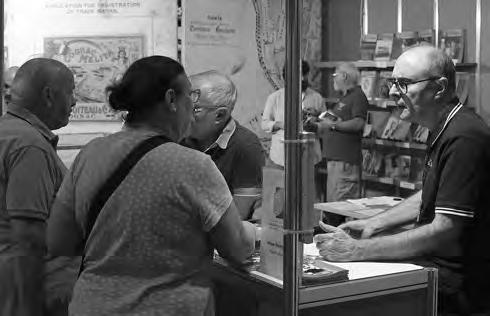

26
We bid farewell to our colleague Jamie Zerafa who will be leaving us. Recalling the beautiful moments we have shared, we wish him the best. All the best Jamie.

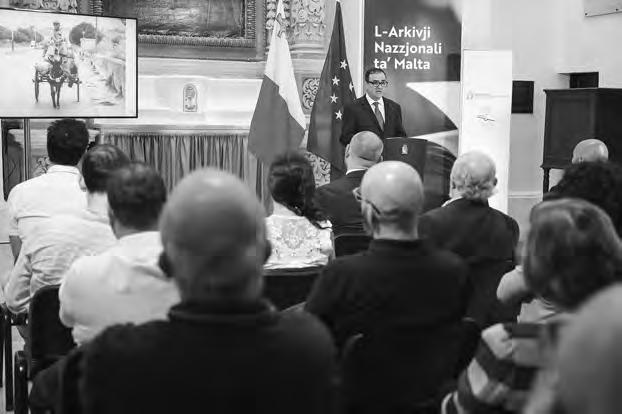
On the World Audiovisual Heritage Day we celebrated a joint project between the National Archives and The Times of Malta. The latter has transferred its photo collection (physical positives and negatives) to the National Archives that is preserving, digitising and cataloguing this collection that runs into hundreds of thousands of photos. 28

On the 75th anniversary (30 October 1948) of the drowning of 23 persons at Taċ Ċawl off the Qala coast, the Gozo Archive set up a commemorative exhibition of original documents, rare photos and artefacts associated with the tragedy. The exhibition was sponsored by the Gozo Regional Development Authority.
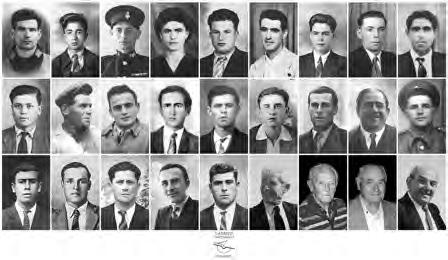
Doreen Curmi and Louise Zammit La Rosa, grand daughters of Arthur Rizzo Marich, who was the last owner of the V. Marich and Co., donated records pertaining to this business to the National Archives. Operating from 44, Strada Teatro, Valletta, Messrs V. Marich & Co. were one of the oldest manufacturers of hand made cigarettes as well as cigar and tobacco merchants, exporting tobacco products to several counties. This business was not just any shop but also a smoking divan and a popular rendezvous point for Maltese gentry, naval and military senior officers.
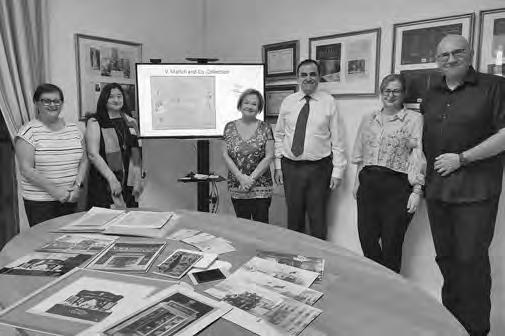
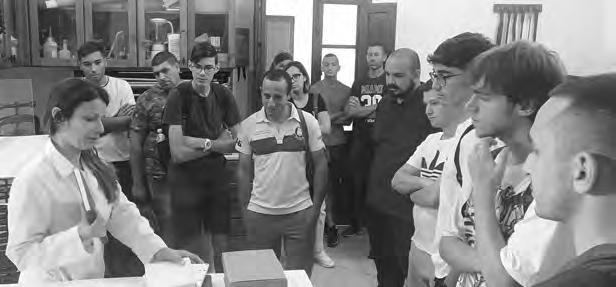
13
The Executive Chairperson and staff members of the National Book Council visited the National Archives. We signed the retention policy for the records being created and managed by the National Book Council and their future transfer to the National Archives for permanent preservation. Following the signing of the retention policy the guests were given a tour of the various sections and operations within the Archives.
12
We welcomed MCAST students reading for a Higher Diploma in Masonry Heritage Skills. Apart from general information regarding the National Archives of Malta, the students experienced how research is carried out using our collections.

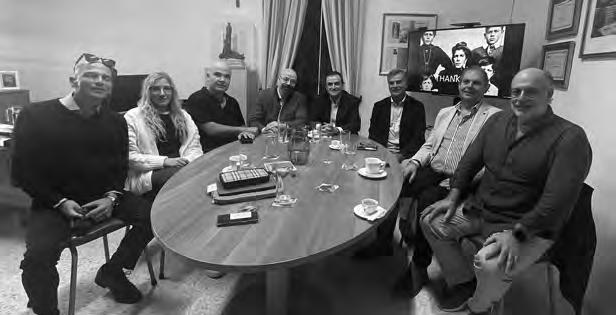
The staff of the Ministry for the National Heritage, the Arts and Local Government visted the Archives. Besides informing them of our work, we discussed several projects that we are undertaking and thanked them for their support and assistance.
We hosted the Board of Directors of Ancestry, one of the largest global genealogy companies operating a network of genealogical, historical records and related genetic genealogy websites. We discussed avenues of collaboration.
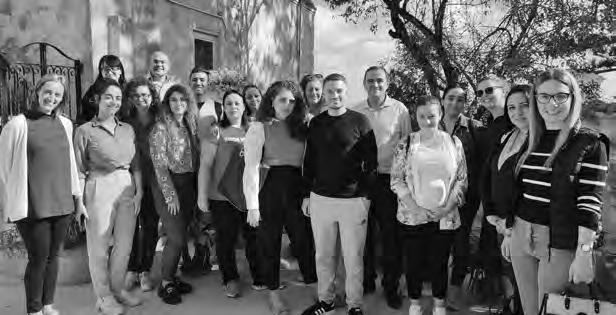
23
The refurbished Notarial Registers Archive within the National Archives of Malta was inaugurated following an EU funded restoration project. We thank the Notary to Government and the Restoration Directorate for their crucial input towards the restoration project. We thank the Notarial Archives Foundation for thir contribution towards this archive, both to date as well as for the future as they have been entrusted with the management of this archive.

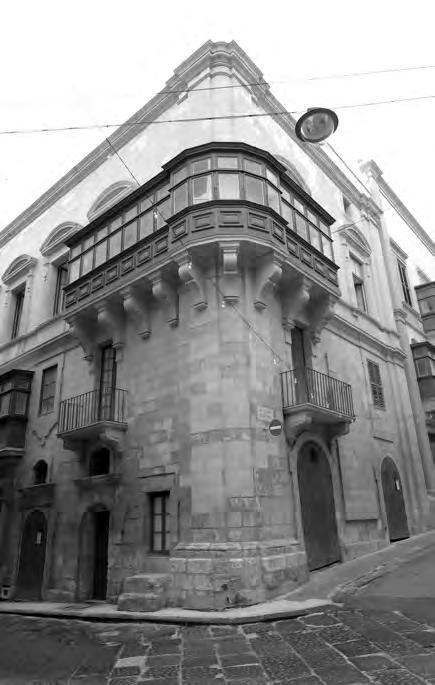
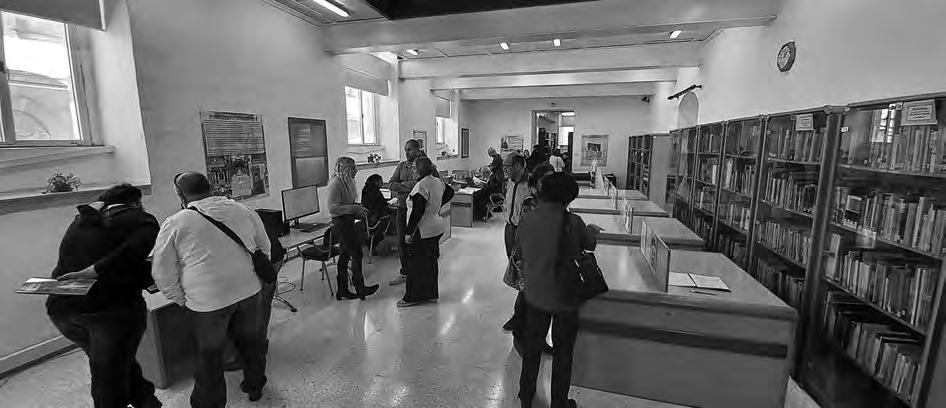
Open Day
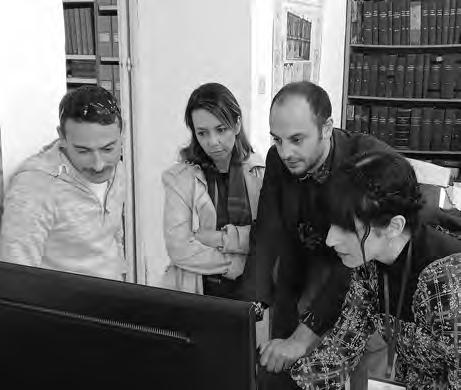

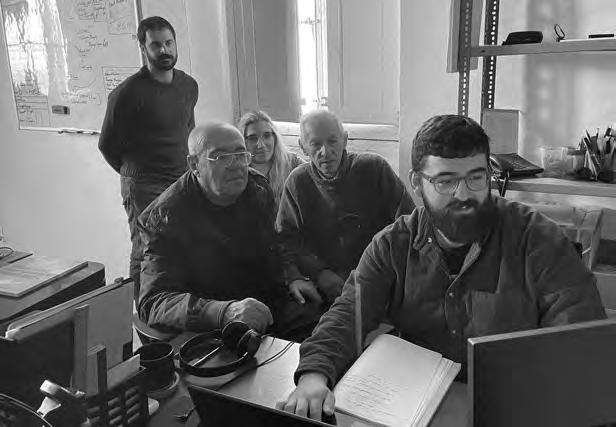
We met with Lawrence Ancilleri and Sammy Meilaq. Lawrence has conducted a number of interviews with Sammy Meilaq covering his life experiences: his childhood and adolescence, work with Socialist associations and his career at the Malta’s Dockyard. The interviews were deposited at the National Archives of Malta as part of the MEMORJA project. Mr Ancilleri has also deposited 121 audio recordings consisting of of oral history interviews, discussions, public events and radio programmes. The main topic of these recordings is Dominic Mintoff with a focus on the Government crisis of 1998.

Students reading for an MSc in Conservation of Decorative Architectural Surfaces at the University of Malta visited our Central Archive in Rabat. During this visit we exchanged views of the value and contribution of the National Archives in their studies.
30
MCAST students reading for an Advanced Diploma in Cultural Heritage Skills had a hands on experience of case binding our Conservation Laboratory.


Simon Cusens deposited a unique collection of records related to Operation Pedestal (Santa Maria’s Convoy) at the National Archives. These records include unique material related to this seminal event in the Maltese experience during WW2, such as hundreds of hours of footage and interviews with persons involved, both from the Allies as well as the Axis, documentaries, photos and other archival material. 7
Students following a course in Public Administration at the Public Policy Department (University of Malta) visited the Central Archive and the Courts and Tribunals Archive. During this visit we exchanged views of the value and contribution of the National Archives both in in their studies as well as to society in general.
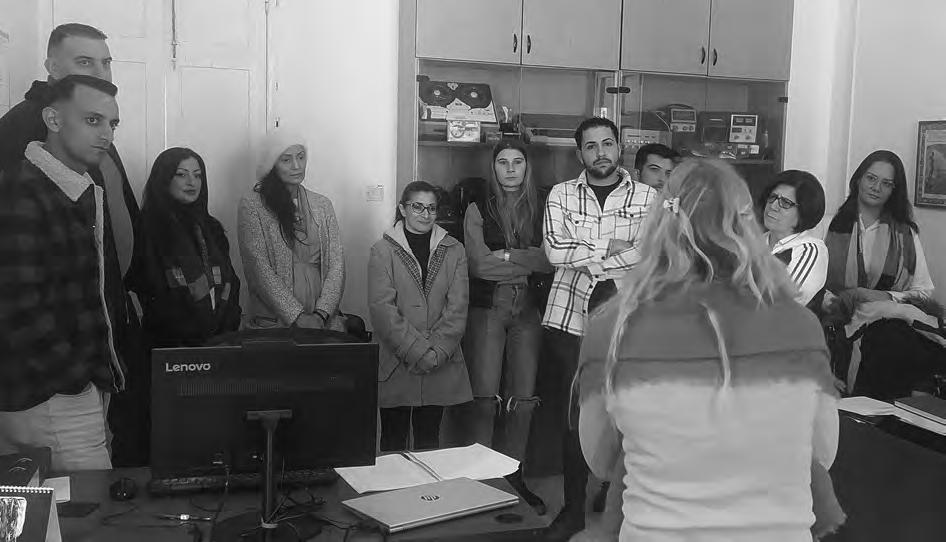

Ana Marie Barzaghideanu and Claudia Gabriela Alucai, students from Alexandru Ioan Cuza University in Romania, completed a traineeship at our Conservation Laboratory within the Erasmus programme. During their stay, Anna Marie and Claudia Gabriela worked on various conservation and preservation projects.
15
We were honoured to host the Auditor General and officials from the National Audit Office. We discussed the mission and operations of the National Archives as an instrument to protect memory, identity and the citizen’s rights.

National Archives of Malta Unaudited Financial Statements – 31 December 2023
Statement of financial position
Statement of financial position
ASSETS
Non-current assets
Property, plant and equipment
Intangible asset
Archival Holdings Acquisition
Right-of-use asset
Total non-current assets
Current assets
Trade and other receivables
Cash and cash equivalents
Total current assets
Total assets
EQUITY AND LIABILITIES
Equity
Accumulated fund
payables
Total non-current liabilities Current liabilities Trade and other payables
Finance lease obligation
Total current liabilities Total liabilities Total equity and liabilities 1,255,652 1,111,968
Theaccompanyingnotesareanintegralpartofthesefinancialstatements.
The accompanying notes areanintegralpart of thesefinancialstatements.
The accompanying notes areanintegralpart of thesefinancialstatements.
Deficit from operations
Cash flows used in investing activities Acquisition of property, plant and equipment
Net cash used in investing activities
Cash flows from financing activities Receipt from Grants Payments of Interest classified as financing
Net cash used in/ generated from financing activities
Net decrease in cash and cash equivalents
Cash
Theaccompanyingnotesareanintegralpartofthesefinancialstatements.
1 Basis of preparation
1.1 Basis of measurement and statement of compliance
ThesefinancialstatementsoftheNationalArchivesofMalta(the“Entity”)havebeen preparedandpresentedinaccordancewiththeInternationalFinancialReporting StandardsasadoptedbytheEU(“IFRSs”).
ThepreparationoffinancialstatementsinconformitywithIFRSsrequirestheuseof certaincriticalaccountingestimates.ItalsorequirestheArchivisttoexercisehis judgementintheprocessofapplyingtheEntity’saccountingpolicies(Note4Criticalaccountingestimatesandjudgements).
Thesefinancialstatementshavebeenpreparedunderthehistoricalcostconvention.
1.2Functionalandpresentationcurrency
ThefinancialstatementsarepresentedinEuro,whichistheEntity’sfunctional currency.
Theprincipalaccountingpoliciesappliedinthepreparationofthesefinancial statementsaresetoutbelow.Thesepolicieshavebeenconsistentlyappliedtoall yearspresented,unlessotherwisestated.
Thecostofanitemofproperty,plantandequipmentisrecognisedasanassetwhen itisprobablethatthefutureeconomicbenefitsthatareassociatedwiththeasset willflowtotheentityandthecostcanbemeasuredreliably.Property,plantand equipmentareinitiallymeasuredatcostcomprisingthepurchaseprice,anycosts directlyattributabletobringingtheassetstoaworkingconditionfortheirintended use,andtheinitialestimateofthecostsofdismantlingandremovingtheitemand restoringthesiteonwhichitislocated.Subsequentexpenditureiscapitalisedas partofthecostofproperty,plantandequipmentonlyifitenhancesthefuture economicbenefitsofanassetinexcessofthepreviouslyassessedstandardof performance,oritreplacesorrestoresacomponentthathasbeenseparately depreciatedoveritsusefullife.Thecarryingamountofthereplacedpartis derecognised.Allotherrepairsandmaintenancearechargedtothestatementof comprehensiveincomeduringthefinancialperiodinwhichtheyareincurred.
Afterinitialrecognition,property,plantandequipmentmaybecarriedunderthe costmodel,thatisatcostlessanyaccumulateddepreciationandanyaccumulated impairmentlosses,orundertherevaluationmodel,thatisattheirfairvalueatthe dateoftherevaluationlessanyaccumulateddepreciationandanyaccumulated impairmentlosses.
Afterinitialrecognition,property,plantandequipmentarecarriedunderthecost model.
National Archives of Malta
Unaudited Financial Statements – 31 December 2023
Depreciationiscalculatedtowritedownthecarryingamountoftheassetona systematicbasisoveritsexpectedusefullife.Depreciationofanassetbeginswhen itisavailableforuseandceasesattheearlierofthedatethattheassetisclassified asheldforsale(orincludedinadisposalgroupthatisclassifiedasheldforsale)or thedatethattheassetisderecognised.Thedepreciationchargeforeachperiodis recognisedinthestatementofcomprehensiveincome.
Depreciation
2Summaryofsignificantaccountingpolicies -continued
2.1Property,plantandequipment -continued
Depreciation -continued
Depreciationiscalculatedtowritedownthecarryingamountoftheassetona systematicbasisoveritsexpectedusefullife.Depreciationofanassetbeginswhen itisavailableforuseandceasesattheearlierofthedatethattheassetisclassified asheldforsale(orincludedinadisposalgroupthatisclassifiedasheldforsale)or thedatethattheassetisderecognised.Thedepreciationchargeforeachperiodis recognisedinthestatementofcomprehensiveincome.
Depreciationonassetsiscalculatedusingthestraight-linemethodtoallocatethe costoftheassetstotheirresidualvaluesovertheirestimatedusefullivesasfollows:
2Summaryofsignificantaccountingpolicies -continued
2.1Property,plantandequipment -continued
Improvements
Depreciation -continued
Depreciationonassetsiscalculatedusingthestraight-linemethodtoallocatethe costoftheassetstotheirresidualvaluesovertheirestimatedusefullivesasfollows:
Depreciationmethod,usefullifeandresidualvalue
Thedepreciationmethodapplied,theresidualvalueandtheusefullifeare reviewedonaregularbasisandwhennecessary,revisedwiththeeffectofany changesinestimatebeingaccountedforprospectively.
Derecognitionofproperty,plantandequipment
Depreciationmethod,usefullifeandresidualvalue
Thedepreciationmethodapplied,theresidualvalueandtheusefullifeare reviewedonaregularbasisandwhennecessary,revisedwiththeeffectofany changesinestimatebeingaccountedforprospectively.
Anitemofproperty,plantandequipmentisderecognisedupondisposalorwhenno futureeconomicbenefitsareexpectedtoarisefromthecontinueduseofasset.Any gainsorlossesarisingonthedisposalorretirementofproperty,plantand equipmentaredeterminedasthedifferencebetweenthedisposalproceedsandthe carryingamountoftheassetandarerecognisedinthestatementofcomprehensive incomewithinotherincomeorotherexpenses.
Derecognitionofproperty,plantandequipment
2.2Intangibleassets
(a)Acquiredintangibleassets–computersoftware
Anitemofproperty,plantandequipmentisderecognisedupondisposalorwhenno futureeconomicbenefitsareexpectedtoarisefromthecontinueduseofasset.Any gainsorlossesarisingonthedisposalorretirementofproperty,plantand equipmentaredeterminedasthedifferencebetweenthedisposalproceedsandthe carryingamountoftheassetandarerecognisedinthestatementofcomprehensive incomewithinotherincomeorotherexpenses.
2.2Intangibleassets
Anacquiredintangibleassetisrecognisedonlyifitisprobablethattheexpected futureeconomicbenefitsthatareattributabletotheassetwillflowtotheentity andthecostoftheassetcanbemeasuredreliably.Anintangibleassetisinitially measuredatcost,comprisingitspurchasepriceandanydirectlyattributablecostof preparingtheassetforitsintendeduse.
(a)Acquiredintangibleassets–computersoftware
Intangibleassetsaresubsequentlycarriedatcostlessanyaccumulated amortisationandanyaccumulatedimpairmentlosses.Amortisationiscalculatedto writedownthecarryingamountoftheintangibleassetusingthestraight-line methodoveritsexpectedusefullife.Amortisationofanassetbeginswhenitis availableforuseandceasesattheearlierofthedatethattheassetisclassifiedas heldforsale(orincludedinadisposalgroupthatisclassifiedasheldforsale)or thedatethattheassetisderecognised.
Anacquiredintangibleassetisrecognisedonlyifitisprobablethattheexpected futureeconomicbenefitsthatareattributabletotheassetwillflowtotheentity andthecostoftheassetcanbemeasuredreliably.Anintangibleassetisinitially measuredatcost,comprisingitspurchasepriceandanydirectlyattributablecostof preparingtheassetforitsintendeduse.
Theamortisationofcomputersoftwareisbasedonausefullifeof3yearsandis chargedtothestatementofcomprehensiveincome.
National Archives of Malta
Unaudited Financial Statements – 31 December 2023
amortisationandanyaccumulatedimpairmentlosses.Amortisationiscalculatedto writedownthecarryingamountoftheintangibleassetusingthestraight-line methodoveritsexpectedusefullife.Amortisationofanassetbeginswhenitis availableforuseandceasesattheearlierofthedatethattheassetisclassifiedas heldforsale(orincludedinadisposalgroupthatisclassifiedasheldforsale)or thedatethattheassetisderecognised.
Theamortisationofcomputersoftwareisbasedonausefullifeof3yearsandis chargedtothestatementofcomprehensiveincome.
ArchivalHoldingsacquiredbytheNationalArchivesarecapitalisedand recognisedinthestatementoffinancialpositionattheircostatthedateof acquisition.Thecostofapurchasedarchivalholdingcomprisesitspurchaseprice andanydirectlyattributableexpendituresuchaslegalandprofessionalfeesand othertransactioncosts.Afterinitialrecognition,theseholdingsarecarriedattheir costandnotdepreciated,astheholdingsareconsideredtobeofculturalor historicalvalueworthpreservingperpetually,andtheArchivisthasthe technologicalandfinancialabilitytopreserveandprotecttheassets’service potentialandisdoingso.Theseassetscannotbereplacedorreconstructed thereforenomarketvaluecantrulyreflecttheassets’valuetothenation’sheritage.
2 Summary of significant accounting policies - continued
2.4
TheEntity’sproperty,plantandequipmentaretestedforimpairment.
ThecarryingamountsoftheEntity’sproperty,plantandequipmentarereviewedat eachstatementoffinancialpositiondatetodeterminewhetherthereisany indicationofimpairment.Ifanysuchindicationexists,theasset’srecoverable amountisestimated.Therecoverableamountofanassetisthehigherofitsfair valuelesscoststosellanditsvalueinuse.
Wheneverthecarryingamountofanassetexceedsitsrecoverableamount,an impairmentlossisrecognisedandthecarryingamountoftheassetisreducedtoits recoverableamount.Impairmentlossesarerecognisedimmediatelyinthe statementofcomprehensiveincome,unlesstheyrelatetoanassetwhichiscarried atrevaluedamount,inwhichcasetheyaretreatedasarevaluationdecreasetothe extentthattheimpairmentlossdoesnotexceedtheamountintherevaluation surplusforthatasset.
ThecarryingamountsofEntity’sassetsarealsoreviewedateachstatementof financialpositiondatetodeterminewhetherthereisanyindicationthatan impairmentdeficitrecognisedinpriorperiodsmaynolongerexistormayhave decreased.Ifanysuchindicationexists,theasset’srecoverableamountis estimated.Animpairmentdeficitpreviouslyrecognisedisreversedonlyiftherehas beenachangeintheestimatesusedtodeterminetheasset’srecoverableamount sincethelastimpairmentlosswasrecognised.Whenanimpairmentloss subsequentlyreverses,thecarryingamountoftheassetisincreasedtotherevised estimateofitsrecoverableamount,totheextentthatitdoesnotexceedthe carryingamountthatwouldhavebeendeterminedhadnoimpairmentlossbeen recognisedfortheassetinprioryears.Impairmentreversalsarerecognised immediatelyinthestatementofcomprehensiveincome,unlesstheyrelatetoan assetwhichiscarriedatrevaluedamount,inwhichcasetheyaretreatedasa revaluationincreaseunlessanimpairmentlossonthesameassetwaspreviously recognisedinthestatementofcomprehensiveincome.
2.5 Financial instruments
2.5.1 Recognition and initial measurement
National Archives of Malta Unaudited Financial Statements – 31 December 2023
carryingamountthatwouldhavebeendeterminedhadnoimpairmentlossbeen recognisedfortheassetinprioryears.Impairmentreversalsarerecognised immediatelyinthestatementofcomprehensiveincome,unlesstheyrelatetoan assetwhichiscarriedatrevaluedamount,inwhichcasetheyaretreatedasa revaluationincreaseunlessanimpairmentlossonthesameassetwaspreviously recognisedinthestatementofcomprehensiveincome.
carryingamountthatwouldhavebeendeterminedhadnoimpairmentlossbeen recognisedfortheassetinprioryears.Impairmentreversalsarerecognised immediatelyinthestatementofcomprehensiveincome,unlesstheyrelatetoan assetwhichiscarriedatrevaluedamount,inwhichcasetheyaretreatedasa revaluationincreaseunlessanimpairmentlossonthesameassetwaspreviously recognisedinthestatementofcomprehensiveincome.
2.5 Financial instruments
2.5 Financial instruments
2.5.1 Recognition and initial measurement
2.5.1 Recognition and initial measurement
Tradereceivablesissuedareinitiallyrecognisedwhentheyareoriginated.Allother financialassetsandfinancialliabilitiesareinitiallyrecognisedwhentheEntity becomesapartytothecontractualprovisionsoftheinstrument.
Tradereceivablesissuedareinitiallyrecognisedwhentheyareoriginated.Allother financialassetsandfinancialliabilitiesareinitiallyrecognisedwhentheEntity becomesapartytothecontractualprovisionsoftheinstrument.
On initial recognition, a financial asset is classified as measured at: amortised cost; FVOCI – debt investment; FVOCI – equity investment; or FVTPL.
Afinancialasset(unlessitisatradereceivablewithoutasignificantfinancing component)orfinancialliabilityisinitiallymeasuredatfairvalueplusorminus,for anitemnotatFVTPL,transactioncoststhataredirectlyattributabletoits acquisitionorissue.Atradereceivablewithoutasignificantfinancingcomponentis initiallymeasuredatthetransactionprice.
Afinancialasset(unlessitisatradereceivablewithoutasignificantfinancing component)orfinancialliabilityisinitiallymeasuredatfairvalueplusorminus,for anitemnotatFVTPL,transactioncoststhataredirectlyattributabletoits acquisitionorissue.Atradereceivablewithoutasignificantfinancingcomponentis initiallymeasuredatthetransactionprice.
Financial assets are not reclassified subsequent to their initial recognition unless the Entity changes its business model for managing financial assets, in which case all affected financial assets are reclassified on the first day of the first reporting period following the change in the business model.
2.5.2 Classification and subsequent measurement
2.5.2 Classification and subsequent measurement
A financial asset is measured at amortised cost if it meets both of the following conditions and is not designated as at FVTPL:
(i)Financialassets
(i)Financialassets
On initial recognition, a financial asset is classified as measured at: amortised cost; FVOCI – debt investment; FVOCI – equity investment; or FVTPL.
2Summaryofsignificantaccountingpolicies -continued
2.4Financialinstruments -continued
Financial assets are not reclassified subsequent to their initial recognition unless the Entity changes its business model for managing financial assets, in which case all affected financial assets are reclassified on the first day of the first reporting period following the change in the business model.
2.4.2Classificationandsubsequentmeasurement– continued
(i)Financialassets- continued
A financial asset is measured at amortised cost if it meets both of the following conditions and is not designated as at FVTPL:
•itisheldwithinabusinessmodelwhoseobjectiveistoholdassetstocollect contractualcashflows;and
2Summaryofsignificantaccountingpolicies -continued
•itscontractualtermsgiveriseonspecifieddatestocashflowsthataresolely paymentsofprincipalandinterestontheprincipalamountoutstanding.
2.4Financialinstruments -continued
(ii)Financialassets–Businessmodelassessment
2.4.2Classificationandsubsequentmeasurement– continued
(i)Financialassets- continued
TheEntitymakesanassessmentoftheobjectiveofthebusinessmodelinwhicha financialassetisheldataportfoliolevelbecausethisbestreflectsthewaythe businessismanagedandinformationisprovidedtomanagement.Theinformation consideredincludes:
•itisheldwithinabusinessmodelwhoseobjectiveistoholdassetstocollect contractualcashflows;and
•itscontractualtermsgiveriseonspecifieddatestocashflowsthataresolely paymentsofprincipalandinterestontheprincipalamountoutstanding.
(ii)Financialassets–Businessmodelassessment
• thestatedpoliciesandobjectivesfortheportfolioandtheoperationofthose policiesinpractice.Theseincludewhethermanagement’sstrategyfocuseson earningcontractualinterestincome,maintainingaparticularinterestrate profile,matchingthedurationofthefinancialassetstothedurationofany relatedliabilitiesorexpectedcashoutflowsorrealisingcashflowsthroughthe saleoftheassets;
TheEntitymakesanassessmentoftheobjectiveofthebusinessmodelinwhicha financialassetisheldataportfoliolevelbecausethisbestreflectsthewaythe businessismanagedandinformationisprovidedtomanagement.Theinformation consideredincludes:
• howtheperformanceoftheportfolioisevaluatedandreportedtotheEntity’s management;
• therisksthataffecttheperformanceofthebusinessmodel(andthefinancial assetsheldwithinthatbusinessmodel)andhowthoserisksaremanaged;
• basedonthefairvalueoftheassetsmanagedorthecontractualcashflows collected;and
• thefrequency,volume,andtimingofsalesoffinancialassetsinpriorperiods, thereasonsforsuchsalesandexpectationsaboutfuturesalesactivity.
• thestatedpoliciesandobjectivesfortheportfolioandtheoperationofthose policiesinpractice.Theseincludewhethermanagement’sstrategyfocuseson earningcontractualinterestincome,maintainingaparticularinterestrate profile,matchingthedurationofthefinancialassetstothedurationofany relatedliabilitiesorexpectedcashoutflowsorrealisingcashflowsthroughthe
National Archives of Malta
earningcontractualinterestincome,maintainingaparticularinterestrate profile,matchingthedurationofthefinancialassetstothedurationofany relatedliabilitiesorexpectedcashoutflowsorrealisingcashflowsthroughthe saleoftheassets;
Unaudited Financial Statements – 31 December 2023
• howtheperformanceoftheportfolioisevaluatedandreportedtotheEntity’s management;
Transfers of financialassetstothirdparties in transactionsthat donotqualifyfor derecognitionare not consideredsales forthispurpose, consistent withthe Entity’s continuing recognition ofthe assets.
• therisksthataffecttheperformanceofthebusinessmodel(andthefinancial assetsheldwithinthatbusinessmodel)andhowthoserisksaremanaged;
(iii) Financial assets - Assessment whethercontractual cash flowsare solely paymentsofprincipaland interest
• howmanagersofthebusinessarecompensated–e.g.,whethercompensationis basedonthefairvalueoftheassetsmanagedorthecontractualcashflows collected;and
• thefrequency,volume,andtimingofsalesoffinancialassetsinpriorperiods, thereasonsforsuchsalesandexpectationsaboutfuturesalesactivity.
Forthepurposesofthis assessment, ‘principal’ is definedas the fairvalue ofthe financialasset on initial recognition.‘Interest’ is definedasconsideration forthe time value ofmoneyandforthe creditriskassociated withtheprincipalamount outstandingduring a particular periodof time andforother basic lending risks and costs (e.g.,liquidity risk and administrativecosts),as well as a profit margin.
Transfers of financialassetstothirdparties in transactionsthat donotqualifyfor derecognitionare not consideredsales forthispurpose, consistent withthe Entity’s continuing recognition ofthe assets.
(iii) Financial assets - Assessment whethercontractual cash flowsare solely paymentsofprincipaland interest
In assessing whetherthe contractualcash flows aresolelypayments ofprincipal and interest, the Entityconsiders the contractualterms ofthe instrument. This includes assessing whetherthe financialasset contains a contractualtermthat could change the timing oramountof contractualcash flows suchthat it wouldnot meet thiscondition. In making this assessment, the Entityconsiders:
• contingent eventsthat would change theamountor timing of cash flows;
• termsthat may adjustthe contractual coupon rate, including variable-rate features;
Forthepurposesofthis assessment, ‘principal’ is definedas the fairvalue ofthe financialasset on initial recognition.‘Interest’ is definedasconsideration forthe time value ofmoneyandforthe creditriskassociated withtheprincipalamount outstandingduring a particular periodof time andforother basic lending risks and costs (e.g.,liquidity risk and administrativecosts),as well as a profit margin.
• prepayment and extensionfeatures; and
• termsthat limit the Entity’s claimtocash flows fromspecifiedassets(e.g. nonrecoursefeatures).
In assessing whetherthe contractualcash flows aresolelypayments ofprincipal and interest, the Entityconsiders the contractualterms ofthe instrument. This includes assessing whetherthe financialasset contains a contractualtermthat could change the timing oramountof contractualcash flows suchthat it wouldnot meet thiscondition. In making this assessment, the Entityconsiders:
2 Summary of significant accounting policies - continued
• contingent eventsthat would change theamountor timing of cash flows;
2.4Financialinstruments - continued
• termsthat may adjustthe contractual coupon rate, including variable-rate features;
2.4.2Classification andsubsequent measurement – continued
• prepayment and extensionfeatures; and
• termsthat limit the Entity’s claimtocash flows fromspecifiedassets(e.g. nonrecoursefeatures).
(iii) Financial assets - Assessment whethercontractual cash flowsare solely paymentsofprincipaland interest - continued
2 Summary of significant accounting policies - continued
2.4Financialinstruments - continued
2.4.2Classification andsubsequent measurement – continued
(iii) Financial assets - Assessment whethercontractual cash flowsare solely paymentsofprincipaland interest - continued
A prepaymentfeature is consistent withthe solelypayments ofprincipaland interestcriterion if the prepayment amount substantiallyrepresents unpaid amountsofprincipaland interest ontheprincipalamountoutstanding,which may include reasonablecompensation for earlytermination ofthe contract. Additionally, for a financialassetacquiredat a discountorpremium toitscontractual par amount, a featurethatpermits or requiresprepaymentatan amount that substantiallyrepresents the contractual paramountplus accrued (butunpaid) contractualinterest (which may also include reasonablecompensation for early termination) is treatedasconsistent withthis criterion if the fairvalue ofthe prepaymentfeature isinsignificant at initial recognition.
(iv) Financial assets – Subsequent measurement andgainsand losses
Financial assets at amortisedcost
A prepaymentfeature is consistent withthe solelypayments ofprincipaland interestcriterion if the prepayment amount substantiallyrepresents unpaid amountsofprincipaland interest ontheprincipalamountoutstanding,which may include reasonablecompensation for earlytermination ofthe contract. Additionally, for a financialassetacquiredat a discountorpremium toitscontractual par amount, a featurethatpermits or requiresprepaymentatan amount that substantiallyrepresents the contractual paramountplus accrued (butunpaid) contractualinterest (which may also include reasonablecompensation for early termination) is treatedasconsistent withthis criterion if the fairvalue ofthe prepaymentfeature isinsignificant at initial recognition.
(iv) Financial assets – Subsequent measurement andgainsand losses
National Archives of Malta
Unaudited Financial Statements – 31 December 2023
amount, a featurethatpermits or requiresprepaymentatan amount that substantiallyrepresents the contractual paramountplus accrued (butunpaid) contractualinterest (which may also include reasonablecompensation for early termination) is treatedasconsistent withthis criterion if the fairvalue ofthe prepaymentfeature isinsignificant at initial recognition.
(iv) Financial assets – Subsequent measurement andgainsand losses
Financial assets at amortisedcost
Theseassetsaresubsequentlymeasuredatamortisedcostusingtheeffective interestmethod.Theamortisedcostisreducedbyimpairmentlosses.Interest income,foreignexchangegainsandlossesandimpairmentarerecognisedin surplusordeficit.Anygainorlossonderecognitionisrecognisedinsurplusor deficit.
(v)Financialliabilities–Subsequentmeasurementandgainsandlosses
FinancialliabilitiesareclassifiedasmeasuredatamortisedcostorFVTPL.A financialliabilityisclassifiedasatFVTPLifitisclassifiedasheld-for-trading,itisa derivativeoritisdesignatedassuchoninitialrecognition.Financialliabilitiesat FVTPLaremeasuredatfairvalueandnetgainsandlosses,includinganyinterest expense,arerecognisedinsurplusordeficit.Otherfinancialliabilitiesare subsequentlymeasuredatamortisedcostusingtheeffectiveinterestmethod. Interestexpenseandforeignexchangegainsandlossesarerecognisedinsurplusor deficit.Anygainorlossonderecognitionisalsorecognisedinsurplusordeficit.
2.5.3 Derecognition
(i)Financialassets
TheEntityderecognisesafinancialassetwhen:
•thecontractualrightstothecashflowsfromthefinancialassetexpire;or
•ittransferstherightstoreceivethecontractualcashflowsinatransactionin whicheither:
- substantiallyalloftherisksandrewardsofownershipofthefinancial assetaretransferred;or
-theEntityneithertransfersnorretainssubstantiallyalloftherisksand rewardsofownershipanditdoesnotretaincontrolofthefinancialasset.
2Summaryofsignificantaccountingpolicies -continued
2.4Financialinstruments -continued
2.4.4Derecognition- continued
Transferred assets are not derecognised when the Entity enters into transactions whereby it transfers assets recognised in its statement of financial position but retains either all or substantially all of the risks and rewards of the transferred assets.
(ii)Financialliabilities
TheEntityderecognisesafinancialliabilitywhenitscontractualobligationsare dischargedorcancelledorexpire.TheEntityalsoderecognisesafinancialliability whenitstermsaremodifiedandthecashflowsofthemodifiedliabilityare substantiallydifferent,inwhichcaseanewfinancialliabilitybasedonthemodified termsisrecognisedatfairvalue.
Onderecognitionofafinancialliability,thedifferencebetweenthecarryingamount extinguishedandtheconsiderationpaid(includinganynon-cashassetstransferred orliabilitiesassumed)isrecognisedinsurplusordeficit.
2.5.4 Offsetting
National Archives of Malta Unaudited Financial Statements – 31 December 2023
Onderecognitionofafinancialliability,thedifferencebetweenthecarryingamount extinguishedandtheconsiderationpaid(includinganynon-cashassetstransferred orliabilitiesassumed)isrecognisedinsurplusordeficit.
Onderecognitionofafinancialliability,thedifferencebetweenthecarryingamount extinguishedandtheconsiderationpaid(includinganynon-cashassetstransferred orliabilitiesassumed)isrecognisedinsurplusordeficit.
2.5.4 Offsetting
2.5.4 Offsetting
Financialassetsandfinancialliabilitiesareoffset,andthenetamountpresentedin thestatementoffinancialpositionwhen,andonlywhen,theEntitycurrentlyhasa legallyenforceablerighttosetofftheamountsanditintendseithertosettlethem onanetbasisortorealisetheassetandsettletheliabilitysimultaneously.
Financialassetsandfinancialliabilitiesareoffset,andthenetamountpresentedin thestatementoffinancialpositionwhen,andonlywhen,theEntitycurrentlyhasa legallyenforceablerighttosetofftheamountsanditintendseithertosettlethem onanetbasisortorealisetheassetandsettletheliabilitysimultaneously.
TheEntityrecogniseslossallowancesforExpectedCreditLosses(ECLs)on:
TheEntityrecogniseslossallowancesforExpectedCreditLosses(ECLs)on:
• financialassetsmeasuredatamortisedcost;and
• financialassetsmeasuredatamortisedcost;and
• contractassets.
• contractassets.
TheEntityalsorecogniseslossallowancesforECLsonleasereceivables,whichare disclosedaspartoftradeandotherreceivables.
TheEntityalsorecogniseslossallowancesforECLsonleasereceivables,whichare disclosedaspartoftradeandotherreceivables.
TheEntitymeasureslossallowancesatanamountequaltolifetimeECLs,exceptfor thefollowing,whicharemeasuredat12-monthECLs:
TheEntitymeasureslossallowancesatanamountequaltolifetimeECLs,exceptfor thefollowing,whicharemeasuredat12-monthECLs:
• debtsecuritiesthataredeterminedtohavelowcreditriskatthereportingdate; and
• debtsecuritiesthataredeterminedtohavelowcreditriskatthereportingdate; and
• otherdebtsecuritiesandbankbalancesforwhichcreditrisk(i.e.,theriskof defaultoccurringovertheexpectedlifeofthefinancialinstrument)hasnot increasedsignificantlysinceinitialrecognition.
• otherdebtsecuritiesandbankbalancesforwhichcreditrisk(i.e.,theriskof defaultoccurringovertheexpectedlifeofthefinancialinstrument)hasnot increasedsignificantlysinceinitialrecognition.
Lossallowancesfortradereceivables(includingleasereceivables)andcontract assetsarealwaysmeasuredatanamountequaltolifetimeECLs.
Whendeterminingwhetherthecreditriskofafinancialassethasincreased significantlysinceinitialrecognitionandwhenestimatingECLs,theEntityconsiders reasonableandsupportableinformationthatisrelevantandavailablewithout unduecostoreffort.Thisincludesbothquantitativeandqualitativeinformation andanalysis,basedontheEntity’shistoricalexperienceandinformedcredit assessment,thatincludesforward-lookinginformation.
Lossallowancesfortradereceivables(includingleasereceivables)andcontract assetsarealwaysmeasuredatanamountequaltolifetimeECLs. Whendeterminingwhetherthecreditriskofafinancialassethasincreased significantlysinceinitialrecognitionandwhenestimatingECLs,theEntityconsiders reasonableandsupportableinformationthatisrelevantandavailablewithout unduecostoreffort.Thisincludesbothquantitativeandqualitativeinformation andanalysis,basedontheEntity’shistoricalexperienceandinformedcredit assessment,thatincludesforward-lookinginformation.
TheEntityassumesthatthecreditriskonafinancialassethasincreased significantlyifitismorethan30dayspastdue.
TheEntityassumesthatthecreditriskonafinancialassethasincreased significantlyifitismorethan30dayspastdue.
TheEntityconsidersafinancialassettobeindefaultwhen:
• thedebtorisunlikelytopayitscreditobligationstotheEntityinfull,without recoursebytheEntitytoactionssuchasrealisingsecurity(ifanyisheld);or
• thefinancialassetismorethan90dayspastdue.
TheEntityconsidersadebtsecuritytohavelowcreditriskwhenitscreditriskrating isequivalenttothegloballyunderstooddefinitionof‘investmentgrade’.TheEntity considersthistobeBaa3orhigherperMoody’sorBBB-orhigherperStandard& Poor’sandFitchscale.
2Summaryofsignificantaccountingpolicies -continued
2.5Impairmentonfinancialinstrumentsandcontractassets -continued
Lifetime ECLs are the ECLs that result from all possible default events over the expected life of a financial instrument. 12-month ECLs are the portion of ECLs that result from default events that are possible within the 12 months after the reporting date (or a shorter period if the expected life of the instrument is less than 12 months).
The maximum period considered when estimating ECLs is the maximum contractual
National Archives of Malta
Unaudited Financial Statements – 31 December 2023
2.5Impairmentonfinancialinstrumentsandcontractassets -continued
Lifetime ECLs are the ECLs that result from all possible default events over the expected life of a financial instrument. 12-month ECLs are the portion of ECLs that result from default events that are possible within the 12 months after the reporting date (or a shorter period if the expected life of the instrument is less than 12 months).
The maximum period considered when estimating ECLs is the maximum contractual period over which the Entity is exposed to credit risk.
ECLs are a probability-weighted estimate of credit losses. Credit losses are measured as the present value of all cash shortfalls (i.e. the difference between the cash flows due to the entity in accordance with the contract and the cash flows that the Entity expects to receive).
ECLs are discounted at the effective interest rate of the financial asset.
Credit-impaired financial assets
At each reporting date, the Entity assesses whether financial assets carried at amortised cost are credit-impaired. A financial asset is ‘credit-impaired’ when one or more events that have a detrimental impact on the estimated future cash flows of the financial asset have occurred.
Evidence that a financial asset is credit-impaired includes the following observable data:
• significantfinancialdifficultyofthedebtor;
• abreachofcontractsuchasadefaultorbeingmorethan90dayspastdue;
• therestructuringofaloanoradvancebytheEntityontermsthattheEntity wouldnotconsiderotherwise;
• itisprobablethatthedebtorwillenterbankruptcyoranotherfinancial reorganisation;or
• thedisappearanceofanactivemarketforasecuritybecauseoffinancial difficulties.
Loss allowances for financial assets measured at amortised cost are deducted from the gross carrying amount of the assets.
The gross carrying amount of a financial asset is written off when the Entity has no reasonable expectations of recovering a financial asset in its entirety or a portion thereof. For individual customers, the Entity has a policy of writing off the gross carrying amount when the financial asset is 180 days past due based on historical experience of recoveries of similar assets. For corporate customers, the Entity individually makes an assessment with respect to the timing and amount of writeoff based on whether there is a reasonable expectation of recovery. The Entity expects no significant recovery from the amount written off. However, financial assets that are written off could still be subject to enforcement activities in order to comply with the Entity’s procedures for recovery of amounts due.
National Archives of Malta
Unaudited Financial Statements – 31 December 2023
Loss allowances for financial assets measured at amortised cost are deducted from the gross carrying amount of the assets.
The gross carrying amount of a financial asset is written off when the Entity has no reasonable expectations of recovering a financial asset in its entirety or a portion thereof. For individual customers, the Entity has a policy of writing off the gross carrying amount when the financial asset is 180 days past due based on historical experience of recoveries of similar assets. For corporate customers, the Entity individually makes an assessment with respect to the timing and amount of writeoff based on whether there is a reasonable expectation of recovery. The Entity expects no significant recovery from the amount written off. However, financial assets that are written off could still be subject to enforcement activities in order to comply with the Entity’s procedures for recovery of amounts due.
2.7 Cash and cash equivalents
Cashandcashequivalentsarecarriedinthestatementoffinancialpositionatface value.Inthestatementofcashflows,cashandcashequivalentsincludecashin handanddepositsheldatcallwithbanks.
2 Summary of significant accounting policies - continued
2.8 Leases
Atinceptionofacontract,theEntityassesseswhetheracontractis,orcontains,a lease.Acontractis,orcontains,aleaseifthecontractconveystherighttocontrol theuseofanidentifiedassetforaperiodoftimeinexchangeforconsideration.
Asalessee
Atcommencementoronmodificationofacontractthatcontainsaleasecomponent, theEntityallocatestheconsiderationinthecontracttoeachleasecomponenton thebasisofitsrelativestand-aloneprices.However,fortheleasesofpropertythe Entityhaselectednottoseparatenon-leasecomponentsandaccountforthelease andnon-leasecomponentsasasingleleasecomponent.
TheEntityrecognisesaright-of-useassetandaleaseliabilityatthelease commencementdate.Theright-of-useassetisinitiallymeasuredatcost,which comprisestheinitialamountoftheleaseliabilityadjustedforanyleasepayments madeatorbeforethecommencementdate,plusanyinitialdirectcostsincurred andanestimateofcoststodismantleandremovetheunderlyingassetortorestore theunderlyingassetorthesiteonwhichitislocated,lessanyleaseincentives received.
Theright-of-useassetissubsequentlydepreciatedusingthestraight-linemethod fromthecommencementdatetotheendoftheleaseterm,unlessthelease transfersownershipoftheunderlyingassettotheEntitybytheendofthelease termorthecostoftheright-of-useassetreflectsthattheEntitywillexercisea purchaseoption.Inthatcasetheright-of-useassetwillbedepreciatedoverthe usefullifeoftheunderlyingasset,whichisdeterminedonthesamebasisasthose ofpropertyandequipment.Inaddition,theright-of-useassetisperiodically reducedbyimpairmentlosses,ifany,andadjustedforcertainremeasurementsof theleaseliability.
Theleaseliabilityisinitiallymeasuredatthepresentvalueoftheleasepayments thatarenotpaidatthecommencementdate,discountedusingtheinterestrate implicitintheleaseor,ifthatratecannotbereadilydetermined,theEntity’s incrementalborrowingrate.Generally,theEntityusesitsincrementalborrowing rateasthediscountrate.
National Archives of Malta
Unaudited Financial Statements – 31 December 2023
termorthecostoftheright-of-useassetreflectsthattheEntitywillexercisea purchaseoption.Inthatcasetheright-of-useassetwillbedepreciatedoverthe usefullifeoftheunderlyingasset,whichisdeterminedonthesamebasisasthose ofpropertyandequipment.Inaddition,theright-of-useassetisperiodically reducedbyimpairmentlosses,ifany,andadjustedforcertainremeasurementsof theleaseliability.
Theleaseliabilityisinitiallymeasuredatthepresentvalueoftheleasepayments thatarenotpaidatthecommencementdate,discountedusingtheinterestrate implicitintheleaseor,ifthatratecannotbereadilydetermined,theEntity’s incrementalborrowingrate.Generally,theEntityusesitsincrementalborrowing rateasthediscountrate.
TheEntitydeterminesitsincrementalborrowingratebyobtaininginterestrates fromvariousexternalfinancingsourcesandmakescertainadjustmentstoreflect thetermsoftheleaseandtypeoftheassetleased.
Leasepaymentsincludedinthemeasurementoftheleaseliabilitycomprisethe following:
• fixedpayments,includingin-substancefixedpayments;
• variableleasepaymentsthatdependonanindexorarate,initiallymeasured usingtheindexorrateasatthecommencementdate;
terminationofaleaseunlesstheEntityreasonablycertainnottoterminate early.
• amountsexpectedtobepayableunderaresidualvalueguarantee;and
• theexercisepriceunderapurchaseoptionthattheEntityisreasonablycertain toexercise,leasepaymentsinanoptionalrenewalperiodiftheEntityis reasonablycertaintoexerciseanextensionoption,andpenaltiesforearly terminationofaleaseunlesstheEntityreasonablycertainnottoterminate early.
Theleaseliabilityismeasuredatamortisedcostusingtheeffectiveinterestmethod. Itisremeasuredwhenthereisachangeinfutureleasepaymentsarisingfroma changeinanindexorrate,ifthereisachangeintheEntity’sestimateoftheamount expectedtobepayableunderaresidualvalueguarantee,iftheEntitychangesits assessmentofwhetheritwillexerciseapurchase,extension,orterminationoption orifthereisarevisedin-substancefixedleasepayment.
Whentheleaseliabilityisremeasuredinthisway,acorrespondingadjustmentis madetothecarryingamountoftheright-of-useassetorisrecordedinsurplusor deficitifthecarryingamountoftheright-of-useassethasbeenreducedtozero.
2Summaryofsignificantaccountingpolicies -continued
Theleaseliabilityismeasuredatamortisedcostusingtheeffectiveinterestmethod. Itisremeasuredwhenthereisachangeinfutureleasepaymentsarisingfroma changeinanindexorrate,ifthereisachangeintheEntity’sestimateoftheamount expectedtobepayableunderaresidualvalueguarantee,iftheEntitychangesits assessmentofwhetheritwillexerciseapurchase,extension,orterminationoption orifthereisarevisedin-substancefixedleasepayment.
2.7Leases -continued
Whentheleaseliabilityisremeasuredinthisway,acorrespondingadjustmentis madetothecarryingamountoftheright-of-useassetorisrecordedinsurplusor deficitifthecarryingamountoftheright-of-useassethasbeenreducedtozero.
Asalessee- continued
2Summaryofsignificantaccountingpolicies -continued
2.7Leases -continued
From1January2021,wherethebasisfordeterminingfutureleasepayments changedasrequiredbyinterestratebenchmarkreform,theEntityremeasuresthe leaseliabilitybydiscountingtherevisedleasepaymentsusingthereviseddiscount ratethatreflectsthechangetoanalternativebenchmarkinterestrate.
Asalessee- continued
TheEntitypresentsright-of-useassetsthatdonotmeetthedefinitionof investmentpropertyin‘right-of-useasset’andleaseliabilitiesin‘leaseliabilities’in thestatementoffinancialposition.
From1January2021,wherethebasisfordeterminingfutureleasepayments changedasrequiredbyinterestratebenchmarkreform,theEntityremeasuresthe leaseliabilitybydiscountingtherevisedleasepaymentsusingthereviseddiscount ratethatreflectsthechangetoanalternativebenchmarkinterestrate.
Short-termleasesandleasesoflow-valueassets
TheEntitypresentsright-of-useassetsthatdonotmeetthedefinitionof investmentpropertyin‘right-of-useasset’andleaseliabilitiesin‘leaseliabilities’in thestatementoffinancialposition.
TheEntityhaselectednottorecogniseright-of-useassetsandleaseliabilitiesfor leasesoflow-valueassetsandshort-termleases.TheEntityrecognisesthelease paymentsassociatedwiththeseleasesasanexpenseonastraight-linebasisover theleaseterm.
Short-termleasesandleasesoflow-valueassets
2.9 Revenue recognition
TheEntityhaselectednottorecogniseright-of-useassetsandleaseliabilitiesfor leasesoflow-valueassetsandshort-termleases.TheEntityrecognisesthelease paymentsassociatedwiththeseleasesasanexpenseonastraight-linebasisover theleaseterm.
Revenue relates to an annual subvention received from the government, additional government contributions and other subsidies. Revenue is presented net of sales’ deductions such as cash rebates, credit notes, discounts, and refunds. Revenue comprises the fair value of the consideration received or receivable in the ordinary course of the Entity’s activities. The nature and timing of satisfaction of performance obligations and significant payment terms differ between the
National Archives of Malta
Unaudited Financial Statements – 31 December 2023 leaseliabilitybydiscountingtherevisedleasepaymentsusingthereviseddiscount ratethatreflectsthechangetoanalternativebenchmarkinterestrate.
TheEntitypresentsright-of-useassetsthatdonotmeetthedefinitionof investmentpropertyin‘right-of-useasset’andleaseliabilitiesin‘leaseliabilities’in thestatementoffinancialposition.
TheEntityhaselectednottorecogniseright-of-useassetsandleaseliabilitiesfor leasesoflow-valueassetsandshort-termleases.TheEntityrecognisesthelease paymentsassociatedwiththeseleasesasanexpenseonastraight-linebasisover theleaseterm.
2.9 Revenue recognition
Revenue relates to an annual subvention received from the government, additional government contributions and other subsidies. Revenue is presented net of sales’ deductions such as cash rebates, credit notes, discounts, and refunds. Revenue comprises the fair value of the consideration received or receivable in the ordinary course of the Entity’s activities. The nature and timing of satisfaction of performance obligations and significant payment terms differ between the categories of revenue.
Amounts advanced by the Government of Malta for recurrent expenditure are made in the form of subventions from the consolidated fund in accordance with Section 20 of the National Archives Act, 2005. In accordance with the selected accounting policy these are accounted for on an accrual basis.
In 2007 an agreement was reached with the Ministry for Gozo to transfer monies from its vote to the National Archives of Malta to finance the Gozo branch’s employment costs and contribute towards its general and administrative running costs.
2.10
Governmentgrantsareassistancebygovernment,inter-governmentalagencies,and similarbodieswhetherlocal,nationalorinternational,intheformofcashor transfersofassetstotheEntityinreturnforpastorfuturecompliancewithcertain conditionsrelatingtooperatingactivitiesoftheEntity.Governmentgrantsare recognisedwhenthereisreasonableassurancethattheEntitywillcomplywiththe conditionsattachingtothemandthegrantswillbereceived.
Governmentgrantsarerecognisedintheincomestatementsoastomatchthem withtheexpendituretowardswhichtheyareintendedtocontribute.Anygrants relatingtofutureperiodsarerecognisedasdeferredincome.
Governmentgrantsrelatedtoassetsarepresentedinthestatementoffinancial positionasdeferredincome,whichisrecognisedasincomeonasystematicbasis overtheusefullifeoftheasset.
Anumberofnewstandardsareeffectiveforannualperiodsbeginningafter1 January2022andearlierapplicationispermitted;however,theEntityhasnotearly adoptedtheneworamendedstandardsinpreparingthesefinancialstatements.
ClassificationofLiabilitiesasCurrentorNon-Current(AmendmentstoIAS1)
Theamendments,asissuedin2020,aimtoclarifytherequirementsondetermining whetheraliabilityiscurrentornon current,andapplyforannualreporting periodsbeginningonorafter1January2023.However,theIASBhassubsequently proposedfurtheramendmentstoIAS1andthedeferraloftheeffectivedateofthe 2020amendmentstonoearlierthan1January2024.Duetotheseongoing developments,theEntityisunabletodeterminetheimpactoftheseamendments onthefinancialstatementsintheperiodofinitialapplication.TheEntityisclosely monitoringthedevelopments.
Thefollowingnewandamendedstandardsarenotexpectedtohaveasignificant impactontheEntity’sfinancialstatements.
• IFRS17InsuranceContractsandamendmentstoIFRS17InsuranceContracts.
• DisclosureofAccountingPolicies(AmendmentstoIAS1andIFRSPractice Statement2).
• DefinitionofAccountingEstimates(AmendmentstoIAS8).
• DeferredTaxrelatedtoAssetsandLiabilitiesarisingfromaSingleTransaction (AmendmentstoIAS12).
• IAS12:Internationaltaxreform–PilarTwomodelrules.
Estimatesandjudgementsarecontinuallyevaluatedandbasedonhistorical experienceandotherfactorsincludingexpectationsoffutureeventsthatare believedtobereasonableunderthecircumstances.
IntheopinionoftheArchivist,theaccountingestimatesandjudgementsmadein thecourseofpreparingthesefinancialstatementsarenotdifficult,subjective,or complextoadegreewhichwouldwarranttheirdescriptionascriticalintermsofthe requirementsofIAS1.
TheEntityisexposedittoavarietyoffinancialrisks:marketrisk(includingcashflow andfairvalueinterestraterisk),creditriskandliquidityrisk.TheEntity’srisk managementiscoordinatedbytheArchivistandfocusesonactivelysecuringthe Entity’sshorttomediumtermcashflowsbyminimisingtheexposuretofinancial risk.TheEntitydidnotmakeuseofderivativefinancialinstrumentstohedgecertain riskexposuresduringthecurrentandprecedingfinancialyears.
(a)Marketrisk
(i) Interestraterisk
National Archives of Malta
Unaudited Financial Statements – 31 December 2023
managementiscoordinatedbytheArchivistandfocusesonactivelysecuringthe Entity’sshorttomediumtermcashflowsbyminimisingtheexposuretofinancial risk.TheEntitydidnotmakeuseofderivativefinancialinstrumentstohedgecertain riskexposuresduringthecurrentandprecedingfinancialyears.
(a)Marketrisk
(i) Interestraterisk
TheEntityisnotsignificantlyexposedtointerestriskonitsfinancialassetsand liabilitiessincetheseareallinterestfree.
TheEntityisnotsignificantlyexposedtointerestriskonitsfinancialassetsand liabilitiessincetheseareallinterestfree.
(ii) Currencyrisk
(ii) Currencyrisk
Foreignexchangeriskarisesfromfuturecommercialtransactionsandrecognised assetsandliabilitieswhicharedenominatedinacurrencythatisnottheentity’s functionalcurrency.TheEntityisnotsignificantlyexposedtocurrencyrisksinceit hasnosignificantfinancialassetsorfinancialliabilitiesdenominatedinforeign currencies.
Foreignexchangeriskarisesfromfuturecommercialtransactionsandrecognised assetsandliabilitieswhicharedenominatedinacurrencythatisnottheentity’s functionalcurrency.TheEntityisnotsignificantlyexposedtocurrencyrisksinceit hasnosignificantfinancialassetsorfinancialliabilitiesdenominatedinforeign currencies.
5Financialriskmanagement -continued
5Financialriskmanagement -continued
(b)Creditrisk
(b)Creditrisk
Creditriskistheriskthatonepartytoafinancialinstrumentwillfailtodischargean obligationandcausetheotherpartytoincurfinancialloss.Creditriskarisesfrom cashandcashequivalents,financeleasereceivableandtradereceivables.
Creditriskistheriskthatonepartytoafinancialinstrumentwillfailtodischargean obligationandcausetheotherpartytoincurfinancialloss.Creditriskarisesfrom cashandcashequivalents,financeleasereceivableandtradereceivables.
The maximum exposure to credit risk at the reporting date in respect of the financial assets mentioned above is equivalent to their carrying amount as disclosed in the respective notes to the financial statements. The Entity does not hold any collateral as security in this respect. The amounts disclosed above in respect of trade and other receivables exclude prepayments.
(i) Cash and cash equivalents
(i) Cash and cash equivalents
The maximum exposure to credit risk at the reporting date in respect of the financial assets mentioned above is equivalent to their carrying amount as disclosed in the respective notes to the financial statements. The Entity does not hold any collateral as security in this respect. The amounts disclosed above in respect of trade and other receivables exclude prepayments.
The Entity’s cash and cash equivalents are held with local financial institutions with high quality standing or rating and are settled on demand. Management considers the probability of default to be close to zero as the financial institutions have a strong capacity to meet their contractual obligations in the near term. As a result, while cash and cash equivalents are subject to the impairment requirements of IFRS 9, the identified impairment loss is insignificant.
(ii) Trade receivables
(ii) Trade receivables
The Entity’s cash and cash equivalents are held with local financial institutions with high quality standing or rating and are settled on demand. Management considers the probability of default to be close to zero as the financial institutions have a strong capacity to meet their contractual obligations in the near term. As a result, while cash and cash equivalents are subject to the impairment requirements of IFRS 9, the identified impairment loss is insignificant.
The entity was not significantly exposed to credit risk on trade and other receivables as at reporting date.
(c)Liquidity risk
(
c)Liquidity risk
The entity was not significantly exposed to credit risk on trade and other receivables as at reporting date.
The Entity is exposed to liquidity risk in relation to meeting future obligations associated with its financial liabilities, which comprise principally of the trade and other payables. Prudent liquidity risk management includes maintaining sufficient cash and committed credit lines to ensure the availability of an adequate amount of funding to meet the Entity’s obligations.
The Entity is exposed to liquidity risk in relation to meeting future obligations associated with its financial liabilities, which comprise principally of the trade and other payables. Prudent liquidity risk management includes maintaining sufficient cash and committed credit lines to ensure the availability of an adequate amount of funding to meet the Entity’s obligations. 2022 2022
(ii) Trade receivables
National Archives of Malta Unaudited Financial Statements – 31 December 2023
The entity was not significantly exposed to credit risk on trade and other receivables as at reporting date.
The Entity is exposed to liquidity risk in relation to meeting future obligations associated with its financial liabilities, which comprise principally of the trade and other payables. Prudent liquidity risk management includes maintaining sufficient cash and committed credit lines to ensure the availability of an adequate amount of funding to meet the Entity’s obligations.
TheArchivistmonitorsliquidityriskbyreviewingexpectedcashflowsandensures thatnofinancingfacilitiesareexpectedtoberequiredoverthecomingyear.The Entity’sliquidityriskisactivelymanagedtakingcognisanceofthematchingofcash inflowsandoutflowsarisingfromexpectedmaturitiesoffinancialinstruments.In thisrespecttheArchivistdoesnotconsiderliquidityrisktotheEntityassignificant takingintoaccounttheliquiditymanagementprocessreferredtoabove.
Allfinancialliabilitiesarepayableondemandexceptfornon-currentleaseliability asdisclosedinnote13tothesefinancialstatements.
At31December2022,thecarryingamountsofcashatbank,receivablesand payablesreflectedinthefinancialstatementsarereasonableestimatesoffairvalue inviewofthenatureoftheseinstrumentsortherelativelyshortperiodtime betweentheoriginationoftheinstrumentsandtheirexpectedrealisation.Thefair valueofnon-currentleaseliabilityisnotsignificantlydifferentfromitscarrying amount. 5Financialriskmanagement –continued
The Entity's objectives when managing capital are to safeguard its ability to continue as a going concern so that it can continue to provide a service to the public by maintaining an optimal capital structure to reduce cost of capital.
The Entity's capital structure is monitored by the Archivist with appropriate reference to its financial obligations and commitments arising from operational requirements. The capital structure consists of the endowment fund and the accumulated reserves.
As at 1 January 2022
at 31 December 2022
at 1 January 2023
at 31 December 2023
at 1 January 2022
for the year
at 31 December 2022
at 1 January 2023
for the year
at 31 December 2023
2023
All archival holdings acquired since 2 June 2020 have been included in the statement of financial position at their cost or value at the date of acquisition.
The
Archives of Malta
These assets cannot be replaced or reconstructed therefore no market value can truly reflect the assets’ value to the nation’s heritage.
Right-of-use asset
The Entity has leased an asset for sixty-five years.
The table below depicts the carrying amounts of the right-of-use asset recognised and the movements during the year.
Thetablebelowdepictsthecarryingamountsofleaseliabilitiesincludedunder otherfinancialliabilitiesandmovementsduringtheyear.
Forthepurposesofthestatementofcashflows,theyear-endcashandcash equivalentscomprisethefollowing:
13Tradeandotherpayables -continued
(i)Thisamountrepresentsamountsreceivedtofinancecapitalandshallberecognised asincomeovertheusefullifeoftheasset.
13Tradeandotherpayables -continued
at the beginning of the year Funds
(Note 17
– 31
2023 16Expenses by nature Thefollowing expensesare included in cost of sales and administrativeexpenses:
18Financeexpense
19Taxation
The Entity is exempt fromthe payment ofincome tax in terms of Article12(2) ofthe income Tax Act (Cap.123) ofthe Laws of Malta.Therefore, noprovisionfor tax is provided in thesefinancialstatements.
20Relatedparties
Duringthe course of its operationsthe Entity,entered into transactions with its major stakeholder, theGovernmentof Malta throughGovernment controlledentities, and conductedbusinesswith theseentities.
Duringthe years ended 31December2022 and 2023,therewere no transactions with relatedpartiesexcept for salaryto the keymanagement personnelandthe government subventionandfunds receivedfrom the ministry ofGozo asdisclosed in Note 14.
Certaincomparativefiguresdisclosed in the main componentsofthesefinancial statementshavebeenreclassified to conform with thecurrentyear’s presentation formatforthepurposeof fairer presentation.
22 Other information
National Archives of Malta is a State-owned Entity. The Entity’s ultimate controlling party is the Government of Malta. The registered address is Head Office, Santo Spirito, Triq l-Isptar, Rabat, Malta.
DetailedStatementofComprehensiveIncome
TheSchedulesonthepagesthatfollowdonotformpartofthefinancialStatement
Forthefinancialyearended31December2023
Forthefinancialyearended31December2023
Forthefinancialyearended31December2023

